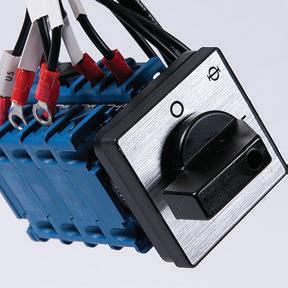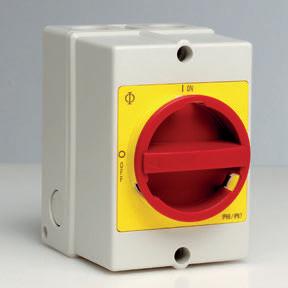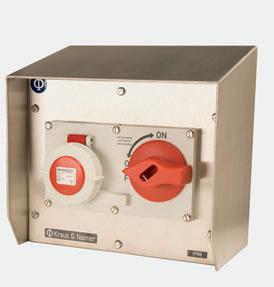





























































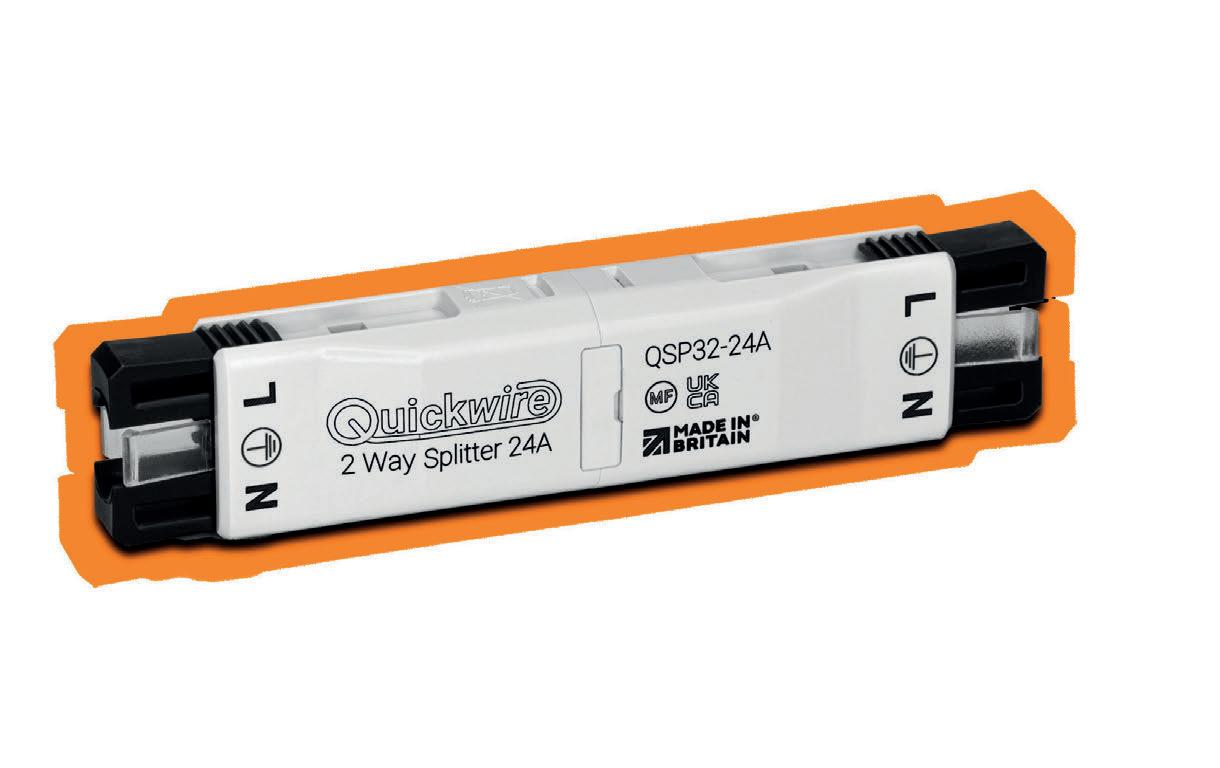
Break into ring final circuits.
Repair or extend existing cable runs.
Connect 2 spurs with the 4 way splitter.
Maintenance free.
No earth sleeving required.
Compact - Fits through a 24mm or 30mm hole.
Lightning fast QuickwireTM push in technology.

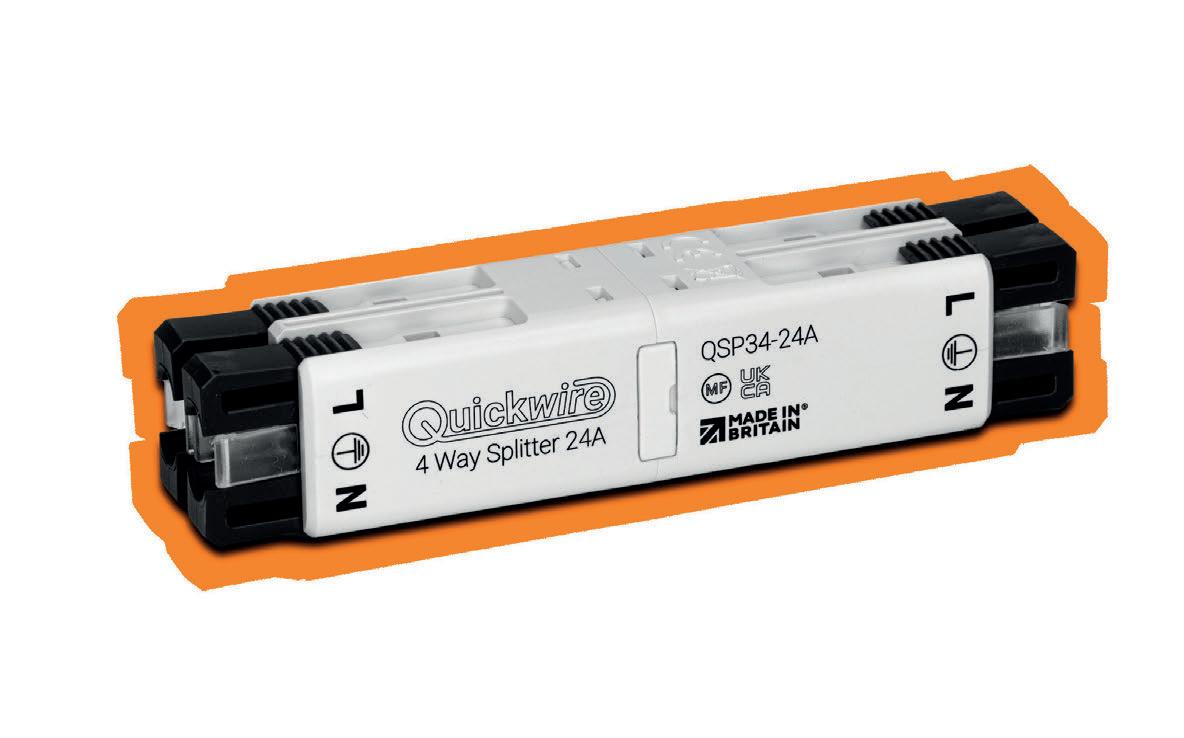




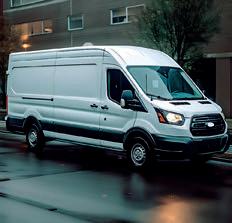

Hello and welcome to the June issue of ECN!
This month, a leading figure in the global smart building industry, Tim Miscovich, has said that cost-cutting and tradition are keeping the UK’s commercial properties “stuck in the Dark Ages” regarding smart building technology.
Tim – who is Chief Commercial Officer of wtec in the USA – made these comments prior to the Workplace Technology Conference, where he is due to speak. Tim’s company manufactures smartengine, a network-powered lighting and sensor technology that offers energy savings and sensor data to enable operators to gain a comprehensive understanding of their space.
Tim believes that the UK has been slow to adopt smart building technology due to cultural attitudes towards building methods, risk-taking and spending. In contrast, he says that the USA has widely embraced smart building technology and reaped benefits such as sustainability, cost-savings and improved comfort for building occupants.
Tim explains, “Compared to the US, I would say that when it comes to smart building technology, the UK – and in many respects, wider Europe – is, sadly, stuck in the Dark Ages.
“Linking the horizontal and vertical technologies of a building is now becoming a standard practice in the US and other parts of the world.
“Saving energy is at the heart of this. Some people think that because we drive around in big trucks in the States we’re free and easy when it comes to energy use in our buildings, but they couldn’t be more wrong, because reducing energy waste is good business and we’re all about doing things that make sense.
“The UK has made some strides, but it hasn’t got there yet.”
What do you think? Is Tim right? And if so, what can be done to bring the UK up to the same level as the USA? I’d love to hear your views at carly@allthingsmedialtd.com.
This month’s features include Cables & Connections, Smart Buildings, Tools & Test Equipment, and Commercial Vehicles. I also caught up with Wiska’s Elliott Rothon to find out more about his career so far, WISKA’s plans for the future and where he sees the industry in five years’ time.
Plus, Unicrimp is giving one lucky reader the chance to win a mix of products from across the Q-Crimp, Q-Fire and Q-Nect ranges, so don’t forget to enter!
I hope you enjoy the issue – see you next month!
GROUP EDITOR: CARLY WELLER T: 01634 673163
E: carly@allthingsmedialtd.com
DEPUTY EDITOR: SIMON ROWLEY
T: 01634 673163
E: simon@allthingsmedialtd.com
GROUP ADVERTISEMENT MANAGER:
KELLY BYNE
T: 01634 673163
E: kelly@allthingsmedialtd.com

STUDIO: MARK WELLER
T: 01634 673163
E: mark@allthingsmedialtd.com
MANAGING DIRECTOR: DAVID KITCHENER
T: 01634 673163
E: david@allthingsmedialtd.com
ACCOUNTS
T: 01634 673163
E: susan@allthingsmedialtd.com

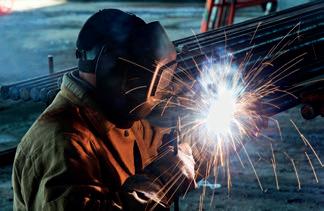
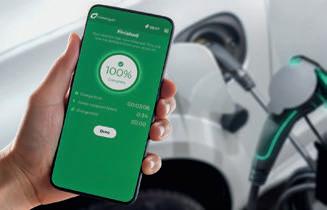



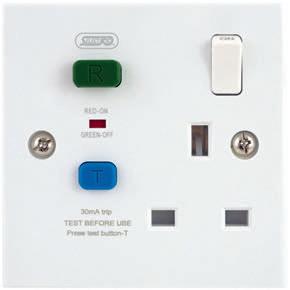





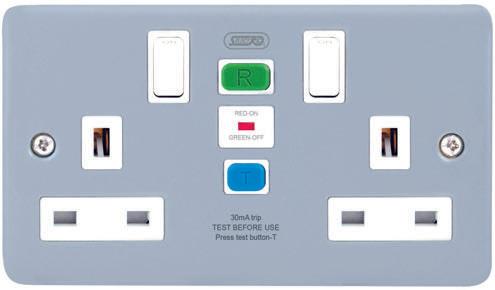



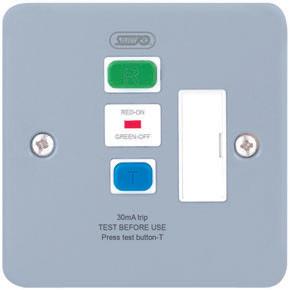

ECN is very pleased to announce that Chint has been confirmed as drinks reception sponsor at the ECN Awards 2024. The Awards will take place on 5 December 2024 at the Heart of England Conference and Events Centre in Coventry.
Chint is a global manufacturer of automation, protection and distribution equipment. As a world leading smart energy solutions provider, Chint enjoys a truly worldwide reach and is present in over 140 countries, employing more than 40,000 people.
The company has become the third largest low-voltage distribution manufacturer globally, yet it continues to offer the local service and support that its customers deserve. Chint’s UK Stockport site offers expert technical and commercial teams, providing complete solutions for domestic, commercial and industrial installations. Few can truly say they manufacture 95% of their entire product offering in-house, but Chint can, and this control enables sustained high product standards time and time again. 2023 saw the production of Chint’s first carbon net zero devices, independently verified carbon footprint declarations and internally metered smart protection devices.
“It is a great pleasure to be sponsoring the ECN Awards drinks reception,” says Haibin Zheng, Managing Director. “It promises to be a fantastic evening for all attending, and the industry as a whole.”
A new survey from the Construction Industry Collective Voice (CICV) has uncovered a significant knowledge gap among UK homeowners regarding renewable heating technologies.
Alarmingly, 59% of respondents said they lacked the necessary information to confidently transition from traditional heating systems, such as gas boilers, to heat pumps and other renewable heating options. Furthermore, only 26% of homeowners felt they possessed the requisite knowledge to make an informed decision.
These findings underscore the urgent need for enhanced public education and strategic outreach by Westminster and the devolved administrations to ensure homeowners are well-equipped to support the UK’s ambitious climate goals.
Commenting on the survey’s findings, Alan Wilson, Chair of the CICV and Managing Director of SELECT, says, “These survey findings should be seen as a wake-up call, as they highlight the significant hurdles the UK faces in modernising its home heating systems.
“Transitioning to renewable heating options involves substantial investment, even with the available grants and funding. Therefore, homeowners must be fully informed of not only the environmental benefits but also the practical advantages, such as cost-effectiveness and enhanced heating efficiency.
“Addressing this knowledge gap is precisely why the CICV created the Green Home Festival. We aim to equip homeowners with the necessary information to make informed decisions about their home heating needs and support the UK’s climate goals.”
Running from 12-16 August as a key part of the official Edinburgh Festival Fringe, the third Green Home Festival will offer free advice on a wide range of topics, from introductory information on renewable heating to advanced energy-efficient solutions.
CICV, cicvforum.co.uk

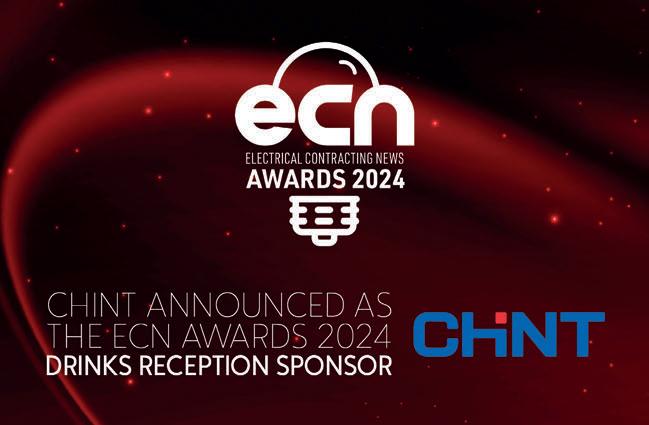
Companies in the electrical contracting industry are leading the way in innovation and are constantly striving to improve safety, efficiency and sustainability in all sectors, and ECN believes it is important to recognise their efforts and achievements. If you feel your product, company or project deserves to win an ECN Award, please enter. Entries are now open –please enter at electricalcontractingnews.com/awards-entries.
If you would like to discuss sponsorship opportunities, please contact Kelly Byne on 01634 673163.
ECN Awards, electricalcontractingnews.com/awards
On 26 May, 50 tradespeople competed at Chelsea’s Stamford Bridge stadium in the first ever Match for the Mind. Organised by IronmongeryDirect, the event raised over £4,000 for the mental health charity, Mind.
The six teams were each made up of representatives of different trades, and the tournament was eventually won by the Other Trades after beating the Electricians on penalties in the final. After finishing 1-1 in normal time, the Other Trades triumphed 7-6 in the shootout.
Bobby Funnell, playing for the Electricians, received the Golden Boot award for being the top goalscorer overall, having scored five, and was presented with a golden work boot. All players received an engraved medal.

Players were required to donate to Mind ahead of the day, and these sums were then added to the totals raised at the stadium through additional fundraising activities, such as a penalty shootout and crossbar challenge, where IronmongeryDirect gave £10 to charity for each successful effort.
In total, Match for the Mind donated over £4,000 to Mind, helping to support its vital services.
IronmongeryDirect, ironmongerydirect.co.uk
JTL has announced the winners of its Employer Recognition Awards for 2024.
The annual awards celebrate apprenticeship employers that have shown significant levels of support and commitment toward their JTL apprentices.
This year, JTL has recognised five winners amongst its large base of over 3,800 employers that it works closely with.
This year’s winners are as follows:
• Northern region – Intelect UK
• Southern region – E.W. Gee
• Eastern region – GRS Electrical Services
• Western region – Lloyd Morris Electrical
• National – Fortem Solutions
National winner, Fortem Solutions, specialises in property repairs and maintenance, delivering a total of 117,461 routine, urgent and emergency repairs between January 2023 and April 2024. The nationwide company, which has 15 locations across the UK, works closely with JTL Training Officers to ensure all aspects of the apprenticeship qualification are supported.

Chris Claydon, Chief Executive at JTL, says, “At JTL, we understand that delivering high-quality apprenticeships is a two-way street. Our success is credit to the fantastic network of employers we collaborate with across England and Wales and the winners of our 2024 Employer Recognition Awards exemplify this perfectly.
“All five winners have created exceptional learning environments for JTL apprentices, going the extra mile to support them towards their qualification completion.”
JTL, jtltraining.com
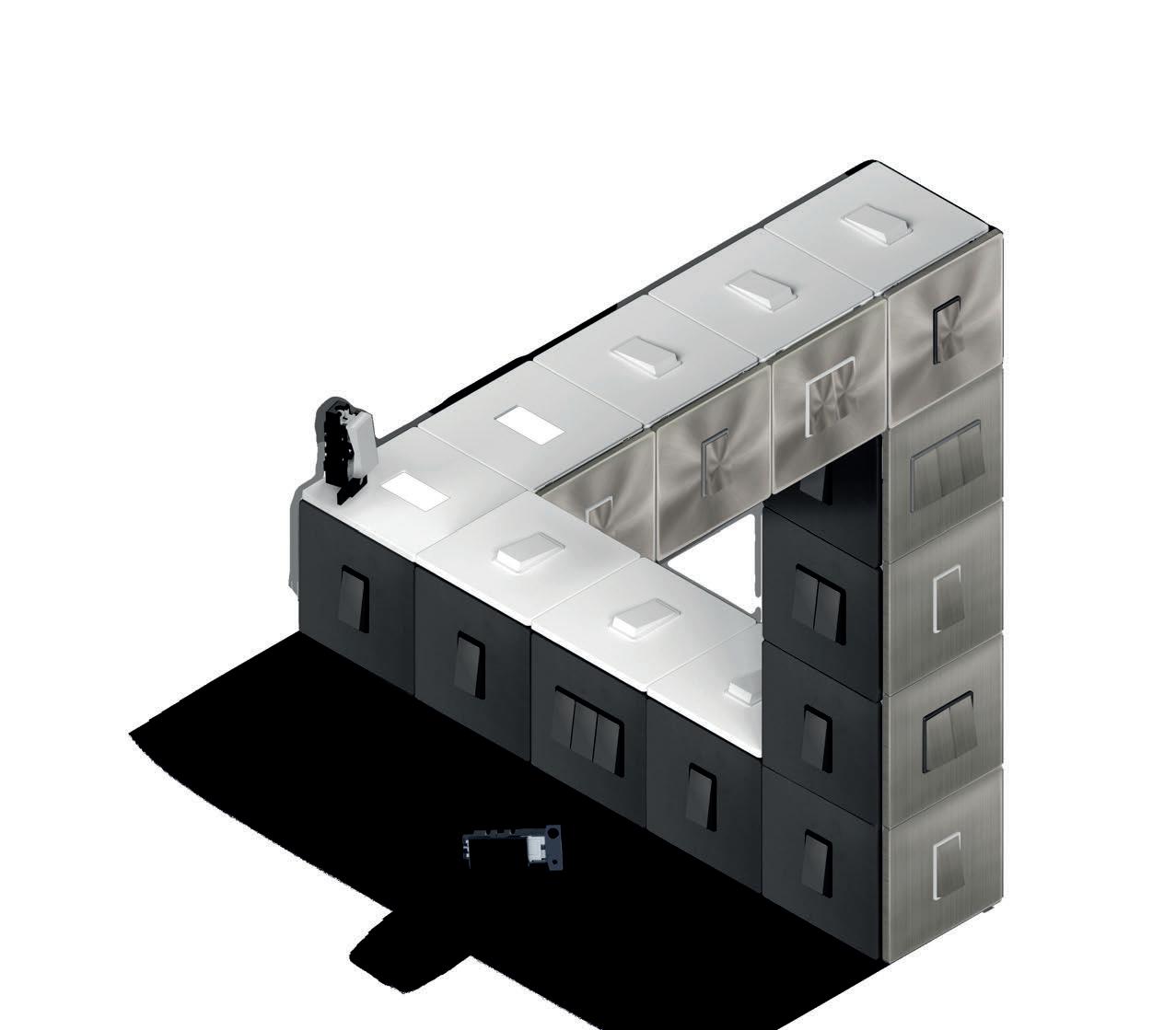
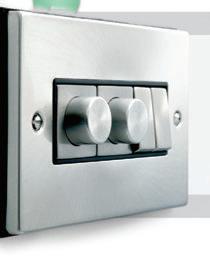




All Click switch plates are modular as standard. Our MiniGrid® range offers a vast variety of modules and endless combinations.
More than four in five (82%) UK tradespeople experience mental health problems due to work-related issues, a new study has found.
The research was commissioned for May’s Mental Health Awareness Week by IronmongeryDirect, and the results have been published in the fourth edition of the company’s annual industry report, Mental Health in the Trades
It found that more than half (56%) of tradespeople experience some form of mental health problem, such as stress, anxiety or depression, every month; and sadly, more than a quarter (27%) feel symptoms every single week. However, in more positive findings, both statistics are lower than this time last year.
Experts at Clear Amber have analysed various data sources to find the average weekly pay for different trade positions throughout the UK and determine which profession earns the most.
The top 10 highest earning trades in the UK, along with their average weekly pay are:
1. Carpenter (average weekly pay of £832)
2. Gas engineer (£735)
3. Scaffolder (£718)
4. Electrician (£679)
5. Window fitter (£657)
6. Plumber (£635)
7. Roofer (£589)
8. Bricklayer (£545)
9. Landscaper (£507)
10. Welder (£496)
Electricians rank fourth amongst the UK trade professions earning the most, boasting an average weekly pay of £679 (which is just above the UK’s average weekly pay of £677). This trade is in high demand and requires specialised skills and certifications, which experts at Clear Amber say is represented in their earnings.
Further findings reveal that traders in the East of England earn the most, with an average weekly pay of £660, including overtime; while the South East of England offers the most jobs for trade workers, with over 3,303 live job adverts on Indeed.

Once again, the ongoing cost of living crisis is the leading cause of stress, with more than a third (34%) saying it’s affecting their mental health, but this has also dropped slightly compared to the 2023 report (39%).
The rising cost of materials remains the second main stressor (32%), but new entries on the list include the poor work-life balance (24%), the physical demand of jobs (12%) and a lack of recognition (10%).
Unfortunately, despite the benefits of doing so, almost nine in 10 (88%) tradespeople don’t feel comfortable talking to others about their feelings.
Furthermore, 7% of workers worry about what their colleagues would think if they told them what they were going through.
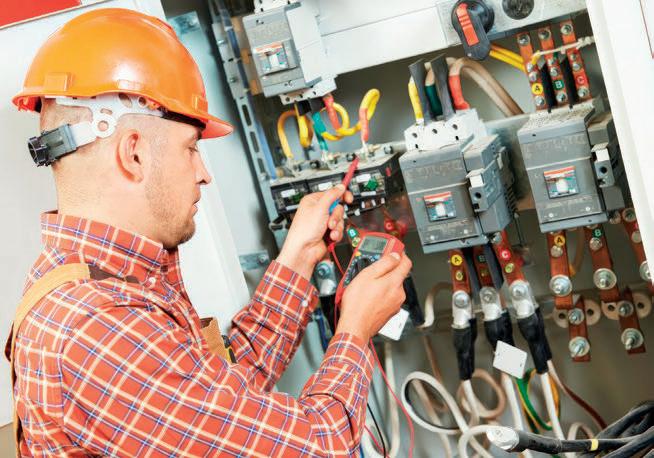
As part of its campaign to raise awareness of mental health amongst tradespeople, IronmongeryDirect has donated over £13,000 in recent years to
An instant success on its debut in 2022, Circular Lighting Live has become the defining gathering of the supply chain to assess its progress towards net zero.
The one-day conference and exhibition is organised by UK environmental compliance scheme Recolight, and Electrical Contracting News is very proud to be a media partner for this year’s event.
IronmongeryDirect, ironmongerydirect.co.uk
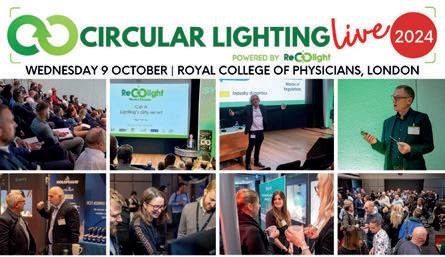
Aimed at the full supply chain, including manufacturers, suppliers and specifiers, it takes place on Wednesday 9 October 2024 at the Royal College of Physicians in London. On the agenda this year is the legislative and regulatory landscape; the role AI can play in assisting firms with data; the opportunities and challenges of the emerging lighting remanufacturing ‘ecosystem’; 3D printing; circular design and sustainable materials including bioplastics.
Speakers include Signify’s Chief Design Officer, Ton Borsboom, who will explore if AI and digitalisation represents the next revolution in sustainable design, and Orms Architect, Rachel Hoolahan, who will explain how each luminaire is set to get its own materials ‘passport’.
For 2024, there will be a more expansive exhibition floor and a dedicated track for lighting designers. In the Designer’s Track, Lighting Designer, Paul Beale, founder of 18 Degrees, will share how a decision to salvage hundreds of office lights ignited a journey to forge connections throughout the industry.
Free to specifiers, Circular Lighting Live 2024 will feature leading experts, specifiers and policy makers who will share their insights into forthcoming standards and legislation, emerging technologies and new business models.
Recolight, recolight.co.uk
myenergi has been awarded an EcoVadis bronze medal for its commitment to setting the standards in sustainable best practice.
The prestigious accolade places the Stallingborough-based company within the top 35% of all companies assessed by the framework within the past 12 months.
EcoVadis is one of the world’s largest providers of business sustainability ratings, boasting a global network of more than 130,000 rated companies. Its certifications recognise and reward companies that go above and beyond to embrace sustainable practices.
myenergi scored well across each of the four performance themes analysed –environment; labour and human rights; ethics; and sustainable procurement.
Emma Brigginshaw, Head of Sustainability and Ethics at myenergi, comments, “Being recognised by EcoVadis is a clear demonstration of our commitment to embracing sustainable best practice across the business. It affirms the robustness of our management systems and performance of our production processes.
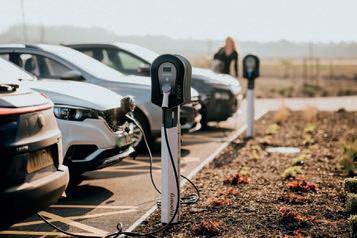
“But while a positive endorsement of our work to date, this certification is just the start. As a leader in the design and manufacture of eco-smart home energy technologies, we’re committed to holding ourselves to account and really leading the way when it comes to setting the industry standards.”
myenergi, myenergi.com

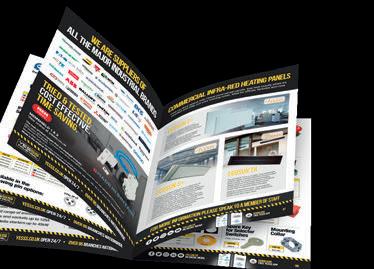


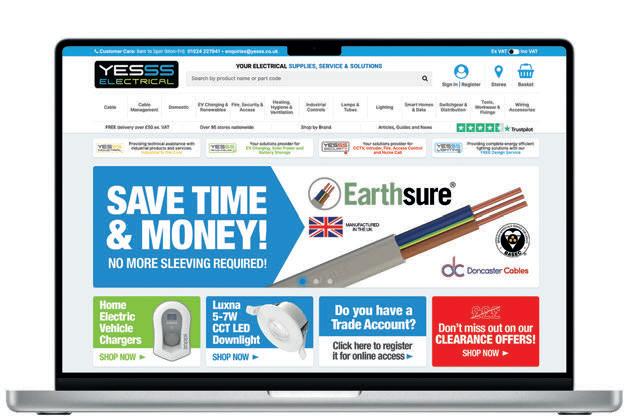

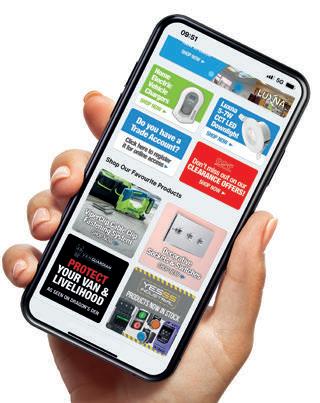
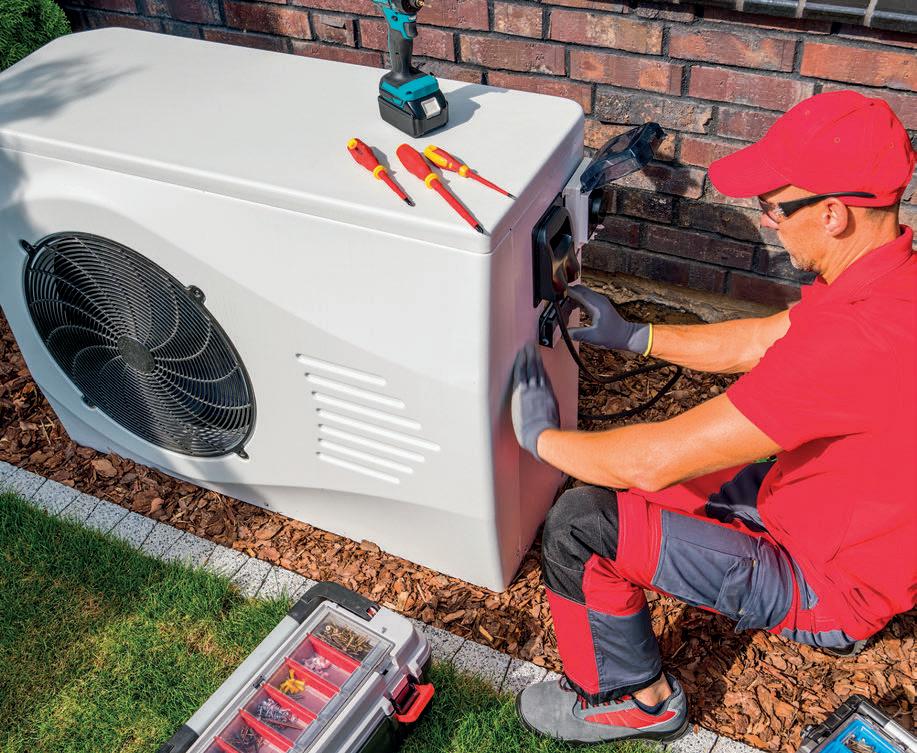
The new President of the ECA, the UK’s leading engineering services trade association, is business leader and electrical engineer, Stuart Smith.
Stuart started as an apprentice electrician in 1986 on a CITB training scheme, created his own business in 1997, and became a Director of Stromtechs in 2007.
Since joining the ECA, Stuart has been Vice Chairman and Chairman of the Thames Valley Branch; Thames Valley Branch representative at the Central South REC for at least five years; and Central South representative on the ECA Council since May 2019.
Stuart takes over the ECA Presidency from Sean Smyth. During the last 12 months, Sean played a critical role in guiding the ECA as it supported its Members to grow and prosper.
The full ECA Presidential team for 2024/25 is as follows:
President – Stuart Smith
Senior Vice President – Ruth Devine
Vice President – Glenn Grant
Immediate Past President – Sean Smyth
The new ECA Presidential team was confirmed on 8 May 2024.
ECA, eca.co.uk

MCS has reported that there were more than 4,500 certified heat pump installations in April alone, making it the third-best month for heat pumps in the scheme’s history.
Ian Rippin, CEO at MCS, says, “The latest MCS data shows that during 2024, April was the best month so far for the uptake of small-scale renewables, with a total of 18,621 certified installations across the UK.
“There were more than 4,500 certified heat pump installations in April alone, making it the third-best month for heat pumps in the scheme’s history. Average monthly heat pump installations this year are 32% higher compared to 2023, setting the stage for what looks to be another record-breaking year for the technology. It’s evidence that more homeowners are making the switch to low-carbon heating, bolstered in part through government initiatives such as the Boiler Upgrade Scheme (BUS).
“The BUS, which requires installations to be MCS certified to qualify for the grant, remains a critical part of the drive to make low-carbon heating more accessible and affordable. As we approach its two-year anniversary, government figures show there have been more than 37,000 applications for grants as of the end of March 2024. The number of BUS applications in March alone was 46% higher in 2024 compared to March 2023, and looking at January to March as a whole, applications were up by 56% compared to the same period in 2023.” MCS, mcscertified.com

Over 300 UK Power Networks employees have raised a total of £48,500 for The Duke of Edinburgh (DofE) charity by virtue of their participation in a 20-mile ‘Royal Ramble’ charity walk across London.
The walk, which took place on 24 May, saw teams of up to seven people walking from Richmond Park in West London over to Potters Field Park by the iconic Tower Bridge. Many of the day’s participants used UK Power Networks’ ‘Donate a Day’ scheme, which allows employees to give something back to charity by being paid to do volunteer work twice a year. The first walkers ‘home’ completed the trek in less than eight hours.
The money raised will go to the DofE Award charity that helps young people gain skills for their future.
Mark Simmons, Head of Powercare at UK Power Networks, says, “It’s really important for me to support charities such as the DofE, as they provide young people from all types of backgrounds fantastic opportunities to develop new skills, grow in confidence and reach their full potential, which ultimately benefits our society.”
UK Power Networks, ukpowernetworks.co.uk
BGEN has appointed Ron Ellis as Head of Business Development. In his new role, Ron is tasked with building on the company’s recent success and securing additional contracts in sectors including power and energy, pharmaceuticals, utilities, industrial and food and beverage.
Schneider Electric has announced the appointment of Ruben Llanes as CEO of Digital Grid. Under Ruben’s leadership, Digital Grid will continue its mission of helping customers modernise their grid systems by maximising resources and minimising ecological footprints, helping to drive the industry’s global green energy transition.
Burton-based mechanical and electrical contractor, Woodward Group, has appointed Steve Bullock as Fire & Security Project Manager in line with its ongoing expansion plans.

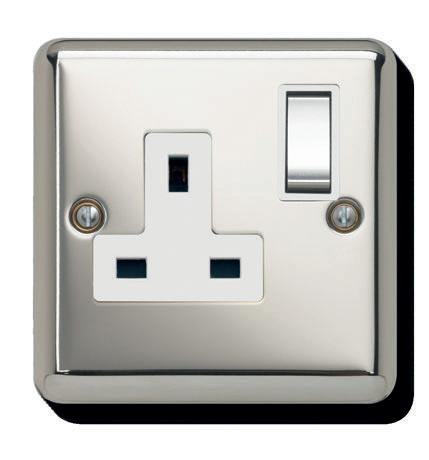
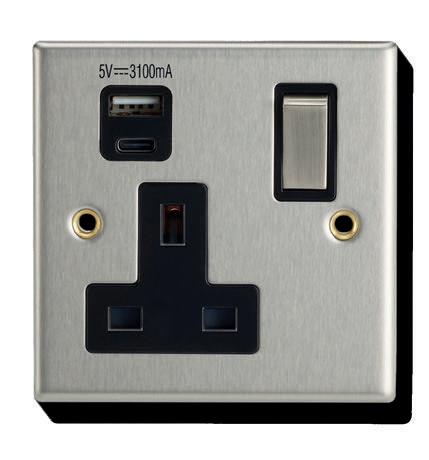
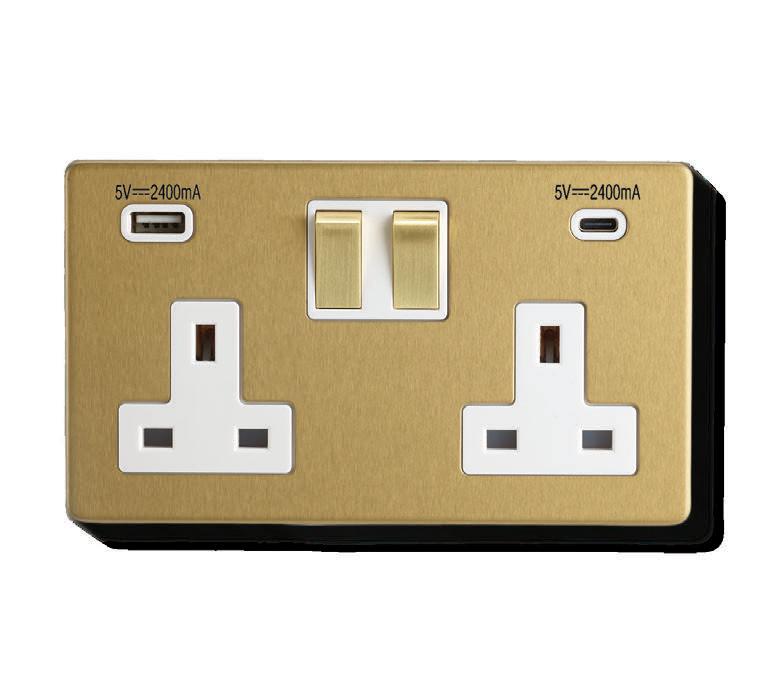
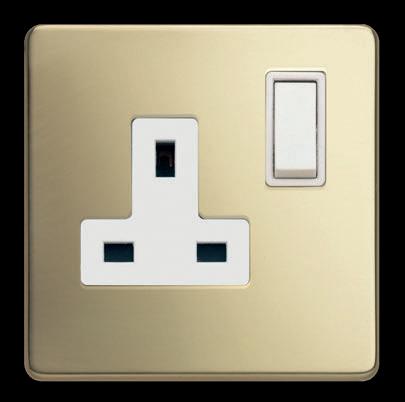
Hispec, the Chorley-based supplier of fire detection and lighting products, has announced the launch of its new in-house Continuing Professional Development (CPD) accredited course.
The new course will provide electricians with comprehensive training while informing them about life-critical safety systems. Hispec’s CPD course will be split into a three-part series called ‘An Introduction to Life Safety Systems’, with modules on Intelligent Emergency Lighting, Connected Fire Detection and The Dangers of Carbon Monoxide
Chris Loughlin, Managing Director of Hispec, comments, “It has always been a dream of mine to be able to offer added value as a business to both our loyal wholesale customer base and the contractors that now install our products daily.
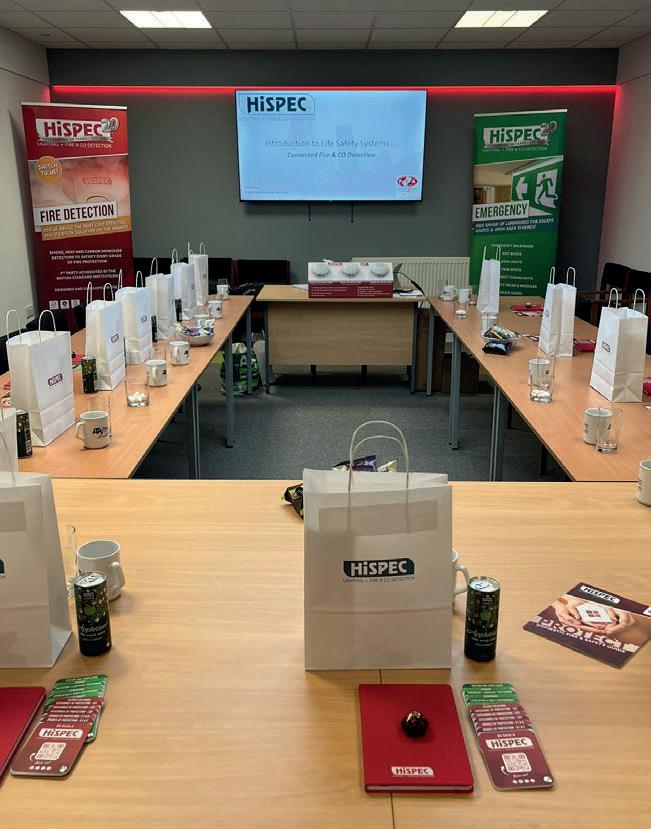

“We will provide contractors with the skills to ensure they have the vital knowledge needed to help protect people in buildings across the UK. By doing the CPD training course, electricians will have peace of mind that they have up-to-date understanding and insight of regulations as well as new products and guidance.”
CPD is defined as learning experiences which help you develop and improve your professional practice. This can include building on your strengths, as well as developing yourself where you have capability gaps. That’s why it’s so important for any contractor to keep their knowledge and skill set up-to-date – be that a new subject to learn or a refresher on a topic previously studied.
CPD requirements vary by organisation, so it is essential that you check what is expected for your membership. Typically, the majority of the required CPD hours must be from participatory learning. This means the learning involves active engagement such as practical/product training sessions, and attending workshops and seminars.
Many organisations are now also including requests for evidence of CPD in their tender documents, to ensure that appointed contractors are correctly trained and up-to-date on the topic involved.
Whilst CPD is essential for maintaining and improving knowledge, it also opens up new opportunities. Contractors can explore new subjects and categories by attending a CPD seminar dedicated to that topic.
This can help contractors offer new specialisations and services to clients and learnings that may transfer to enhance their existing skills and knowledge.
All CPD should be recorded by the trainer and the attendee; typically a certificate or electronic receipt is issued. The CPD is then logged by the contractor with their trade association. This may be as easy as keeping a personal record or uploading the information, but it differs, so please check what is required for your circumstances.
The benefits of CPD are obvious and often free to obtain, other than the time required. A wide range of courses and diverse subjects allow contractors to remain engaged by covering different and possibly new subjects.
The industry is always evolving, and new technologies are being introduced alongside changes to standards and regulations. By actively participating in CPD, a contractor will remain at the top of their game and ahead of those who choose not to embrace this.
Clients also are winners, as contractors will be in a position to offer services with the best level of knowledge and skills, gained from CPD behind them. This should also lead to repeat business and referrals.
Sam Cox, Client Relationship Director, adds, “We have created a CPD training course like no other. We all know that learning on top of doing the day job can be tedious. That’s why we have really put time and effort into our courses and how we deliver them – from videos, Q&A sessions and an upbeat and fun environment. I can’t wait to meet and guide lots of individuals up and down the country.”
Hispec was established in 2002 and supplies a diverse range of products that include fire detection, air quality and emergency lighting – with the goal of making homes and buildings safer for everyone. Courses can be arranged at locations across the UK or at the Hispec facility in Chorley. Times are also flexible to minimise impact on your working day. Anyone interested in taking Hispec’s new series of CPD training can reserve their spot by contacting Sam at sam.cox@hispec.co.uk.
Hispec, hispec.co.uk


Hispec offers a cutting-edge solution for emergency lighting compliance, developed using the latest technology.
Emergency lighting in an ideal world would never be called upon but is a legal requirement under various documents, including the Regulatory Reform (Fire Safety) Order, Building Regulations, and the Health and Safety (Safety Signs and Signals) Regulation. However, unfortunately, if correctly designed and installed, it is often neglected which can lead to a false sense of security and failure in operation or duration if not maintained as required. This means that if it is ever required, it could fail with dire consequences.
British Standard, BS 5266-1 emergency lighting code of practice for the emergency lighting of premises is the reference document that sets out the requirements for emergency lighting levels and testing regimes.
Hispec will work alongside the contractor to advise on and design (free of charge) suitable emergency lighting for the areas concerned. Initial contact with the relevant Hispec Regional Sales Manager (RSM) will allow requirements to be discussed and the process to begin. Upon receipt of the required information, Hispec will produce a design in accordance with BS 5266-1, utilising the company’s range of emergency lighting luminaires to ensure every relevant area receives the correct level of illumination. It is vital that room use is known at the design stage for this purpose. All Hispec emergency luminaires that include signage comply with ISO 7010, which is the latest requirement and referred to in BS 5266. Signage should also

be a common format throughout a building to avoid confusion, so Hispec advises that any existing areas with signage that is not to ISO 7010, is upgraded as part of the SELECT process.
Once a design is approved and the order placed, Hispec will manufacture the required luminaires, incorporating the remote test modules that utilise Zigbee technology and firmware developed by Hispec. Luminaires are then installed on site as per the lighting design and connected to a hub/gateway. Communication between all luminaires and each hub ensures a strong and self-healing mesh signal network is established across the relevant areas. This means that should any luminaire go offline, the system is not broken as multiple wireless connections are made and not a simple circuit.
The hub also connects to the cloud to allow both remote monitoring and safe collection and storage of data.
Minimal on-site installation time is required in addition to that of a standard emergency lighting system, making such a remote testing system very cost-effective to install, considering the functionality it provides.
A complete emergency lighting installation must be tested regularly and with records kept, to ensure compliance. The Fire Safety Act defines a Responsible Person (RP) who may in turn delegate responsibility to a Premises Manager (PM) for the testing, however, both RP and PM can be legally implicated for any non-compliance.

The majority of prosecutions for non-compliance regarding emergency lighting are due to luminaires not functioning or operating for the stated duration. Typically, this is due to human error or neglect of the testing/maintenance.
Remote testing not only ensures that all tests are correctly scheduled, from a short monthly through to annual full duration, but also are conducted at convenient times. For example, if a building is not in use at weekends or during night time, testing can be scheduled for such times so that there is no impact on the building use. Also, areas with multiple emergency luminaires can be configured with staggered testing, ensuring that some illumination is always available, as it can take up to 24 hours for batteries to recharge and an area can be vulnerable during that time.
Another feature of remote testing is that it does not require anyone to be on site, making it ideal for managing multiple locations and not being reliant on the availability of personnel.
A further benefit of Hispec’s SELECT | CHECK | CONNECT system is that it monitors luminaire health. This means that planned rather than reactive maintenance is possible, again ensuring the building remains both compliant and available, due to functioning emergency lighting. Then a contractor can attend site, pre-armed with the correct information regarding which luminaire and type requires attention and its exact location, saving valuable time, money and resources.
Embrace the future of emergency lighting with Hispec’s innovative and wireless remote monitoring system to ensure full building and Responsible Person compliance.
Hispec, hispec.co.uk
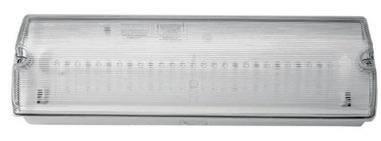

TClarke has been selected by long-term partners Sir Robert McAlpine and British Land to deliver the electrical services package for the new 2 Finsbury Avenue development (2FA). This will be an iconic and unique addition to London’s skyline with dual high-rise towers – the 36 storey East Tower and the West Tower at 21 storeys. In total they will provide 750,000ft 2 of world class space, located in the heart of Broadgate and due to be completed in 2027.
A 12-storey podium will link the towers via a winter garden and incorporate green spaces, leisure and a range of publicly accessible space – reflecting the mixed-use campus of which it will be a fundamental part.
It will create a new benchmark for highly sustainable workspace in central London with BREEAM Outstanding, WELL Platinum, EPC A and NABERS 5-star ratings. It will be all-electric and a smart-enabled development, ensuring leading carbon and energy efficiency in operation.
In a concerted effort to combat climate change and foster sustainable transportation solutions, Manx Utilities, the primary provider of mains water, wastewater and electricity services on the Isle of Man, has joined forces with Lucy Zodion to propel the island’s electric vehicle (EV) revolution.
Manx Utilities has initiated a strategic plan to develop a comprehensive public charging network across the island, in line with European standards. To bolster the island’s charging infrastructure, Manx Utilities sought the expertise of Lucy Zodion. Lucy Zodion’s EVIS Feeder Pillars were selected to support the expansion of the charging network, with a focus on improving existing facilities and strategically installing new charge points across picturesque locations, such as Peel.
The deployment of these modular pillars enables swift installation and future scalability, ensuring that the charging network can readily accommodate the growing demand for electric vehicles on the Isle of Man. Equipped with advanced features including anti-condensation heaters and PEN fault detection technology, these pillars represent a milestone in the island’s transition to sustainable transportation solutions.
The collaboration between Manx Utilities and Lucy Zodion has not only expedited the deployment of EV charging points but has also minimised disruption to daily life on the island by reducing on-site installation time, particularly in high-traffic areas.
Lucy Zodion, lucyzodion.com
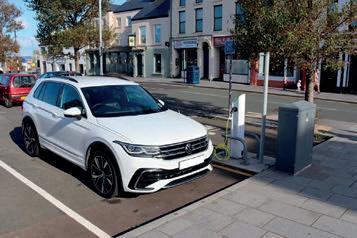

Commenting on the announcement, TClarke CEO, Mark Lawrence, says, “We are delighted to have been selected for this exceptional project. The skills and capabilities of our people are what defines our business. Once again they
have allowed us to win one of the most prestigious projects in the market currently. My congratulations go to all who have been involved in winning 2 Finsbury Avenue.”
TClarke, tclarke.co.uk

Aztec Solar Energy has become a Centrica Business Solutions energy partner and will complete its first solar PV design and installation project at Poole Hospital in Dorset. The installation is part of University Hospitals Dorset NHS Trust’s transition to net zero.
The project involves five interconnected roofs on one building and will have 470 PV panels, five SolarEdge inverters and 261 optimisers. Estimates show that it will generate circa 200,000kWh annually to save circa 50t of CO2 a year.
Aztec Solar will connect, commission and test the new solar PV system over just two days after installing the panels, inverters and other equipment.
Stuart Lane, Sustainability and Carbon Manager for University Hospitals Dorset NHS Trust, says, “We are implementing a new roof-mounted photovoltaic system to advance our commitment towards achieving net zero carbon targets.
“The solar panel arrays are situated atop the Phillip Arnold blocks and the Dorset Cancer Centre. This partnership underscores our commitment to embracing solar energy as we decarbonise our estate – enhancing healthcare facilities and services for our community.” Aztec Solar Energy, aztecsolarenergy.co.uk
The iconic Sandbanks seawall lighting, steeped in over a century of history, has been restored with a modern brilliance, thanks to a collaborative project implemented by Acrospire and Volker Highways.
The Sandbanks seawall lighting columns, erected in 1895, stand as silent witnesses to the passage of time. Although decorative rather than essential for road lighting, these lamps hold immense historical significance.
The Society for Poole secured £42,000 from Bournemouth, Christchurch and Poole (BCP) Council to kickstart the first phase of the lamps’ restoration. The collaborative effort involved removing, repairing and repainting the cast iron bases, with a meticulous focus on maintaining authenticity.
The restoration project involved converting the existing 70W SON lanterns to 40W LED, employing the Acrospire Comfort COB 3000K light engine. This choice not only achieved energy savings of over 50% but also provided a low-glare, pedestrian-friendly illumination that complemented the luminaires’ original era. The 3000K colour temperature added a warm glow, maintaining the heritage aesthetic.
The meticulous refurbishment involved stripping away old paint, recasting elements, and testing to recapture the lanterns’ original splendour.
Acrospire, acrospire.co

LiFe. A range of emergency lighting from NVC all powered by the latest lithium iron phosphate (LiFePO4) battery technology. The brighter choice for your business. The brighter choice for your customer.
To find out more about NVC Lighting’s LiFe emergency range and for a chance to claim your limited edition ‘CHOOSE LiFe’ t-shirt, scan the QR code or visit: nvc-choose-life.com
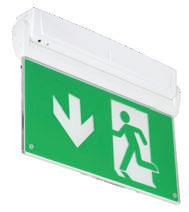
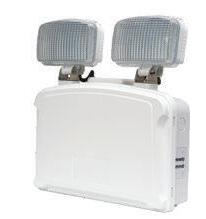
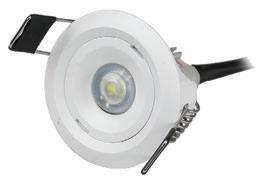
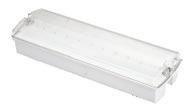








Evoke Lighting and Cucumber Lighting Controls have united their expertise to brighten the facilities of Aspen Pumps, a leading player in the HVAC industry.
Aspen Pumps expressed interest in transitioning to LED lighting, echoing the desires of many clients to shift from outdated, energy-draining lamps to modern LED luminaires. Evoke and Cucumber Lighting Controls pooled their expertise to create a tailored lighting scheme aligned with Aspen Pumps’ specifications. Simultaneously, Cucumber Lighting Controls devised a control solution to ensure efficient lighting usage across office and industrial spaces.
Richard Greenfield, Aspen Pumps’ Facilities Manager, praised the collaborative endeavour, remarking, “The lighting and lighting control upgrade spearheaded by Neil and his team, in collaboration with Cucumber Lighting Controls, has revolutionised our workspace. We are thrilled with the outcome and the notable enhancements in lighting quality and energy efficiency.”
Cucumber Lighting Controls, cucumberlc.co.uk

Equans has secured a major contract with Platform Housing to improve the energy efficiency of over 500 homes across Lincolnshire and Leicestershire.
The project will significantly reduce the carbon emissions of Platform’s housing stock and help tackle fuel poverty, with residents’ energy bills set to fall as a result of the improvements.
Properties will be fitted with air source heat pumps and solar panels to provide a more energy efficient and less costly way to heat and power homes. New external wall, cavity and loft insulation will also be fitted –reducing heat loss and bringing homes up to an Energy Performance Certificate rating of C or above. Improved ventilation will also help air to circulate, reducing the likelihood of damp and mould occurring.
Based on a similar completed project, it is estimated that the improvements will make total carbon savings of 950t each year and that households will each save over £480 per year on their energy bills.
This project is part of Platform Housing’s commitment to achieve EPC C across its portfolio of 48,000 social rented homes by 2030 and be net zero carbon by 2050. The scheme is due to be completed by September 2025. Equans, equans.co.uk
Powercor has successfully completed an innovative energy-saving project for Kelly’s Storage, a large warehouse located in Luton that was struggling with hefty monthly energy bills ranging from £3,000 to £5,000. Powercor’s detailed investigation pinpointed that the excessive costs were due to outdated high-pressure 400W high bay lighting systems that consumed a constant 22.79kW, costing the facility £6.83 per hour, with lights continuously on and no lighting controls in place.
To address this inefficiency, Powercor installed the state-of-the-art Signify Philips Lighting technology, Interact. This solution features high bay lighting equipped with mesh network controls, allowing for seamless integration using existing lighting feeds while introducing robust wireless control among luminaires.
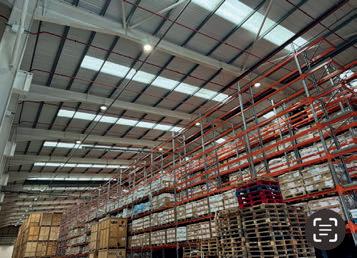
The transformative upgrade included setting up daylight harvesting and proximity detection, which intelligently activates lighting only when forklifts are operating in the aisles. This smart system groups luminaires to ensure that lights turn on and off automatically, optimising energy use and significantly reducing costs.
The early results show more than a 76% reduction in energy usage, with consumption dropping from 22.79kW to just 5.4KW when unoccupied.
This project not only slashed energy costs but also enhanced lighting quality and safety conditions. Kelly’s Storage now enjoys improved operational efficiency and substantial financial savings.
Powercor, powercor.co.uk
BGEN has been awarded a £84 million project by GE Steam Power Systems to provide electrical and instrumentation solutions to the Hinkley Point C nuclear power station in Somerset.
BGEN’s remit includes the design, supply and installation of electrical and instrumentation packages for Unit 1 and Unit 2 Turbine Halls of the nuclear power plant. Standing at 50m high, each will house one of the world’s largest Arabelle steam turbines, along with a generator and other critical equipment.
In terms of electrical scope, BGEN’s turnkey project solution includes the installation of the Isolated Phase Busducts (IPBs), design verification, seismic qualification, supply and installation of structural support and containment systems and the installation of electrical equipment and cables, in addition to termination and testing.
Robin Whitehead, CEO of BGEN, says, “This contract that we’ve secured with GE Power Systems is our latest prestigious win within the nuclear energy sector. It’s testament to our proven collaborative approach and ability to deliver turnkey solutions in a highly regulated environment.” BGEN, b-gen.co.uk

Domestic, commercial and industrial installations – the FuseBox range of TPN distribution boards, with T2 SPD and 125A 4Pole main switch as standard.
• 10kA Devices: MCBs, RCBOs, RCDs
• Compatible with FuseBox 6kA devices without any modification
• Removable gland plates top and bottom
• Unique hinged front cover assembly
• Robust design – 1.2mm zinc galvanised steel
• 3, 7, 11 and 15 usable ways
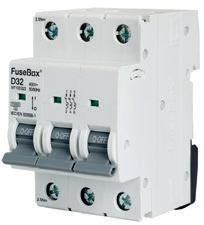

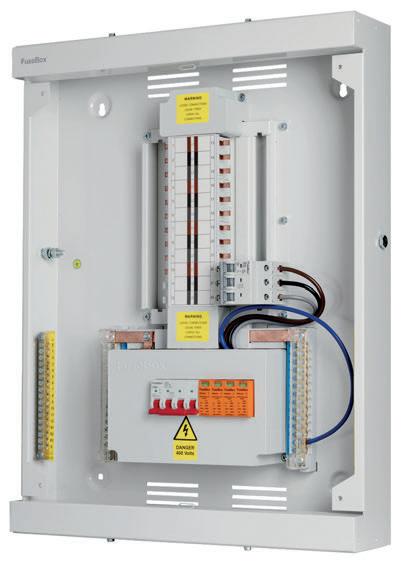
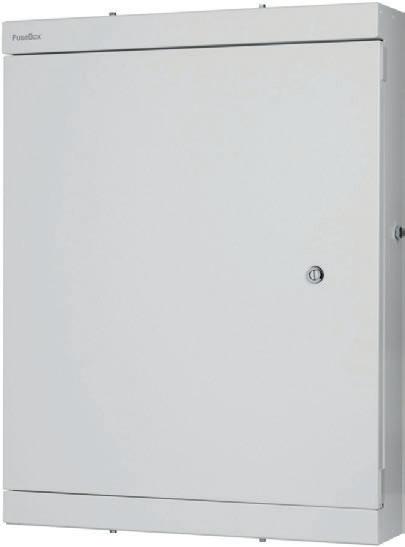


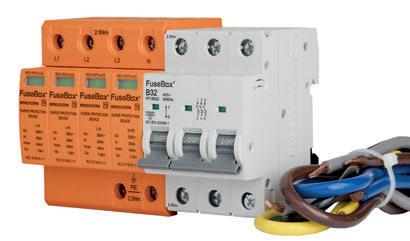


As we strive to meet net zero targets, householders and businesses are switching to low carbon technologies, including e-mobility and electric vehicle charging points, solar PV, and electrical energy storage systems. These systems require specialist knowledge, skills and understanding to be designed, installed and commissioned safely and correctly, writes Kevin Sparrow, Industry Portfolio Manager – BSE at EAL

Consumers are choosing these new technologies to reduce their carbon footprint and energy costs (including electricity arbitrage) and they also help provide them with a reliable energy source for the future. MCS, which creates and maintains standards that allow for the certification of products, installers and their installations, found that solar PV continues to be the most popular renewable technology amongst UK homeowners, with more than 183,000 certified solar PV installations across the country in 2023.
Low carbon technologies are now more embedded in electrical apprenticeship standards than ever before, resulting
The boost in solar installation requires up to 500 additional qualified electricians per year

in new apprentices having a greater appreciation of these systems and prosumer’s electrical installations (PEIs) alongside conventional electrical installations. England’s installation and maintenance electrician standard is also now recognised as a green apprenticeship. It carries the King Charles III Coronation Stamp (this apprenticeship qualification is also delivered in Northern Ireland). Welsh apprentices will also learn about PEIs and low carbon technologies in their purpose-built qualification.
For solar PV, The Electrotechnical Skills Partnership (TESP), formed by the Electrical Contractors Association (ECA), Joint Industry Board (JIB), National Electrotechnical Training (NET), SELECT and Unite the Union, found that the UK has a current solar capacity of around 15GW. The research found that the boost in solar installation requires up to 500 additional qualified electricians per year. TESP wants to ensure public safety with solar PV and other low carbon technology installations, so they should only be carried out by competent electricians who have upskilled in the relevant technologies. Therefore, in 2023, TESP launched the ‘Electrician Plus’ concept, which includes a mechanism to have industry CPD qualifications recognised and awarded with a kitemark. These qualifications can be viewed on the TESP website. Qualifications approved with this new kitemark must operate in full compliance with an industry assessment strategy and will have been reviewed in detail by the ECS technical approval group. Where relevant, these qualifications will also be recognised by MCS. This will give contractors confidence that they are achieving a good quality and valid industry qualification.
Low carbon technologies are ever-evolving and impacting ways of working – an example is Amendment 3:2024 to BS 7671:2018 (now in draft for public consultation), which aims to clarify the differences between connections for unidirectional and bidirectional RCDs and circuit-breakers. Undertaking good quality training and CPD, which meets the ‘Electrician Plus’ kitemark, is the best way to upskill and gain industry recognition in
these technologies. This will then help to ensure that these systems are installed safely and correctly and that contractors meet industry requirements and gain relevant recognition.
This is especially important in solar and electrical energy storage installations, which have a range of safety and technically critical aspects, such as DC arc flash and fire hazards, that contractors may not be familiar with. A range of standards and requirements impact these systems, including CDM, BS 7671, BS 7430 and BS 5839-6. Energy storage CPD will cover how to size batteries for given applications and island mode operation, together with the key issues for the electrical installation design, modes of operation, design issues, DC systems, and a range of other topics that follow industry guidance from MCS, the IET and PAS 63100:2024. Learners will get hands-on training and undertake practical assessments to ensure they have the skills to put the theory into practice. CPD in these technologies will align the theory and practice to help you gain the right skills, knowledge and understanding to excel.
Some training providers have been able to attract funding to deliver these qualifications, and another option for eligible contractors is the JIB Skills Development Fund, which provides financial assistance for courses for those undertaking further education and training in the electrical industry. This fund, for JIB member companies, is for electrical operatives and registered apprentices for courses over and above the normal requirements of the JIB grading system. JIB member companies can benefit from grants for training and upskilling their workforce, helping to make their business more competitive. This funding is up to 75% of course fees, up to £1250 per person, per course, per year, so it can add up very quickly in helping your business to grow.
So, if you are considering expanding your business and upskilling into these exciting technologies, there is no better time to upskill to meet net zero.
EAL, eal.org.uk



























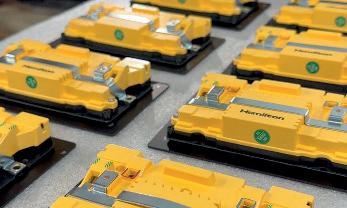



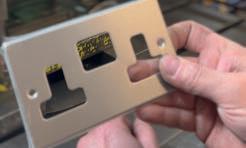

Hager’s Technical Training Manager, Paul Chaffers, shares the importance of observing protective device terminal markings and discusses the requirements for disconnecting all live conductors, including the neutral conductor for certain applications.
Usually, we consider the current flowing through a protective device to be in one direction only, i.e. from the distribution board to the load. But there are requirements to observe for situations where current may flow in either direction through a protective device, such as when a generator is used as an additional source of supply in parallel with another source. For such applications, a bidirectional device is required.
The Wiring Regulations specifically refer to this topic in Chapter 82 for prosumers’ electrical installations, where Regulation 826.1.2.2 reminds installers to take account of all possible directions of current flow and polarity.
Furthermore, Regulation 134.1.1 requires installers to use proper materials in the erection of electrical installations. Installers must also take account of manufacturers’ instructions for any electrical equipment installed.
RCD and MCB product standards require that if it is necessary to distinguish between the supply and the load terminals, they shall be clearly marked. Hager unidirectional devices are marked ‘in’ and ‘out’ near the corresponding terminals indicating the direction of power flow. For a better understanding see Fig 1. Where unidirectional devices are incorrectly used for applications where the current flows in either direction (micro-generation, battery storage, solar PV etc), it is possible that the device can be permanently damaged and therefore may not offer the correct protection under fault conditions.

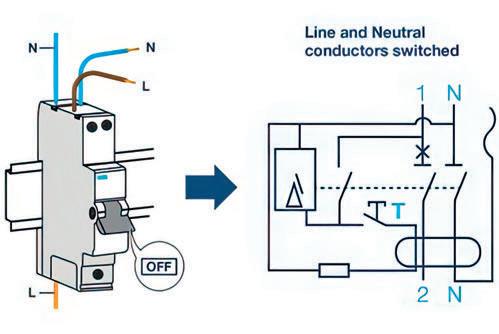
RCDs and MCBs which are NOT marked ‘in’ and ‘out’ or ‘line’ and ‘load’, or with arrows indicating the direction of power flow, are typically referred to as bidirectional devices and are suitable for all applications where power flow may be in either direction – see Fig 2.
BS 7671 Chapter 55 deals with ‘other equipment’ and it is here where we find extra measures that need to be applied for installations where generating sets may operate in parallel with other sources.
Most existing single modular RCBOs only switch the line conductor, but there are situations where it is necessary to switch all live conductors including the neutral. A comparison of the schematic diagrams shown in Fig 1 and 2 will show the differences between Hager’s unidirectional RCBO (single-pole) and the new bidirectional RCBO (double-pole). Similar diagrams are located on the side of each RCBO and in the product data sheets provided in the packaging. Regulation 551.7.1 requires that where an RCD is providing additional protection (in accordance with Regulation 415.1) for a circuit connecting a generator set to the installation, the RCD shall disconnect all live conductors, including the neutral conductor. Fig 3 shows the reasons why it is important to disconnect all live conductors and the illustration shows an earth fault being fed by a microgenerator after the single-pole RCBO has operated. This will continue for the period of time it takes the microgenerator to shut down due to loss of mains power.
From here we can see that this type of work requires careful design to allow the correct selection of protective devices.
Another example of where the neutral requires switching can be found in Section 722 (Electric vehicle charging installations), where Regulation 722.351.3.1 states RCDs shall disconnect all live conductors. Designs which include EV-to-home technology will also require suitable bidirectional protective devices and chargers to allow energy from the EV’s battery back into the home.
To obtain further information regarding current flow direction, see BEAMA’s Technical Bulletin Connection of Unidirectional and Bidirectional Residual Current Devices (RCDs) and Miniature Circuit-Breakers (MCBs) to power supplies e.g. battery storage, Photovoltaic (PV) systems, Electric Vehicles (EV) to home, a micro-generator, or grid (mains) supply
The necessity to disconnect all live conductors is not a new requirement and was addressed in 2007 in the Electrical Safety Council Best Practice Guide Connecting a microgeneration system to a domestic or similar electrical installation (in parallel with the mains supply)
Visit Hager’s Residual Current Devices training course, which covers all of the subjects discussed in this article plus many more. All technical courses are CPD accredited and come with downloadable certificates.
Hager, hager.com
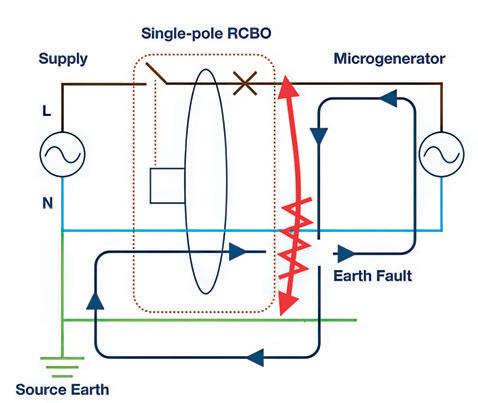



Acrospire has completed a project with Bournemouth, Poole and Christchurch Council to upgrade Poole high street’s heritage lighting to LED, resulting in a 74% reduction in energy consumption.
Once a quaint medieval fishing harbour, Poole has evolved into a bustling commercial port boasting major maritime industries. Its high street, nestled against the picturesque backdrop of Poole Harbour, serves as the vital link between the historic quayside and the town centre. Characterised by a

blend of Georgian houses, elegant Victorian buildings, and charming 1930s art deco shopfronts, Poole exudes a vibrant sense of place, attracting visitors and locals alike.
However, the town centre faces its fair share of challenges. Recognising the need for revitalisation, Historic England identified the high street as a Heritage Action Zone. It secured funding to restore historic buildings, repurpose vacant spaces, and enhance public areas to invigorate the town centre.
Daniel Moorley, Street Lighting Team Leader Infrastructure at Bournemouth, Poole and Christchurch Council, says, “Our Conservation team engaged us to upgrade the lighting along the high street. We had received a grant for a Heritage Action Zone and wanted to make the wall lighting and column lighting match and fit in with the area.”
Acrospire upgraded the High Street’s lighting infrastructure to align with the Heritage Action Zone’s objectives.
The solution comprised 72 wall and column-mounted Muirfield luminaires. Muirfield, renowned for its traditional gas lantern aesthetics infused with modern LED technology, perfectly complemented the historic architecture of Poole’s high street. Crafted using premium materials sourced locally in the UK, these luminaires ensured superior quality and durability.
To address the project’s unique requirements, Acrospire provided
a mixture of wattages (from 31W to 45W) tailored to meet current lighting standards. With a colour temperature of 3000K, the lighting solution offered a warm and inviting ambience, enhancing the town centre’s allure.
The project had its obstacles. Daniel explains, “We were in a position whereby the original cast iron columns did not have access at the base, so a solution was required where we could install a local isolator at each column. We worked with Acrospire on a ‘clock box’ solution that was big enough to house an isolator and mimicked a gas clock box that would have been used when the lights were powered by gas.”
As well as ticking all the aesthetic boxes, the transition to LED lighting resulted in significant energy savings, with a remarkable 74% reduction in energy consumption compared to the previous SON installations.
Daniel comments, “Locals have praised the uniformity and improved spread of light, notably the elimination of bright spots which has created a more visually pleasing environment.”
The successful collaboration between Acrospire and the council breathed new life into Poole’s historic high street, contributing to its ongoing revitalisation efforts.
Acrospire, acrospire.co



Unicrimp is giving one lucky winner the chance to win a bundle comprising a mix of products from across the Q-Crimp, Q-Fire and Q-Nect ranges.
Part of the Scolmore Group since 2014, Unicrimp offers an extensive range of cable accessory products that provide electricians with everything they need when working on the tools. The range is divided into three distinct categories: Q-Crimp cable and wire accessories; Q-Fire fire-rated and 18th Edition compliant cable accessories; and the Q-Nect range of lever connectors and connection boxes.

The Q-Crimp collection incorporates more than 19 different product categories including Cable Clips, Cable Cleats, Cable Glands and Cable Ties, Fixings, Earthing Rods, Tape and Sleeving, as well as Trade Tubs of fixings and clips in handy, durable and re-sealable plastic tubs.
The Q-Fire range of 18th Edition fire-rated cable accessories currently comprises:
• Fire-safe Twin and Earth Cable Clips
• Saddle Clips and P Clips
• Stainless Steel Mounts
• Metal Cable Cleats
• All-Round Banding
• Masonry Screws
• Fire-resistant Sealants and Foam
The 18th Edition wiring regulations stipulate that cable support systems must be constructed with materials that will withstand premature collapse caused by direct exposure to heat. There are no applications excluded – trunking, conduit and cabling fixed to surfaces of the building or attached to cable support systems must all have fire-resistant supports in place.

The Q-NECT range of lever connectors and connection boxes brings together a selection of products that work in conjunction with each other to provide installers with strong, quick and reliable solutions that will offer them versatility when carrying out their everyday tasks.
A total of 10 products make up the full Q-NECT range, which comprises:
• 2, 3 and 5 way lever connectors
• IP66 weatherproof junction box
• 2 and 3 way IP connection boxes
• 5 pole, 3 way IP68 ‘T’ and 2 way inline connectors
The full range of products can be seen in the latest Unicrimp catalogue, which can be viewed and downloaded from the Unicrimp website, as well as the Scolmore Group app.
Unicrimp, unicrimp.com
For your chance to win a Unicrimp bundle comprising a mix of products from across the Q-Crimp, Q-Fire and Q-Nect ranges, simply answer the following questions correctly:
1. The Unicrimp Q-Crimp cable accessories collection incorporates how many different product categories?
a) More than 12 b) Less than 18 c) More than 19 2. What name does the Unicrimp range of lever connectors and connection boxes come under?
Q-Crimp
Q-Fire
Q-Nect 3. With which regulations does the Q-Fire range of fire-rated cable accessories comply?
a) 16th Edition wiring regulations
b) 18th Edition wiring regulations
c) 17th Edition wiring regulations
The winner of the April competition – a £200 Amazon voucher, courtesy of Click Scolmore – was Brandon Holmes.
All entries must be returned by 30 June 2024. The editor’s decision is final. For the full terms and conditions, visit electricalcontractingnews.com/ competition-terms.
The name of the winner will be published in the August issue of ECN. *Prize not exchangeable.
Get ready for an electrifying summer of football with Schneider Electric!
This summer, purchasers/installers of selected products will have the chance to win some fantastic prizes with Schneider Score to Win – the new online football game from Schneider Electric. In this exciting new game, players must beat the keeper from the penalty spot as many times as they can to win points and earn themselves a place on the leaderboard.
A top score could net you a brand new 65in OLED television, a pair of Premier League hospitality tickets, an e-gift card for Virgin Experience Days or Prezzee, or even a mystery football shirt box! The top scores are recorded on an online leaderboard, and this rotates bi-weekly, meaning there’s a new chance to win these prizes every fortnight.
What’s more, the first 3000 first-time players will instantly win a complimentary £5 Greggs e-gift card, or – for the very lucky
– Schneider Electric will give a £50 Mitchell & Butler e-gift card to every 50th player.
Visit your local participating wholesaler, purchase one of the qualifying Schneider Electric products, and scan the QR code on the packaging to play.
1. Purchase any qualifying product from your local participating electrical wholesaler
2. Scan the ‘COMPETITION’ QR code on the packaging and enter your details, including the unique code found under the QR code
3. Try and beat the keeper as many times as you can! The game stops once you’ve failed to score three times




4. Scoring is accrued per goal and each one is scored between 0-100. The individual scoring is based on velocity, precision of the goal near the post or crossbar and proximity to the keeper
5. If it’s your first time playing and you’re one of the first 3000 players, you’ll win an instant £5 Greggs e-gift card for taking part!
6. Every 50th entrant will instantly win a £50 Mitchell & Butler e-gift card, instead of Greggs
7. Your score will be logged on Schneider Electric’s leaderboard, which resets every two weeks
8. At the end of every leaderboard window, the top 10 scorers will win some fantastic prizes!
This competition ends on 30 September 2024. Visit se.com/uk/promotion to keep up the date on the latest details and scores.
Schneider Electric, se.com

Signify has recently launched LumXpert, a comprehensive tool designed to assist electricians in their day-to-day tasks and significantly contribute to the ongoing digitalisation efforts within the lighting industry.
In today’s technologically advanced and ever-evolving world, electricians are on the constant lookout for tools that can make their work more efficient and convenient. The 2000s have seen a surge in mobile applications designed specifically for electricians working in the UK. These apps cater to various needs, such as project management, calculations and electrical planning, becoming an essential part of a modern electrician’s toolkit.
Be it a scenario of installing lighting in an office space or warehouse or simply replacing the lights in a facility, a job like this can come with a myriad of challenges. Whether its finding the right products or finding the right partner to get the products, getting the right quote in place, or even getting the installation correct as per specific workspace regulations and requirements. More so, as an electrician in the UK, you know that keeping up with the latest technology can be a real challenge.
Market studies show that ordering online – either through traditional wholesalers, marketplace or new online pure players is increasing. Studies and market trends also show that:
• Working on the go: Electricians are always on the move, working at various job sites or in different locations. With a mobile app, they can carry a comprehensive toolkit in their pocket, eliminating the need to lug around bulky manuals, reference materials or physical tools.
• Staying up to date on the latest trends and regulations: Electrical codes and standards continuously evolve, and electricians must stay current with the latest regulations. This access to real-time information helps electricians make informed decisions, ensure compliance and maintain high standards of safety and quality.

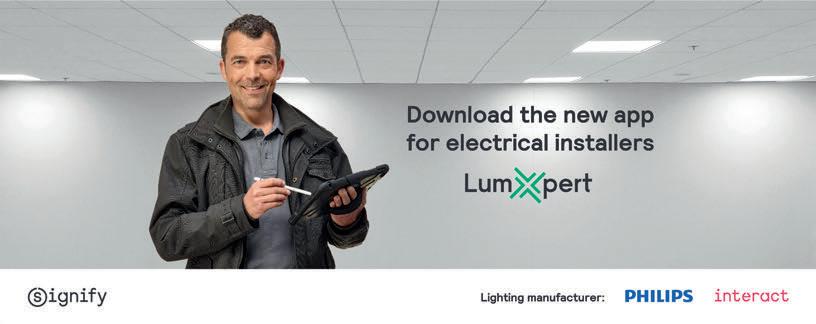
• Handy tool for electrical jobs: Leading their companies and running daily operations, electricians and installers have a busy day with a diverse range of tasks – from finding customers to purchasing equipment to installation, invoicing and after-sales service. While they are a super-skilled workforce, having a companion like Signify LumXpert can make the job easy while on the go.
Signify, the Philips Lighting manufacturer, strongly believes in supporting the personal and professional growth of the electrician and installer community by providing training and upskilling on a wide range of topics and innovative solutions to create new business opportunities, as well as keeping professional installers up to date with industry regulations and new trends and technologies. Built on many years of industry collaboration, LumXpert is the new marketplace specialised in lighting, developed for and with small and medium-sized installation companies to allow them to create fast quotes, compare prices and availability, order products through the platform from wholesalers, and design and expand their lighting expertise. The purpose of the app is to constantly create possibilities for installers to make their jobs easier, faster and simpler. The app offers installers instant quotes from multiple wholesalers based on project and product details, with a simplified purchasing process directly within the app. This enables users to buy from associated wholesalers with transparent information on prices and availability. Additionally, installers will have access to exclusive financing options.
• Quickly find the right products for your lighting job through the extensive Philips portfolio of LED lamps and tubes, luminaires and more.
• Compare prices, check product availability and get immediate quotes across multiple wholesalers with your LumXpert account – there is no need for an account with each one.
• Buy and track your order and delivery status, receiving it in a maximum 48 hours.
• Create simple light plans based on projects, download them and share them with your customer.
• Get direct access to Signify’s lighting experts’ customer service.
The tools of the trade for a modern-day electrician include more than pliers, screwdrivers, wire strippers and power drills. Today’s electrical expert uses technology to help get the job done. Your smartphone holds the key to everything, from making calculations to invoicing clients. While apps won’t take the place of professional knowledge, Signify LumXpert can be the tool to make working life easier. From Signify, along with the wholesale sector, LumXpert arrives with installers’ needs in mind to assist them in their daily work and contribute to the digitalisation of the lighting industry.
Signify, signify.com
LumXpert is now available on the App Store and Google Play Store in the UK, scan the QR code to download the app and get a 15% discount on your first purchase of Philips products.

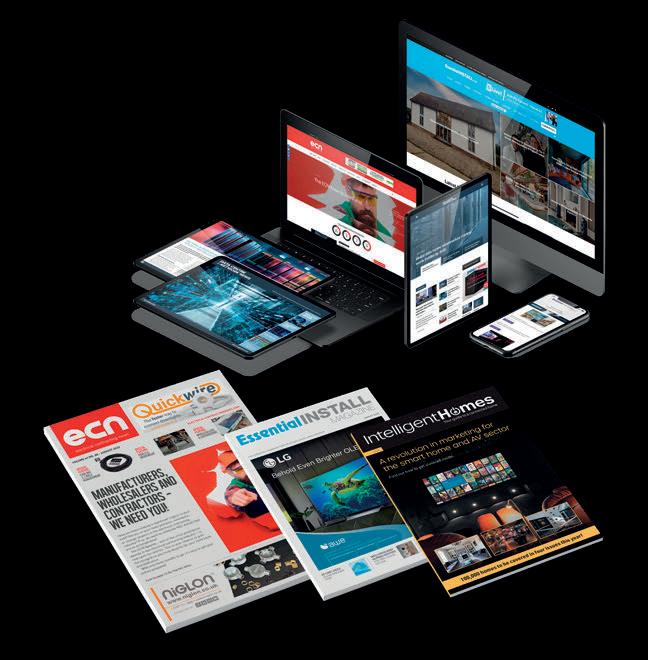
Sultana Rahman, Head of Marketing at Sevadis, discusses DC charging opportunities for electricians and how to get started.
Electricians looking to expand their services into the rapidly growing electric vehicle (EV) market can greatly benefit from offering DC charging point installations. Unlike AC chargers, DC fast chargers provide rapid charging by directly supplying high-voltage DC power to the vehicle’s battery, making them ideal for commercial settings and fleet requirements.
The EV market is booming, with an increasing number of drivers and businesses adopting electric vehicles. DC charging points are in high demand due to their ability to charge vehicles significantly faster than AC chargers. For electricians, this presents a lucrative opportunity to tap into a high-growth market. By offering DC charger installations, electricians can attract commercial clients such as shopping centres, restaurants, hotels and workplaces that aim to provide rapid charging services to their customers or employees.
Additionally, public infrastructure projects, supported by government incentives for EV adoption, are creating more opportunities for DC charger installations in public parking spaces.
Installing DC charging points is more complex than installing AC chargers due to the higher power levels and advanced technology involved. Thorough product training is crucial for electricians to ensure they understand the intricacies of installation, operation and maintenance. Training programs that typically cover electrical safety, site assessment, wiring and grounding, charger configuration, and troubleshooting are ideal for electricians branching out to offer DC charging installations as part of their services. This knowledge not only ensures the safe and efficient installation of DC chargers but also helps electricians provide better service

to their customers, enhancing their reputation and opening doors to more business opportunities.
Choosing the right supplier is a critical step in successfully entering the DC charging market. A reputable supplier provides high-quality, reliable products and comprehensive support, including training and technical assistance. Partnering with a leading supplier ensures that electricians have access to the latest technology and can offer competitive, state-of-the-art solutions to their clients. Furthermore, a reliable supplier will offer warranties and post-installation support, giving electricians peace of mind and confidence in the products they install. Electricians looking to expand their business into the EV charging market should consider the opportunities presented by DC charging point installations. With the growing demand for fast charging solutions, there is significant potential for business growth and profitability. However, success in this field requires proper product training to handle the complexities of DC charger installations and a strategic partnership with a trusted supplier. By investing in these areas, electricians can ensure they provide high-quality, reliable services that meet the needs of their customers, ultimately driving the broader adoption of electric vehicles whilst contributing to a sustainable future.
Sevadis, sevadis.com
In this month’s interview, Carly Weller speaks to Elliott Rothon, UK Marketing Manager at WISKA to find out more about his career so far, WISKA’s plans for the future and where he sees the industry in five years’ time.

CW: Hi Elliott, please tell us about yourself and how you got into the sector.
ER: Technically I have been involved with WISKA since I was 16. My mum and dad (Will and Maxine Rich) set up WISKA UK Ltd in January 2000. I remember seeing what it took to build a business and brand up from the ground and got to witness the growth, hard work and success over the years. On a personal level, I studied film at university and went into retail management for brands such as Superdry, AllSaints and Carhartt. I then re-trained in marketing and PR and joined the business as UK Marketing Manager in August 2016.
CW: For those who may not know, can you give us an overview of the work that WISKA does?
ER: WISKA is a family business based just north of Hamburg, Germany. We have subsidiaries across the globe and WISKA UK was the first one. We manufacture our products in Germany and distribute them across the UK from our offices here in Cornwall. Our primary business is selling into the electrical wholesaler market, but we also have an industry and maritime sector and product range too. We are perhaps best known for our iconic WISKA COMBI junction box, cable glands and gel products.
CW: Tell us about your current role – what are you responsible for and what does the normal working day consist of?
ER: My current role is UK Marketing Manager. I am responsible for developing, implementing and executing strategic marketing plans for the business to attract potential customers, retain existing ones and increase sales and brand awareness. My role encompasses a vast amount, including budgeting, corporate design and image, market research, events and exhibitions, photography and video, website, social media, advertising copywriting, data management, analytics, training and support, and sales and promotions – you name it, marketing is involved in some shape or form! My normal working day changes all the time – one day it’s doing interviews such as this, the next I could be designing a new catalogue or flyer, out filming a new video or off to Germany for an exhibition or event.
CW: What are the best parts of your role? What are the most challenging?
ER: People – we are very fortunate at WISKA to be working with some of the best in the industry. From customers, contractors, groups, associations and especially our own
team. We are always listening and asking questions, looking at ways to improve and seeking insight to help make our brand the best it can be. I also love the creative parts of the job, from designing a piece of literature or packaging to working on campaigns, video shoots and brand optics. I enjoy experimenting with ideas and looking to other completely different industries and sectors for inspiration and ways to bring these ideas into the business.
CW: What in your career are you most proud of?
ER: You could walk into any electrical wholesaler in the UK and simply ask for a WISKA Box and they would know what you were after (it’s actually a WISKA COMBI 308). The only thing I could compare this to is Hoover – this is the brand name, the actual product is called a vacuum cleaner but everyone knows that product as a Hoover. This type of deep acknowledgement and social acceptance within the industry of our product is something we are immensely proud of here at WISKA.
CW: What’s next for you and for Wiska?
ER: We are going to continue to listen and learn, and keep innovating with our products and services. We have an incredibly exciting new cable gland coming out this year, TriShot. It’s the world’s first three-shot injection moulded gland, meaning reduced material waste, energy consumption and assembly time, making it extremely sustainable compared to any other gland on the market. So good, in fact, it has a 54.5% reduction in its product carbon footprint compared to conventional cable glands. Add to this the usual high-performance standards (IP68, built-in seal, wide clamping range, excellent strain relief) and the TriShot is a true trailblazer.
CW: Do you have any career advice for people starting out in the industry?
ER: I always remember two things that our former Sales Agent, Paul Massarella, said to me – “You got two ears and one mouth for a reason” which I love and is aligned with our culture here at WISKA, to be listening first and taking in what our customers, employees and end users are telling us. The other is “If you say you’re going to do something, do it” which again is so simple but so true and part of our culture and attitude here at WISKA.
CW: What do you think are the most exciting products or technologies coming to the market?
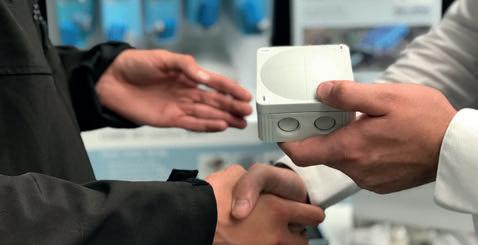
ER: I think with the demand for renewables there are some exciting new products, projects and ideas. There is huge potential for us as an industry to be making products that help our day-to-day lives and improve our living standards whilst at the same time ensuring we reduce our impact on the planet. This is an exciting time! At WISKA, products like our TriShot gland are us pushing this topic forward.
CW: What do you think should be made a priority for the electrical sector?
ER: I feel the biggest challenge the industry is facing right now is keeping up with the demands and changes happening for a greener future. An example of this is with the increase in electric vehicles – a lot of infrastructure needs to be put in place along with electric vehicle charges to keep up with the demand. As a sector, we have the expertise and knowledge to work together with government and other services to help implement positive change and be part of the solution.
CW: Where do you see the industry in five years?
ER: I think the industry will continue to grow and develop as it has always done. Our marketplace has shown it can adapt and, with technological changes and world issues with sustainability and energy usage, this will give lots of opportunities.
CW: What are your interests away from work?
ER: I have two young children and a fiancé and I enjoy spending time as a family exploring Cornwall – the coastline, beaches, forests and, of course, the various places to eat and drink. I also enjoy music of all genres but particularly punk and heavier music, and I’ve recently started collecting vinyl. I love tattoos, art and architecture, and I often visit the Tate in St Ives for inspiration. I also love football and have been a Tottenham Hotspur fan all my life. COYS!
WISKA, wiska.co.uk
99% product reliability
10 second technical response time
20 minutes for average AC install

Our industry-leading support for EV charging solutions sets us apart, providing you with unrivalled assistance and expertise. Benefit from seamless installations and ongoing reliability and in turn enhance your reputation and customer satisfaction.
Get in touch today and speak to one of our team of experts 0330 058 7144

The EMC Directive is a European regulation to enforce limitations on all electrical and electronic equipment that may cause or be affected by electromagnetic interference (EMI). While cable glands are not directly covered by the Directive, Lee Frizzell, Technical Director of CMP Products, talks to ECN about why they should be an important consideration for system designers despite them neither emitting EMI nor being susceptible to it.
EMC (Electromagnetic Compatibility) is becoming an increasingly important factor in the design of electrical and electronic systems. In a nutshell, it’s the ability of electrical or electronic equipment to function correctly in the presence of EMI.
EMI – also referred to as Radio Frequency Interference (RFI) or noise – is a disturbance in the magnetic field surrounding the equipment, which may affect electrical or electronic circuits in the vicinity. This may cause over-voltage, under-voltage or transients that can lead to the degradation of the circuit. In the case of a data path disturbance, these effects can range from an increase in error rate to a total loss of data. This can cause havoc with measuring instruments and can lead to errors being made due to corrupted data being used to make decisions.
EMI is commonly generated in automation utilising drives, motors and transmitters. Where equipment susceptible to EMI is in the vicinity, steps are taken to shield cables and enclosures from it. Safety standards and directives have been established to ensure that the environment, equipment and machinery are protected from both noise pollution and the potentially dangerous consequences of machinery malfunction.
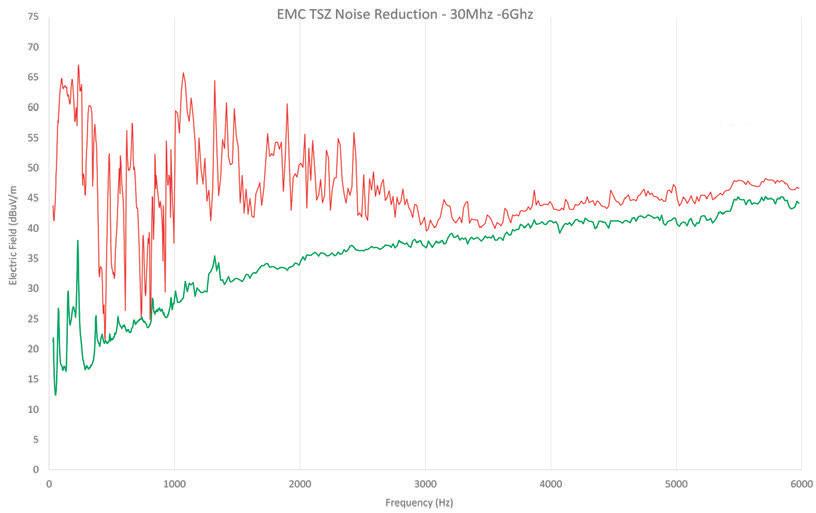
Ungrounded Cable Gland on Shielded Cable TSZ Grounded on Shielded Cable
Cable glands contribute to the electromagnetic compatibility of installations through reliable low impedance connections
The key initiative to address safety is the European Union EMC Directive. Originally enacted in 1989 under Directive 89/336/ EEC, the EMC Directive has witnessed significant development since it first came into force. It has been amended several times since then; the latest being in 2016, when the new EMC 2014/30/EU Directive
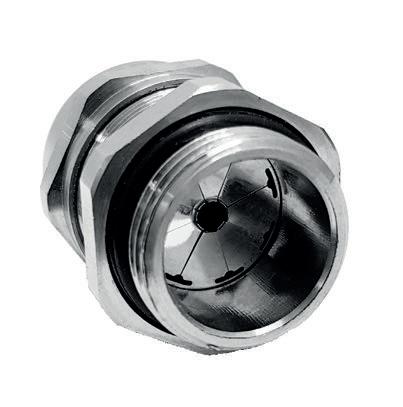
The Directive requires that products must not generate unwanted electromagnetic pollution or interference and that products must be immune to a reasonable amount of noise pollution or interference. EMC testing is required to be carried out on any electrical or electronic product that may either cause electromagnetic radiation or be affected by it.
The Directive means equipment manufacturers must make considerations early in the electrical and electronic design process to ensure the equipment will pass EMC test requirements. Many design techniques are therefore adopted to limit EMI emissions at source or to protect susceptible equipment. Circuits may be partitioned, segregating EMC critical and non-critical areas. A good grounding scheme may be implemented, preventing earth loops leading to unwanted signals being radiated. Shielded cables and enclosures are often utilised, providing barriers to unwanted radiated noise.
However, a significant oversight is often at the point of cable entry into an electrical enclosure. By adding openings in enclosures, pathways are created to allow noise to breach the shielded enclosure.
Unterminated or poorly terminated cable shields can allow noise to be carried into the enclosures, acting as antennas to radiate noise onto sensitive circuits.
Grounding the cable shield effectively inside a cable gland at point of entry eliminates a potential noise pathway and reduces the risks of radiated emissions being carried into the enclosure.
Cable glands, which employ a robust 360° circumferential termination of the cable screen, shield braid or armour
(e.g, with a cone and clamping ring, or a dedicated continuity device) in their metallic body, contribute to the electromagnetic compatibility of installations through reliable low impedance connections. Stats that are backed up by a number of industry studies into the role they can play in EMC protection.
One such independent study was commissioned by CMP in 2021 and carried out by a third party, Eurofins E&E. Three Metre Class B Radiated Emission
Measurement tests were carried out in accordance with EN 55032 to gauge the performance of cable glands terminated onto screened, braid shielded and armoured cables. The results proved categorically that using a reliable, 360° termination of the shield or metallic cable layer inside the cable gland improved noise attenuation throughout the frequency range.
When it comes to improving electrical safety, whether it be with the intention of protecting people, power supplies or data, it’s imperative that every potential step is taken to ensure the systems are the most robust they possibly can be. As such, suitably proven cable glands need to be given proper consideration – and if this can be done within the remit of the EMC Directive then it would ensure they are.
CMP, cmp-products.com
Graph showing a noise reduction when using a CMP TSZ grounded cable gland vs an ungrounded cable gland. Both EMC tests used identical shielded cables







It can be difficult for an electrical contractor to determine whether a single electrode will be sufficient to be able to gain an adequate value of resistance prior to its installation and test. Here, Jake Green Head of Technical Engagement, Scolmore Group, looks at how the earth electrode resistance might be improved as part of a planned approach to installation.
Earth electrode resistance is affected by several factors. These include:
• Climate conditions (wet/dry/frozen ground)
• Soil type (soil resistivity)
• Shape of the earth electrode (rod/plate/ strip)
• Depth of burial
• Number of electrodes
BS 7430: 2011+A1:2015 Code of practice for protective earthing of electrical installations provides recommendations and guidance on meeting the requirements for the earthing of electrical installations.
To calculate the expected earth electrode resistance generally assumes a homogenous soil (of a common type) rather than the more likely multiple layers as an electrode is driven into the ground.
Table 1 of BS 7430 provides examples of soil resistivity for differing soil types. The table is no substitute for measuring the soil resistivity on site.
The examples show that where the resistivity is naturally high (e.g. chalk/ granite) it is difficult to create the conditions where the earth electrode resistance can be reduced significantly in value.
BS 7430 recognises that the earth electrode must be robust, and that the earthing system remains safe.
The approximate resistance of a rod-type earth electrode may be calculated using: Rr = ln- 1
Where:
ρ = soil resistivity (Ωm)
L = length of the electrode (m)
d = diameter of the rod (m)
The calculation allows the designer and installer to determine whether, or not, a single electrode driven to a specific depth will be sufficient before work is carried out.
Consider doubling the depth of an earth rod from 2m to 4m in chalk soil having a resistivity of 60Ωm. The diameter of the rod is 38.5mm.
Based on this calculation, doubling the depth of the rod will improve the earth electrode resistance in a uniform soil, but will not halve the value.
Increasing the diameter of the rod will have very little impact on the overall earth electrode resistance; depth is the key factor in reducing the earth electrode resistance. The limiting factors on increasing the depth of an earth rod are mechanical strength as the rod is driven into the ground, and the varying soil strata.
Consider the previous example where the resistance was 24Ω for an earth rod at a depth of 2m. If a second rod were to be installed at the same depth and at say 6m from the original rod, the resistance would fall to approximately 12Ω (1/2). Were a third rod to be added the resistance would fall to approximately 8Ω (1/3).
It is assumed that rods or pipes are outside each other’s resistance areas if the separation distance is not less than the driven depth. E.g. if the driven depth is 2m then the separation distance should be at least 2m. Little benefit exists once a distance of twice the driven depth exists. There are a series of formulae in BS 7430 to aid the designer in determining the most effective configuration for parallel electrodes, plates, mesh or strip electrodes. Figure 15 in BS 7430 highlights five such configurations, including:
• Triangular (three rods)
• Two strips at right angles
• Three strips set at 120° meeting at the star point
• Four strips set in a cruciform
• Square (four rods at each corner)
There will be times, for example with the earlier example in chalk, where it is not possible to drive an earth rod deeper to reduce the earth electrode resistance. Where a reduction in earth electrode resistance is required, multiple earth electrodes (rods/plates etc.) can be installed in parallel with one another. Where the soil is of a similar nature and where the electrodes are installed outside of the resistance area of each rod, the approximate resistance is the reciprocal of the number of rods employed.
There are other methods of reducing the resistance of the earth electrode, including for example, the use of structural steelwork and encasing electrodes in low resistivity material. However, these methods are beyond the scope of this article.
Prior assessment of the proposed installation method and selection of electrode will enable the designer and installer to avoid a ‘hit and miss’ approach to the earthing of installations using earth electrodes.
Unicrimp, unicrimp.com
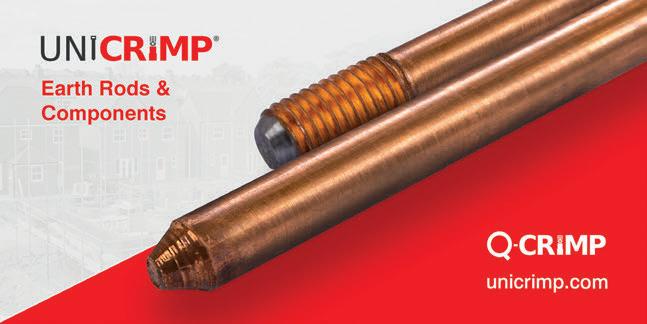

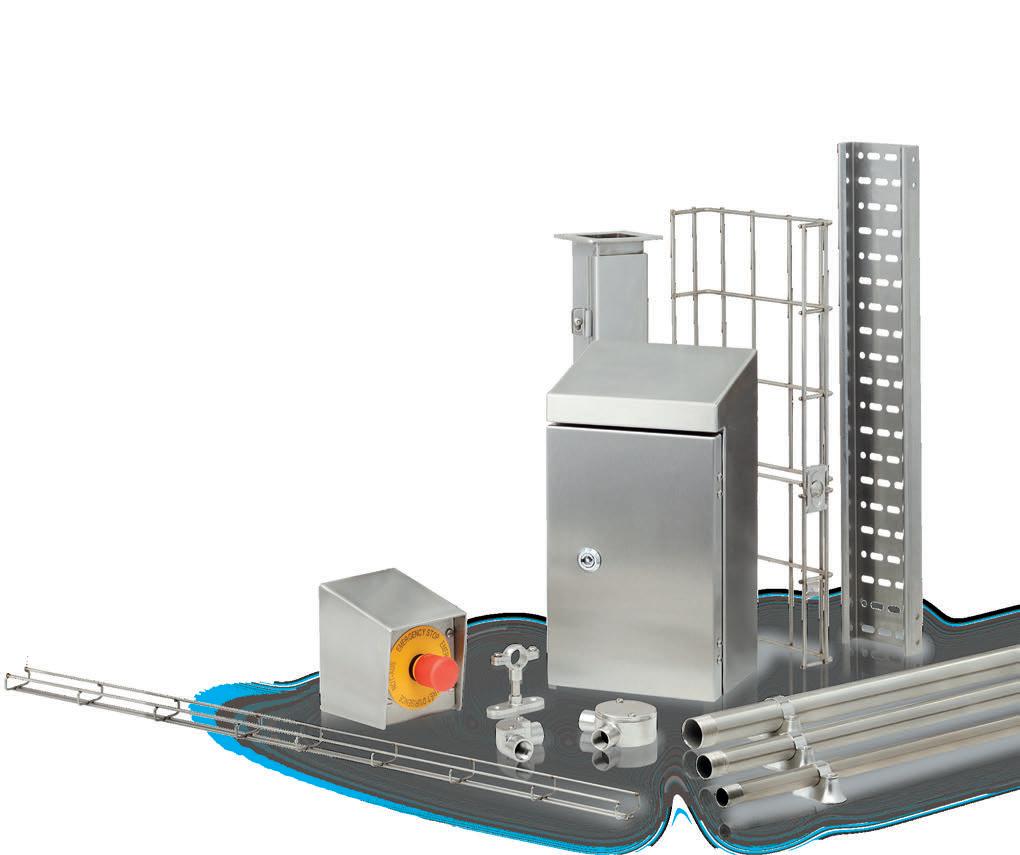



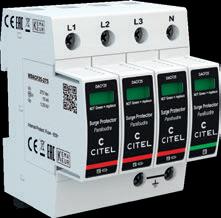


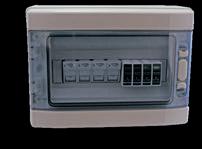
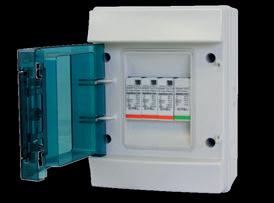






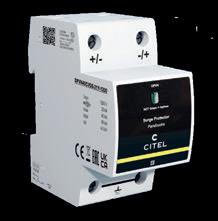
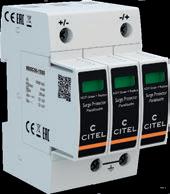

Explore Gary Banfield, Technical Lead at Webro’s guide to choosing the right alarm cables for optimal security. Understand Type 1, 2, and 3 cables, British Standard compliance, and installation tips to protect property effectively.
We’re now coming to the time of year when the weather is warmer and brighter, and we spend more time outdoors away from our home.
As nice as this is, we should be mindful of the increased risk of leaving our personal properties unattended. One of the most effective deterrents is to have a good quality burglar alarm system installed. For it to deliver total reliability, the system will need high-quality cable to form its connectivity backbone. That said, alarm cables come in a variety of options and choosing the right cable can be critical to the longevity and reliability of the alarm system.
Webro alarm cables are designed and manufactured to the British Standard BS 4737-3.30:2015, and there are three types – Type 1, Type 2 and Type 3. Within these, the conductor material, insulation and sheath materials used are highlighted. Most importantly, the maximum resistance of the conductor is shown. This development was added to the standard to give clarity several years ago to reduce the prevalence of cables passing off as having copper conductors when they were clearly manufactured from aluminium.
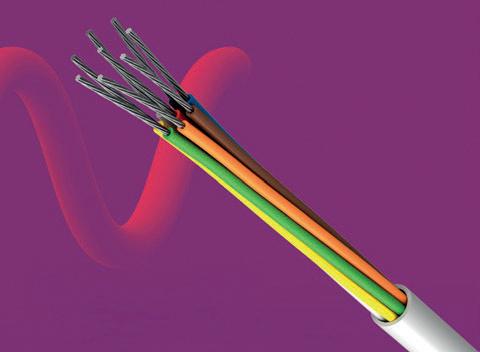
Below we look at the varying types of alarm cables and what the benefits of each one are, highlighting Type 1, 2 and 3 alarm cable differences:
• Type 1 – maximum 100ohm/km in LSNH. This type of alarm cable has a maximum conductor resistance of 100ohm/km, which can only be achieved using copper conductors. These conductors are tinned to stop them corroding during their lifetime, and to aid flexibility. All Type 1 cables are produced using Low Smoke Non-Halogen (LSNH) materials for the insulation and sheath and are suitable for installation in public buildings.

• Type 2 – maximum 100ohm/km in PVC. Like Type 1 alarm cables, these also use copper conductors with a coating of tin, but they’re made entirely from PVC (Polyvinyl Chloride) materials. PVC is slightly more flexible than LSNH but when burnt it releases black smoke and harmful gasses. Type 2 cables are recommended for single dwelling units (SDU’s) such as homes, but not for public buildings.
• Type 3 – maximum 155ohm/km in PVC. Type 3 alarm cables have been designed to meet a budget; the maximum conductor resistance permitted is 155ohm/km, which is 55% higher than Types 1 and 2. These cables are usually manufactured using aluminium instead of copper, which is coated in tin to give it extra strength and reduce the risk of corrosion. These cables are all manufactured using PVC materials and have been designed for short runs. It should be noted that they can cause frustration if the installer is familiar with installing copper as the conductors can be brittle and prone to breaking when terminating. The higher resistance can also affect signals over longer distances, and aluminium, if wet and mixed with oxygen, can corrode easily.
Webro has introduced external versions of these cables to further enhance their ability to be used outdoors, where they’re most commonly clipped to exterior walls or fencing. They’re designed using Type 1 and 2 conductors but have a black polyethylene (PE) sheath that’s waterproof and UV resistant.
All types above can come with an overall aluminium foil screen with a tinned copper drain wire to reduce electromagnetic interference from external signals.
The British Standard is very clear on the requirements for these cables when it comes to labelling. They must be clearly marked with the manufacturer’s name, the British Standard number, cable type, length in metres, conductor construction with maximum resistance value, and the date and batch number for traceability.
Webro, webro.com





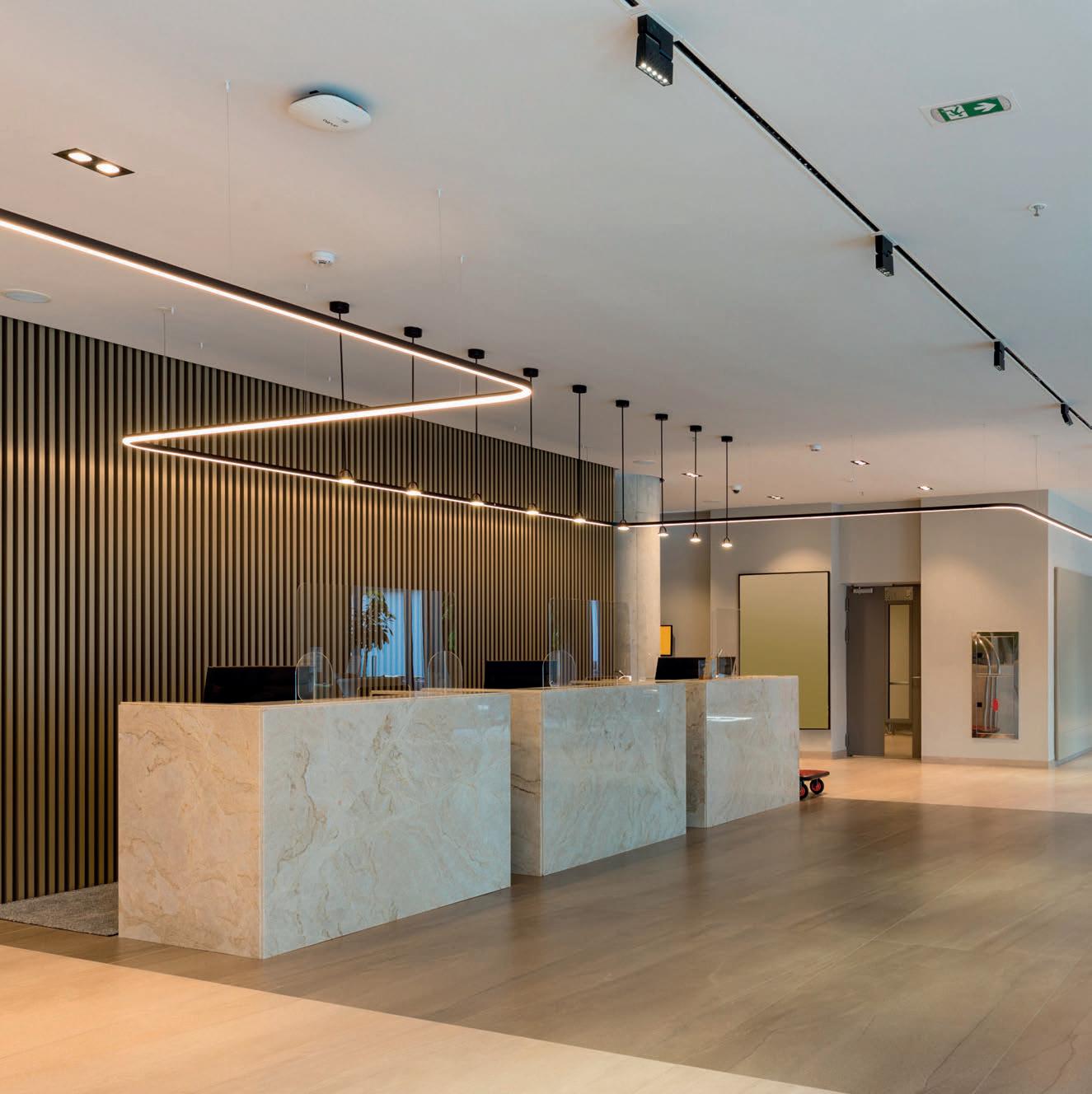


Since emerging onto the market in the early 2000s, LED strip lighting has truly evolved – moving from being used as decorative or accent lighting to being utilised as high-brightness task lighting, replacing fluorescent and halogen bulbs, right through to set design, and even growing plants.
This highly flexible lighting product can be, and now is, used almost anywhere and Ansell Lighting’s recently launched LED-Cell Strip range –thought to be the most comprehensive offering on the market – reflects that.
In simple terms, an LED strip or tape is a flexible circuit board populated by surface-mount light-emitting diodes (SMD LEDs) and usually comes with an adhesive backing. The higher-power SMDs now used in strip lights have helped to make it such a versatile lighting option.
The increased popularity of LED strip lighting led Ansell to make a significant investment in its LED-Cell Strip range to offer solutions for as diverse a range of applications as possible. The result is
eight unique product collections, as well as smart options, an LED Strip Calculator and multiple sizes – enabling it to address every project need.
Ranges include COB, dim-to-warm, eco, high efficiency, single cut, professional, ultra long and irregular bends, meaning specification for most industrial, commercial, hospitality, retail and residential settings are covered.
Colour choices are also well catered for with RGBW, RGB, RGBTW and single colour options available across the ranges as well as IP20, IP65 and IP67 durability ratings.
All of Ansell’s LED-Cell Strip products are supplied with a self-adhesive back which makes them easy to install without the need for additional adhesive or fixings.
Many in the range also feature fast-fit ‘plug and play’ connectors to remove the need for time consuming soldering.
For the ultimate in functionality, all LED-Cell strip lights are also OCTO compatible, so can be Bluetooth and WiFi enabled, and WiZ or Casambi enabled, as well as offering voice activated compatibility. The whole range also comes with either three or five-year warranties.
The first collection in the strip range is C-Cell – a COB continuous output strip that delivers an enhanced aesthetic appearance. Unlike many strip lights, C-Cell gives out seamless continuous light, so it is dot free, ideal for residential, hospitality and retail applications. Available in single colour, RGB and tunable white in a range of lengths up to 50m.
D-Cell is a range of dim-to-warm strip lights, providing applications such as residential and hospitality with great versatility. When undimmed, the 3000K colour temperature is ideal for task lighting

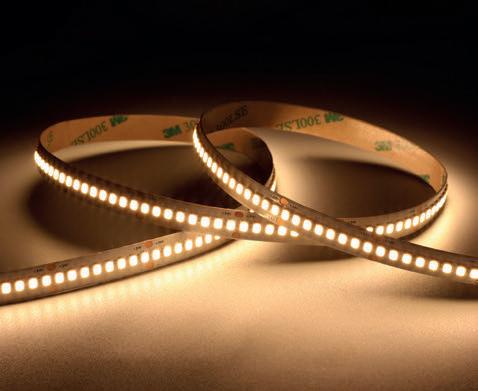
but when dimmed the 1800K output provides a more relaxed and intimate aesthetic.
Available in 5m lengths with multiple connector packs available separately.
Providing an eco-option, E-Cell is a traditional LED strip ideal for general use.
High LED density of 196 LEDs per metre, it provides a uniform output with single colour, RGB and RGBW options and lengths of 5, 10 and 50m.
H-Cell is a high efficiency option suitable for high-end residential, retail and commercial applications. It delivers strong levels of illumination which can replace existing main source lighting, whilst providing great energy saving benefits.
The high density of 240 LEDs per metre and a high CRI also reduces spotting and provides a more seamless light output. IP20, IP65 and IP67 versions are available for maximum versatility.
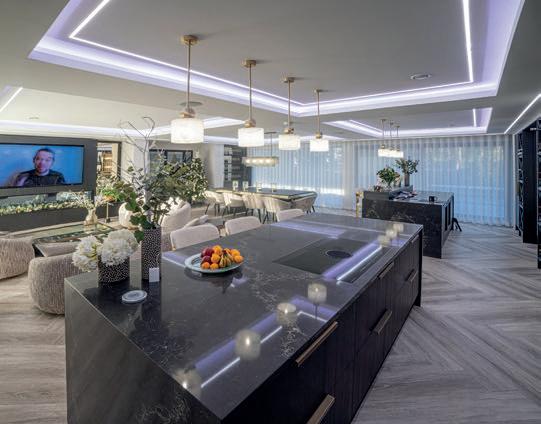
K-Cell is suitable for high-end residential, hospitality and retail applications and features extremely small cutting points (5.55mm for 5W and 8.33mm for 14W) enabling users to get an exact cut to the length required where accurate and precise light placement is paramount. High CRI 90 ensures the highest quality white light output.
Designed for peak performance, P-Cell is a professional LED strip with super high efficacy, helping to reduce overall energy consumption in large scale installations. It also features an extensive range of colour temperature options, IP ratings and the power options of all Ansell strip products for the ultimate in flexibility and versatility. Ideal for internal and external installations where power supply locations are few and far between, U-Cell is an ultra-long LED strip available in lengths of up to 50m, which can be run from a single power supply – ideal for external applications where power supply locations can be scarce.
For the ultimate in flexibility Z-Cell has a distinctive PCB design which allows the strip to bend on the horizontal plane without the need for connectors – so it can be used on installations featuring corners or bends without breaking or being damaged, and maintains continuous light without dark spots. Single colour and RGBW versions are available, with lengths of up to 50m.
With all this choice Ansell was keen to make installation as simple as possible for users, and so has introduced its LED Strip Calculator, to streamline the process of choosing the correct strip and accessories.
Helping to navigate the vast array of products there is to choose from with a simple step-by-step process, users simply enter their specification requirements into the LED Strip Calculator, hosted on the Ansell website, and all the necessary parts required will be worked out automatically, even recommending what drivers and accessories you need. The calculator then produces a downloadable summary of everything you need to order.
A full product brochure, complete with step-by-step guide on how to select the right products for your project is also available for download on the website.
For those who need something more bespoke, a strip-cutting service is also available, designed to meet specific project requirements with precision and excellence.
Mark Abbott, Managing Director at Ansell Lighting, says, “Strip lighting is an incredibly versatile and popular source of lighting. Ideal for use in almost any setting – both commercially and in residential properties – we are thrilled to be able to offer our customers the most comprehensive choice of products on the market.
The flexibility of the Ansell Lighting LED-Cell Strip collection is perfectly showcased in a recently completed, high-end residential project.
The homeowners wanted to add depth to the lighting design in the modern house, highlighting features such as recessed ceiling panels, the stunning staircase and creating a fun but safe ambience in the swimming pool area.
In the entrance hall and staircase area, K-Cell strip was used to enable the installer to be as precise as possible. The strip, which has extremely small cutting points, was used to edge each step on the staircase and the wider entrance steps to perfection. And, thanks to the high CRI, which provides the highest quality white light output, the lighting was sufficient to only require a decorative pendant over the staircase and C-Cell strip in the recessed ceiling.
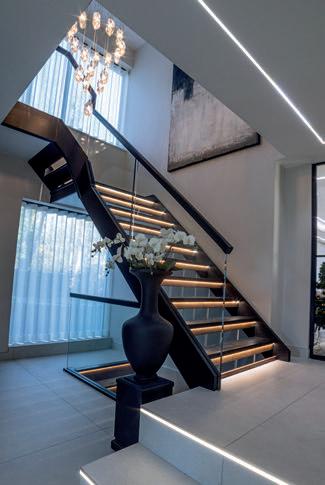
The professional P-Cell strip with OCTO, powered by Casambi, was installed in the swimming pool area. The range of IP ratings available on P-Cell means it is suited for wet areas such as a swimming pool, and adding OCTO to the installation enabled the homeowner to not only control the lighting by voice control and use smart setting, but to change the colours within the pool area depending on their mood or the occasion!
In other areas of the home – including the kitchen, dining area and lounge – the ultra-flexible Z-Cell strip was used to create the wow factor. Z-Cell has a distinctive PCB design which allows the strip to bend on the horizontal plane without the need for connectors – so it can be used on corners or bends without breaking and maintaining continuous light without dark spots. In this project it was used to full effect on the recessed ceiling panels in the stunning wine display cabinets and on a standout circular ceiling feature in a hallway.
“From functionality to colour temperature, length and efficacy, our strip lighting range meets every objective required and, most importantly, we have introduced further support for our customers in the shape of the calculator and bespoke cutting service in order to make using LED-Cell Strip as straightforward as possible.”
Ansell Lighting, ansell-lighting.com

Two luxury holiday resorts in Spain have made a massive step forward by decarbonising, thanks to installing a new ‘automated’ building management system solution across their buildings to make them ‘green’.
Club Med Magna Marbella in Andalusia and Golden Bahía de Tossa & Spa in Catalonia were looking to update their four-star hotels with the latest modern building technology.
Spain is one of the most popular holiday destinations in the world with around 70 million tourists visiting the country every year thanks to its beautiful beaches, stunning scenery and fabulous food.
The travel industry contributes to more than 60% of Spain’s GDP, however, the sector’s energy consumption worldwide is high. Research has shown that 8% of global CO2 emissions are attributable to transport, accommodation, catering and leisure activities during holidays.
With plans to decarbonise the entire European Union, the challenges in Spain’s tourism centres are also increasing. Greater energy efficiency for cities, holiday resorts and even zero emissions for new construction projects are crucial to success.
Air conditioning, lighting and hot water account for around 80% of the energy consumption of tourist accommodation. On average, a hotel consumes between 100 and 200kWh of electricity per square metre, per year.

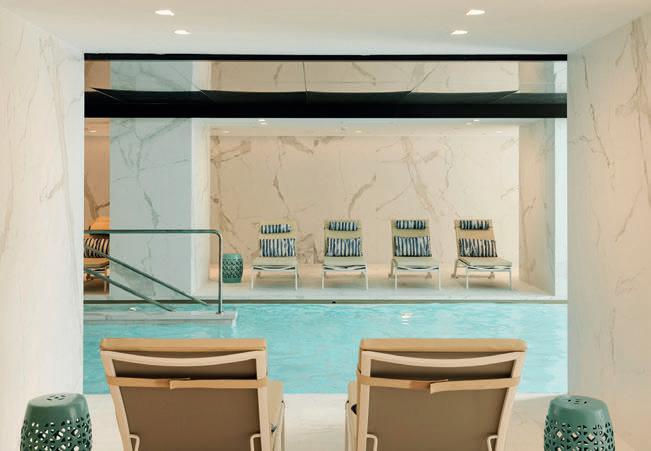
Sacrificing comfort to save energy is not an option for hotels, so many are now turning to technology to help make their buildings more energy efficient so their carbon footprint can be reduced.
Club Med Magna Marbella and Golden Bahía de Tossa & Spa commissioned building automation and lighting controls specialist B.E.G. to work with the hotels on integrating occupancy sensors and KNX technology in their buildings.
Paul Jones, Sales Director of UK & Ireland at B.E.G. UK, says, “By networking components such as photovoltaics, heating, air conditioning, ventilation, lighting, emergency and access systems, all building functions are interlinked and form an automated, coordinated unit.
“Building automation helps to lower energy consumption, reduce operating costs, and manage buildings sustainably. Automation is, therefore, the basis for every ‘green’ building. It is estimated that the hotel sector alone could reduce its energy costs by up to 40%.”
For holiday accommodation providers overall, investing in climate protection measures can be considered an investment in their own future. Experts say tourism is more dependent on an intact ecological and social feel-good environment than almost any other industry.
Paul adds, “Guests continue to enjoy the already luxurious holiday pleasures at both hotel resorts. The management can count on consumption savings thanks to the proven, stable, and secure KNX bus system. Many functions that previously could only be set up by rewiring can now be changed easily and digitally. This opens up new flexibility in room utilisation and a wide range of setting options.”
Club Med Magna Marbella and Golden Bahía de Tossa & Spa are hoping that their projects can act as a positive example for the entire tourism industry – not only in terms of economic efficiency and increased comfort, but also for the environmental balance of holidays.
B.E.G., beg-luxomat.com






Sanu Davis, Co-Founder of Cosmicnode, explains how technological advancements are helping to make buildings smarter, creating measurable benefits for building owners and managers alike.

Efficiency and energy savings are the driving factors for creating smarter buildings that reduce operational cost and optimise space.
At the heart of this revolution are systems that help to manage energy usage and yield a reduction in realistic running costs –based on data and occupancy monitoring.
These systems rely on interoperability and data-driven insights to empower and enable building managers to gain greater insights and control over each discreet system, from HVAC, air quality, lighting, security, occupancy monitoring, and emergency lighting testing protocols. A single control system enhances and unifies maintenance and management, providing detailed visibility of each system, which is achieved through unprecedented data collection and real-time insights.
The creation of enterprise-level, multi-tenant and multi-site, cloud-connected management systems offers advanced lighting control and monitoring solutions for large-scale lighting installations. Every luminaire becomes a digital data point, allowing

for in-depth monitoring, reporting and predictive maintenance by the facilities management team.
However, utilising luminaires to become smarter and more intelligent is just part of the puzzle. Facilities managers also need to monitor other systems within workspaces to ensure optimal conditions for healthy, happy occupants: Air quality, humidity and temperature, as well as lux levels, play equal parts to ensure a healthy and more productive environment. These systems can be connected via smart sensors to collect key environmental metrics that enable building managers to make key decisions, based on real-time and historical insights. The tracking of these assets undoubtedly facilitates better management of the building through the elimination of inefficiencies.
Automation of these distinct and important areas of a building’s environment becomes possible with the integration of IoT-enabled smart systems, which helps to achieve operational efficiency and significant energy savings.
The implementation of occupancy sensors that activate HVAC and lighting systems as needed contributes to both energy and cost savings, while automated control of lighting, temperature and air quality based on occupancy levels further assists in maximising energy usage.
Utilising IoT data analytics provides some additional benefits when it comes to improving maintenance practices and enabling predictive decision-making to achieve cost savings. Predictive maintenance covers everything from battery life, luminaire health and life expectancy, temperature monitoring to prevent premature burnout, and the detection of other potential failures –before they happen.
The ready availability of these data analytics also enables building managers to stay ahead of the regulatory and compliance procedures that are often a key part of their role. Being able to efficiently plan, execute, monitor and report on the status of emergency lighting systems is another way for facilities managers to
proactively manage and maintain a key system in the building.
The frequency at which emergency lighting is tested can vary depending on system type (i.e. maintained emergency lighting or non-maintained), but it should be tested monthly via a flick test, as well as the annual ‘full duration’ test, stipulated by the 5266-1 regulation. Full EML lighting discharge tests can take up to six hours per circuit – a significant time and cost investment, particularly if an external contractor is required.
DALI-based automated, wireless emergency self-testing solutions conform to the IEC 62386-202 standard, providing facilities managers with the peace of mind that they are compliant with current regulations while saving huge amounts of budget and time.
A wireless, cloud-based connected platform can remotely monitor the status of all lights in real-time, detecting any faults or failures instantly. This reduces the need for regular manual inspections, saving both time and labour costs. Wireless systems like this also have the capability to schedule both functional and duration tests for DALI emergency lights.
Self-testing solutions are enabling facilities managers to streamline the process from the comfort of a desktop, with automated scheduling and reporting, including the scheduling of all functional and duration tests. This functionality enables pinpoint accuracy on the location of system faults, through floorplan visualiser and comprehensive reports and archiving capabilities, providing an increased layer of insights for building managers.
The incorporation of smart technologies is undoubtedly helping to revolutionise building management and all the related benefits that come with eliminating waste, ensuring compliance and streamlining system usage to match occupancy requirements. Early adoption of these technologies will help businesses to reduce their carbon footprint and stay ahead of the curve.

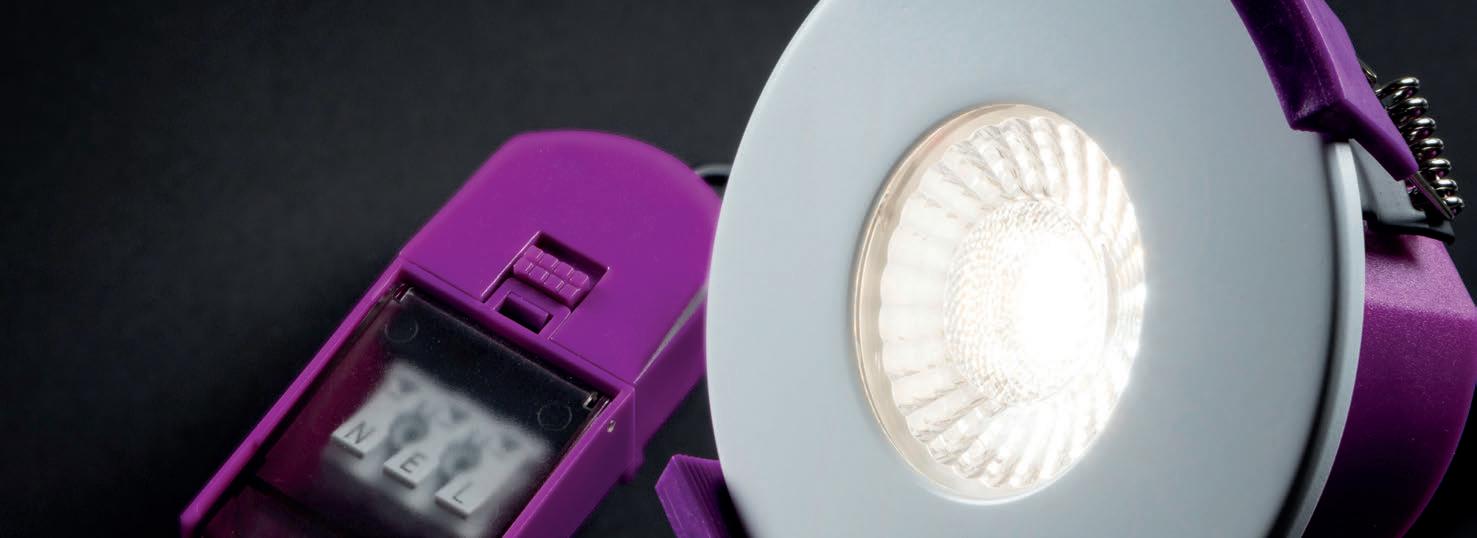
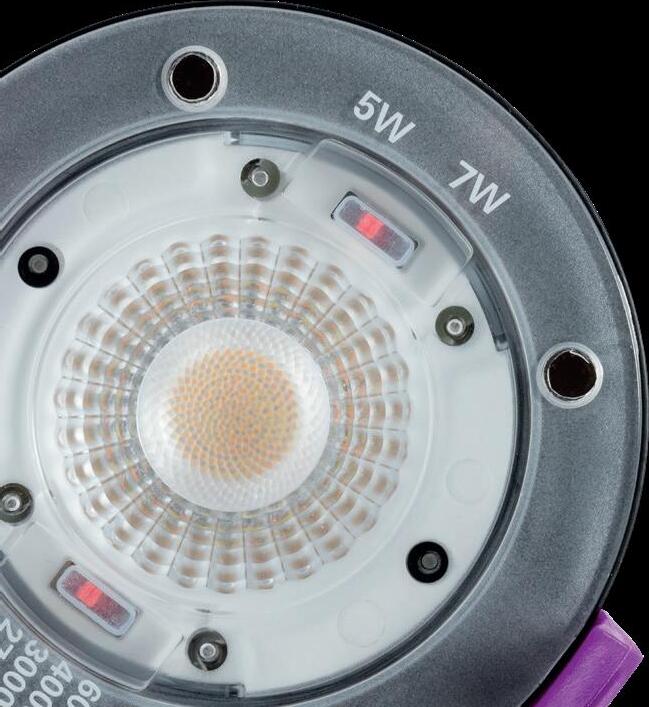
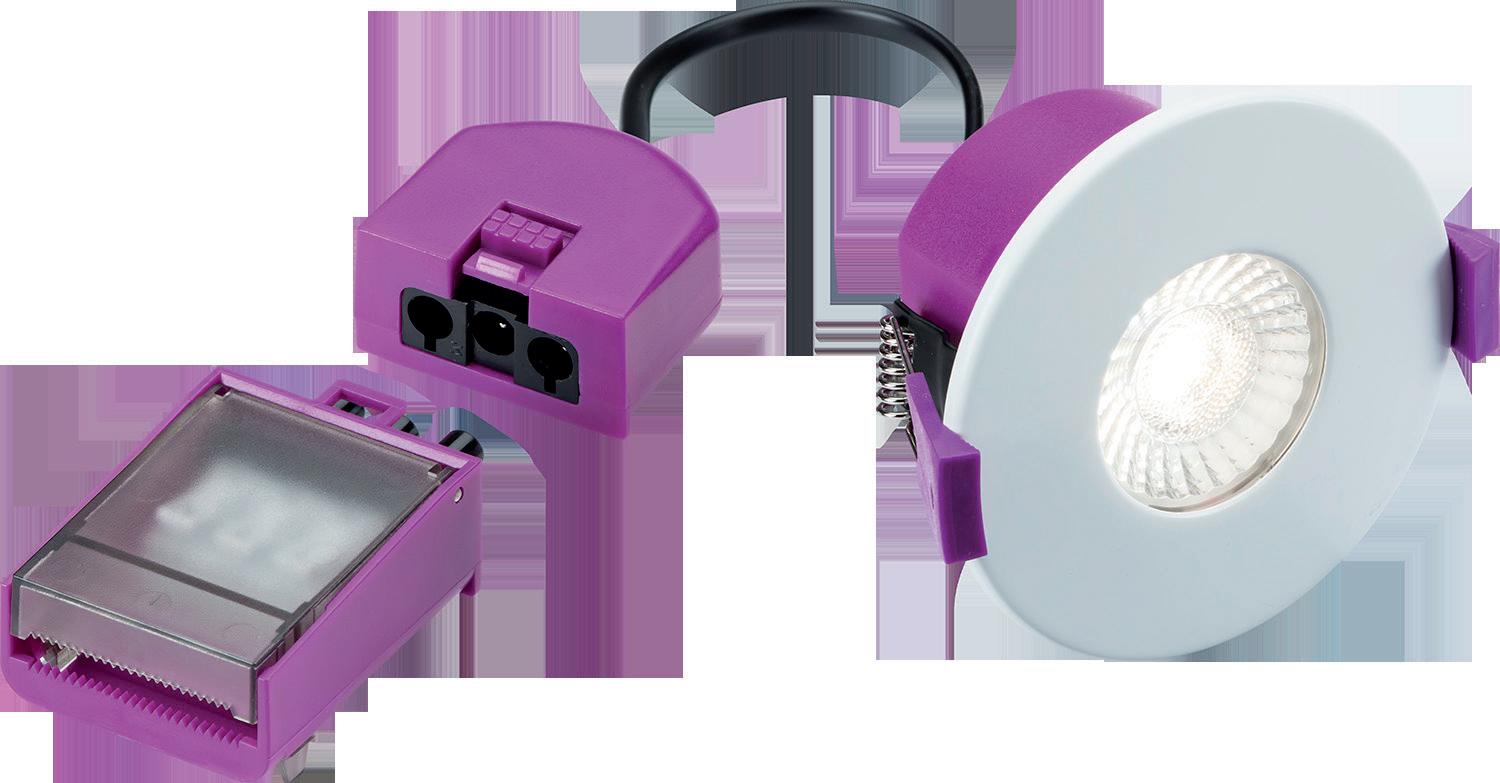
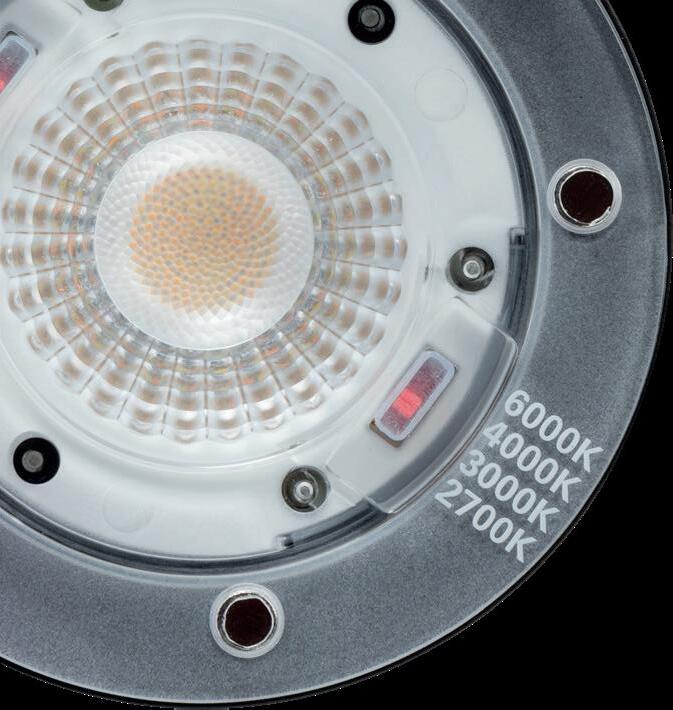

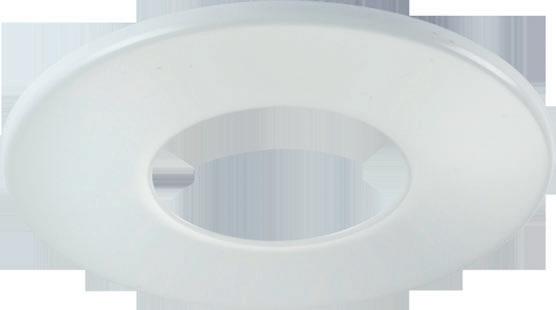











Most of the discussion about smart home systems naturally focuses on benefits for the end user. But what about the business case for the installer? Sophie from specialist distributor Ivory Egg discusses the business case for working with KNX and building a successful smart home integration business with Suzanne, owner of integration business, Dmoti
Sophie: How long have you been working with KNX and what got you involved?
Suzanne: We’ve been working with KNX for just over 10 years now, and it all started as we wanted to add building intelligence into our own home. We did our KNX Training with Ivory Egg and after completing our project, friends who were having a property built asked us if we could work on theirs and Dmoti was born.
As a former IT consultant, when I started a family, I wanted to do something that combined my technical and analytical skills and gave me a work/life balance. With a love of renovation and construction,

and with experience in IT, getting involved with KNX gave us the perfect opportunity to create the business we have today.
Sophie: What smart technology solutions are most in demand from customers?
Suzanne: I am increasingly being asked for energy monitoring solutions, especially in the last three years. I am based in France, and due to a law that has been passed that mandates by 2027 every building with more than 70kW of energy production from heating, cooling hot water etc must have a control system, I am seeing a lot more enquiries coming through, especially from hospitality businesses.
KNX manufacturers have been releasing more products that enable integrators to provide effective and efficient energy management solutions, including visualisation which is highly sought after.
The fact that KNX can integrate with so many facilities, functions and services means that we have the flexibility to connect and control an almost indefinite number of solutions that are tailored to the project’s specific requirements.
Sophie: What opportunities does working with KNX offer you?
Suzanne: I think one of the big misconceptions is that to be successful with KNX you need to be working on mega mansions or city penthouses. A lot of my business comes from building trust with our clients on smaller projects, delivering on their needs and expectations and then being asked back when they have the budget to do more work, or when their requirements change. Using KNX means that I can revisit a project many years later and add on more functionality as needed.
I also work on ‘rescue’ projects. I once had a KNX project where I fixed some issues before the house could be sold. This client then went on to build a new house
and asked me to do the work, including whole home control and AV purely based on the fact that I could fix the initial problems with the house they sold.
Often being a KNX expert has meant that we are the only integrator people call or recommend as our expertise is in demand – we’re well known for KNX, and we get to choose what work we take on.
Sophie: What business benefits do you see from working with KNX?
Suzanne: Working with KNX offers us complete flexibility to work on projects of varying scope. One day I can be working on a simple family home, the next I can be working on a vineyard or a hotel. The fact that KNX is an open protocol means we are unlimited in the solutions we can offer.
Working with KNX also enables us to focus our business in whichever direction presents the most opportunities – we’re not tied to a niche or limited to offering certain services.
Establishing yourself as a KNX expert also means you build relationships that also generate future business opportunities.
Sophie: What advice would you give someone interested in working with KNX?
Suzanne: Training is so important. Invest in some products to make a test rig and gain confidence and experience by spending time testing what you’ve learned in a pressure-free environment. Finally, build good relationships with industry peers and suppliers as their support and knowledge are invaluable.
For more information about getting started with KNX training online, email training@ivoryegg.co.uk and quote ‘ECN-JUNE’ for a discount.
Ivory Egg, ivoryegg.co.uk


♦ A new range of passive infra-red occupancy detectors, switches and dimmers
♦ Ideal for energy-saving automatic lighting control
♦ Quad digital person detector with adjustable photocell and time lag functions

♦ A range of versions for different mounting options, detection areas and mounting heights
♦ Versions for Mains Switching, DALI or 0-10V dimming





Ceiling flush-mounted versions, ideal for false or plasterboard ceilings.















Versions with mini detector head, ideal for false or plasterboard ceilings, or for fitting into a luminaire. Separate power pack with connector.



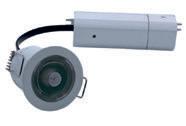
A range of surface mounted versions for high bay applications or for regular mounting heights.

Batten-mounted versions, with 20mm threaded spout for fitting onto a luminaire.


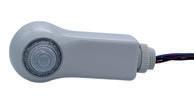

For mounting onto a solid ceiling or onto a range of different mounting boxes.
Options for wide area detection and for storage aisles.

All settings and adjustments made via the DANLERS ISI app with easy and secure programming For






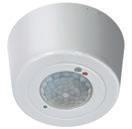

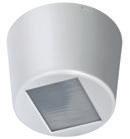

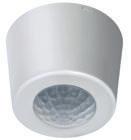




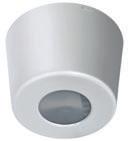




With the smart-home market worth an estimated £1.2 billion according to the latest Integrated Home Market Analysis[1] from industry association CEDIA, and with further growth across the smart tech sector expected in the next 12 months, the business opportunity is clear. What may be less clear is the fact that electrical contractors are perfectly placed to benefit from this opportunity – and a number of forward-thinking businesses are already making the transition.
One example is Penkhull Electrical, a Staffordshire-based electrical contractor that has recently made the move from offering traditional services around designing, installing and maintaining electric systems to becoming a Control4-certified systems integrator that delivers intelligent, smart-technology spaces in commercial and residential projects.
Greg Smith, Director at Penkhull, explains how the idea came about: “We incorporated in 2019, however, Penkhull Electrical has been around since the 70s, headed up by my late father. It was lockdown that made us stop and think, ‘What do we do and how do we set ourselves apart from other companies?’. This then prompted us to do something different that nobody else does in Stoke. And that’s where the idea to get behind smart technology stemmed from.”
The company was also encouraged by an existing client introducing Penkhull to the smart automation platform, Control4, a Snap One brand. Greg adds, “A customer we did electrical work for told us they were interested in Control4 and asked if we could do it. We thought, ‘Why not?’. There was something about the product, what you can do with it, what can be achieved, and the scalability of it that opened up huge possibilities for us. It made us realise that this was the direction we wanted to take our business.”
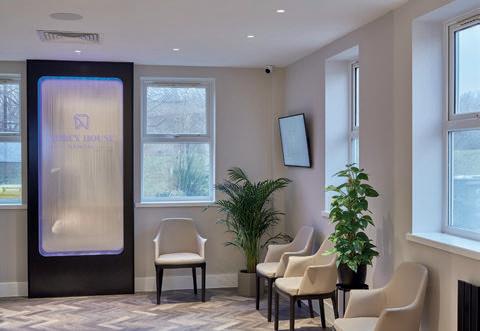
Penkhull created an

After completing Control4’s Professional Certified Network Administrator training programme, which ensures integrators have the tools, knowledge and hands-on skills needed to design, implement and manage the network needs of smart spaces, Penkhull Electrical has discovered a booming industry with opportunities not just in smart homes but also in light commercial, or ‘resimercial’, spaces.
One recent project of note is Abbey Dental in Stoke, which has transformed its practice with a whole host of equipment provided by Snap One brands, integrated onto the Control4 platform for ease of operation and control. This not only ensures patient comfort and safety but also makes the workplace better and more efficient for employees and offers additional opportunities for the practice.
Greg explains, “We met with the owner of the practice, and I asked him what he wanted to improve. He said ‘I don’t like that I’ve got to go round and switch all the TVs and all the lights on in the morning; I don’t like how every time there’s a knock at the door, the receptionist has to get up and answer it; I don’t like how I can’t easily control the lighting in the practice; I don’t like how I’ve got to go outside and switch the compressors off at night, that I can’t do it from inside the building’. He was also keen to create a training facility that people can rent out, but he knew that somebody would always have to be on hand to set users up. So, I showed him Control4, how it could eliminate all these pain points for
the practice, and we built a system design from there.”
Penkhull created an integrated solution based around Snap One solutions, encompassing network infrastructure, security, lighting, audio visual and temperature control. The Snap One brands featured in the installation include architectural in-ceiling loudspeakers from Triad, network switches from Araknis, media distribution technology from Binary, and CCTV devices from Luma, all integrated with devices from other brands using Control4. The company also manages the network using the OvrC remote management and monitoring software built in to the Control4 platform “so we know exactly what port does what and if I’m away I can just boost it, reset it, do whatever is required,” Greg adds.
Abbey Dental also has a space set up for streaming. “The practice has rooms that are enabled for streaming so we can stream from downstairs to the conference room upstairs. They can actually see and hear what’s going on in that room, and they can hear it perfectly,” Greg continues.
While Penkhull is undoubtedly growing its business with its newfound knowledge of smart technology, Greg accepts that this takes work: “Granted it has been a little bit of a slow burner for us, but we’re learning, we’ve built our portfolio organically, and it’s going from strength to strength.”
Snap One, snapone.com
[1] CEDIA Smart Home Analysis
Snap One has introduced its new outdoor lighting solution, Episode Radiance. This bollard-style solution not only enhances the aesthetics of landscape installations but also provides advanced control options, opening up new possibilities for outdoor lighting design.
According to the 2023 Professional Smart Home Market Analysis[1] report by CEDIA, many smart home integrators expect the segment to be one of the biggest growth areas over the next 12 months, along with media rooms, home cinema and lighting/shading.
In recent times, clients have shown a willingness to invest in a whole range of features to help them extend hours of use and the enjoyment that an outdoor space can provide. Quick-drying, comfortable outdoor furniture, fire pits, lighting, and waterproof pergola roofs and canopies are all now potentially realistic investments. Electrical contractors are well placed to help transform these spaces and breathe new life into garden entertainment for their customers with a growing range of technology options to enhance the outdoor experience.
Snap One already offers an extensive selection of outdoor audio products across two speaker brands – Triad and Episode.

The range is built on
Snap One’s exclusive, patent-pending technology
The Triad Garden Array is a family of premium, all-weather landscape speakers that are the perfect combination of elegance, sound and durability. Meanwhile, Episode outdoor speakers include a broad selection of landscape, mounted and rock speakers, all-weather soundbars and burial or hardscape subwoofers for great sound and installation flexibility across 8Ohm, 70V or hybrid systems.
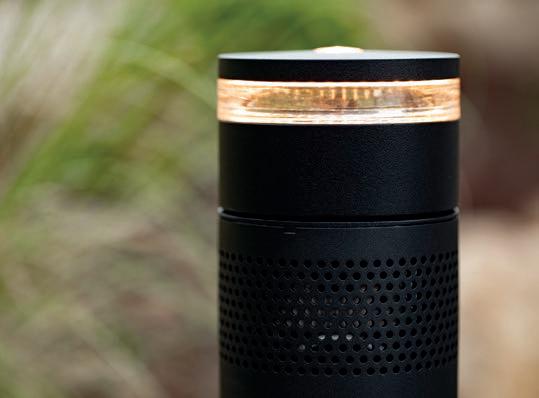
The company recognises the importance of staying ahead of outdoor trends and invests to make sure that its partners can meet their customers’ expectations and maximise the business opportunity. For this reason, Snap One launched Episode Radiance, an outdoor bollard style solution that opens up new possibilities in landscape installation and control.
The range is built on the company’s exclusive, patent-pending technology which combines both an audio signal and a low-voltage lighting signal on a single, easy to install two-conductor burial wire. The design of the bollard speaker will allow for a 360° radiating sound signature compared to the more focused directional sound signature of today’s landscape product offerings. Perfect for small to medium size outdoor environments (<3,000ft2) but scalable to suit any size space, Radiance is a modular solution where the lighting can be added to speakers or speaker blanks for flexible placement and usage.
To simplify installation, the full range of bollards within Radiance are designed for 70V amplification. Selectable 70V tap settings allow for detailed tuning and balancing of the sound at each bollard, which means the individual volume can be set while the entire system is adjusted as a whole. The subwoofer utilises a 10in long-throw woofer mounted in a completely sealed cabinet, allowing for both above-ground (hardscape) and in-ground (burial) installation. The line-up
is offered in either black or white finishes to complement a wide variety of tastes and designs. And, for a lifetime of dependable entertainment, each model is finished in a UV-protected finish and is IP66 certified.
The lighting installation is just as simple as the speaker. Power for the lighting can be supplied from any off-the-shelf low voltage transformer, delivered over the same two conductor wire used for the audio signal. The patented technology supplies distortion-free audio signals while delivering ample power for the lighting modules.
Multiple LEDs in the light module will output up to 300 lumens depending on the setting (path, spot or both). From wall wash to direct path lighting, the options offer a wide variety of lighting solutions, with the simple, classy shape of the speaker working well in any landscape lighting design.
As an additional benefit, the Radiance System does not require any special control programming to operate. Each feature, lighting and audio, are separate functions and can be independently controlled and integrated into a Control4 automation system.
By combining audio and lighting into a single, quick and easy to install and control solution, Radiance is a game-changer for outdoor spaces. Existing Partners can learn more at dealer-emea.control4.com.
Snap One, snapone.com
[1] CEDIA Integrated Market Home Analysis 2023
Amit Ravat, Managing Director of Lithe Audio says that, in the ever-evolving world of electrical contracting, staying ahead of the curve means constantly searching for innovative ways to expand your service offerings – with ceiling speaker installation being one of them.
One often overlooked but highly lucrative opportunity lies in the installation of ceiling speakers. This not only serves as a substantial value-add for your clients but also opens up a new revenue stream for your business. With products like Lithe Audio’s wireless speakers, which are designed for easy integration into either new builds or existing structures, the process is simplified, requiring minimal rewiring and disruption.
Ceiling speakers offer a seamless audio solution that can enhance the functionality and aesthetic of any space. Unlike traditional speakers, ceiling speakers blend into the decor, providing an unobtrusive way to enjoy high-quality sound without taking up any floor space. This is particularly appealing in environments such as kitchens and bathrooms.
For clients, the appeal of having a sophisticated audio system integrated directly into their home or business environment can significantly increase their property’s value and their quality of life or work. Furthermore, as smart homes and integrated technologies become more commonplace, the demand for advanced installations like ceiling speakers is only set to grow.
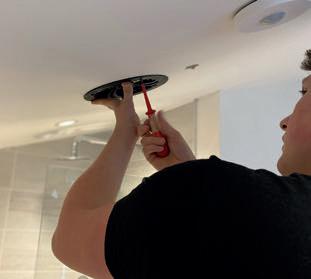

By incorporating ceiling speaker installations into your service portfolio, you position yourself as a forward-thinking electrician capable of not just electrical installations but also enhancing home automation and multimedia setups. This diversification can make your business more attractive to potential clients who are looking for comprehensive solutions under one roof.
Installing ceiling speakers can be surprisingly straightforward, especially with systems designed for ease of installation like those from Lithe Audio. These speakers are designed to fit into a building’s existing structures, which means they can be installed without the need for extensive rewiring or structural modifications. For electricians, this means less time and labour per job, allowing for more installations to be completed in a shorter time frame. For clients, this means minimal disruption and mess with the installation.
Lithe Audio’s wireless ceiling speakers are a game-changer for both electricians and clients. These speakers come with built-in amplifiers and receivers, eliminating the need for separate components. The wireless nature of
these systems means they can connect directly to most audio sources, including smartphones, tablets and home AV systems, without the need for additional wiring. This is particularly advantageous in retrofit projects where additional wiring can be disruptive and costly.
Moreover, the simplicity of the installation process allows electricians to undertake multiple projects quickly, maximising productivity and profitability. The ease of integration into existing systems means that you can offer this service to a broader range of clients, from those renovating their homes to businesses looking to upgrade their premises.
As you venture into the installation of ceiling speakers, marketing your new service effectively is crucial. Highlight the benefits of ceiling speakers in your promotions, focusing on the aesthetic, functional and value aspects. Before-and-after scenarios, case studies and testimonials can be powerful in showcasing the transformations enabled by ceiling speaker installations.
Additionally, consider partnering with home builders, architects and interior designers who can recommend your services to their clients.
For electricians looking to expand their service offerings and tap into new revenue streams, ceiling speaker installations represent a promising opportunity. Products like Lithe Audio’s wireless speakers simplify the process, making it an attractive option for both new builds and renovations. By embracing this technology, you can enhance your skill set, meet growing market demands and provide your clients with cutting-edge solutions that significantly add value to their spaces. Embrace the future of electrical installations and consider how adding ceiling speakers to your portfolio can elevate your business to new heights.


Bespoke spiral PUR and PVC cables made to your specification in white, grey, black or colour of choice. We are also the only UK manufacturer supplying textile braided spirals in a range of over 140 finishes.
For sales and enquiries please contact us at +44 28 9079 2155 info@flexform.co.uk flexform.co.uk FlexformCables flexformcablesltd





Power
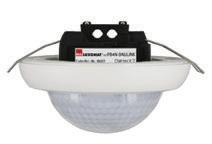



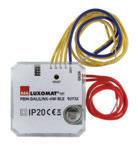



DALI Multisensor
DALI Multisensor
PBM-DALI-LINK-4W-BLE Part no. 92732 DALI
■ Addressable multi-master Lighting Control System
■ Addressable multi-master Lighting Control System
■ Supports DALI and DALI-2 luminaires
■ Supports DALI and DALI-2 luminaires
Part no. 92846
PS-DALI-LINK-FC Part no. 92846
PBM-DALI-LINK-4W-BLE Part no. 92732 DALI Power supply
PS-DALI-LINK-FC Part no. 92846
PS-DALI-LINK-FC Part no. 92846
PD4N-DALI-LINK Part no. 93377 DALI push-button module
DALI push-button module
PD4N-DALI-LINK Part no. 93377
93377
PD4N-DALI-LINK Part no. 93377 DALI push-button module
PBM-DALI-LINK-4W-BLE Part no. 92732
■
■ Ideal for re trofitting
■ Ideal for re trofitting
■ Ideal for re trofitting
■ Super flat multisensor available
■ Super flat multisensor available
■ Super flat multisensor available
■ Simple, intuitive operation
■ Simple, intuitive operation
■ Simple, intuitive operation
■ Fre e Bluetooth app with 2 functions:
■ Fre e Bluetooth app with 2 functions:
■ Fre e Bluetooth app with 2 functions: - Scene control for end customer - Commissioning tool for installers
- Scene control for end
- Scene control for end customer - Commissioning tool for installers
The evolution of lighting controls has significantly contributed to the ability to improve the intelligence and sustainability of the built environment. Here, James Huntington, OEM Controls and Solutions Manager for Tridonic, shares some examples of recent successes that showcase this in practice.

Lighting control is fast becoming a must-have element of projects that seek to improve the eco-credentials of a building. By optimising the energy performance of a lighting system, that provides the right lighting levels only when required, lighting control can have a noticeable impact on reducing unnecessary energy consumption.
This was evident at a recent project to renovate the MET Building in the heart of London, where Tridonic partnered with lighting firm Silent Design to create a cutting-edge system.
Located in London’s Fitrzrovia district, the MET Building offers 168,843ft2 of luxurious office space.
The building owner wanted to create innovative and technologically advanced spaces that allow users to maintain their own areas easily, while also having the ability to change settings as required, which was achieved by using Tridonic’s sceneCOM Evo system. The installation was completed by electrical contractor Bridgegate Electrical.
The specification also required DALI control with DALI 2 sensors and input devices, along with DALI emergency monitoring at a centralised location, AV integration, fire alarm and last-man-out interfaces. It was also important to integrate tuneable white and circadian rhythm for parts of the open plan spaces that were further than 8m away from the windows. This also included daylight dimming and water solenoid valve control. The system needed to be scalable and user-friendly, and provided by a trusted brand.
Tridonic’s sceneCOM Evo-DALI control and DALI emergency monitoring were ideal to create easy configuration of spaces. The sceneCOM device features DALI 2 compatibility, allowing for easy networking of a number of other outputs.

The sceneCOM Evo also allows for custom white lighting profiles that automatically adjust the colour temperature throughout the day.
A variety of lights and inputs are controlled by the sceneCOM Evo, including 5,700 DALI addresses for lighting and emergency lighting, featuring 1,100 DALI DT8 and DALI DT6 luminaires, with tuneable white LEDs. It also controls 880 DALI 2 PIRs and 67 DALI two switch inputs.
The system also enables extensive data collection and turns luminaires into smart devices that can communicate their health and maintenance needs to better support facilities management and predictive maintenance.
The MET Building is a shining example of how DALI devices can be harnessed to produce a number of key benefits, including an intelligent, intuitive commercial space. As a result of the new system, the MET Building is a beautifully in-tune premises, with state-of–the-art lighting features that provide a positive lasting impact on its occupants.
Another successful collaboration between Tridonic and Silent Design was the addition of a wireless lighting control system at Haberdashers’ Hall. The controls needed to be easy to use and retrofittable, while also working in harmony with an upgrade to the existing seven-year-old lighting system which had started to experience lighting failures.
The solution focused on retrofitting, reusing existing infrastructure and minimising waste.
As retrofitting involves adapting existing luminaires for new components, this needs extensive engineering, measuring and prototype testing to achieve the required results. Fortunately, Tridonic’s LEDs were compatible with chosen light sources, working seamlessly with LEDiL holders and reflectors. Opting for remanufacturing over purchasing new fittings significantly cut the building’s carbon footprint and the amount of waste going to landfill.
Tridonic supplied 189 basicDIM Wireless drivers, facilitating control of the luminaires to dim from 1-100%. By utilising bDW drivers, the solution gave the client flexible control of each luminaire for easy scene setting, bespoke scenes and groups; allowing the end user to make adjustments to the lit environment to achieve the desired ambience.
Using the wireless Tridonic Xpress Switches allowed the client to select up to four scenes.
The results are undoubtedly impressive. Through the enhancements made, the total energy savings per year will be 43087.51kWh, with a carbon saving per year of 23267.26kg. Over five years, the cost saving (based on 0.15p per kWh) will be £32,316.
This project further shows how innovative lighting solutions that integrate control can transform spaces, reduce environmental impact and benefit both clients and communities.
Tridonic, tridonic.com


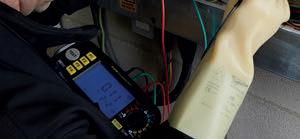
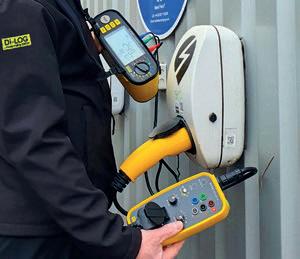
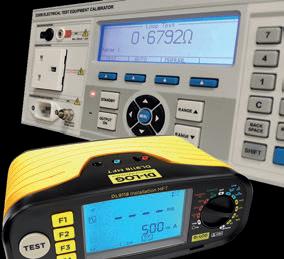


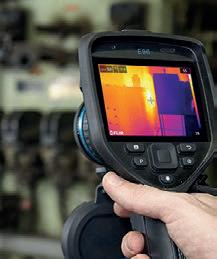
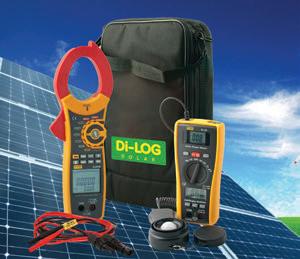

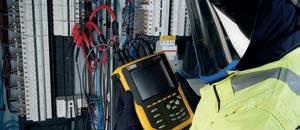
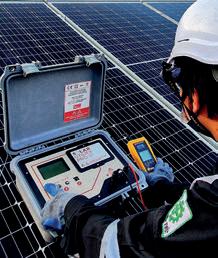
Di-LOG’s second generation MFT with EV capability and solar PV test kit solution makes testing EVPV systems easy peasy, says David Sweetman, Marketing & Business Development Director for the Di-LOG Group.
Electrical engineers in the UK are adapting their testing capabilities to keep pace with the rapid development of new technologies such as electric vehicle (EV) charge station testing and renewable energy regeneration, such as solar photovoltaic (PV). Di-LOG’s newly bundled EVPV package includes its flagship, British-made DL9130EV Multifunction Tester (MFT), which is one of the most versatile and intelligent MFT products in the UK, covering all types of electrical installation applications.
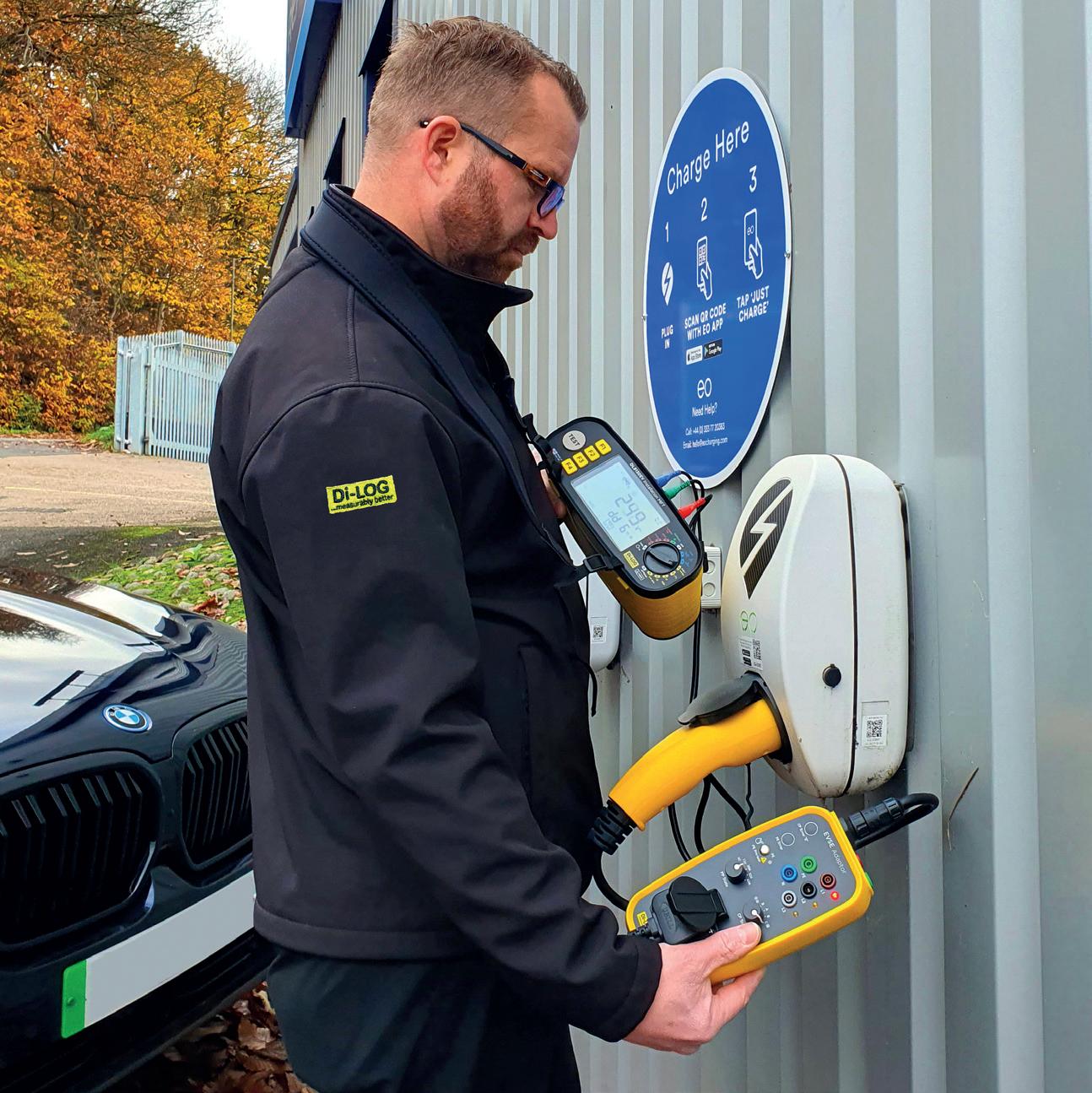
Additionally, Di-LOG’s best-selling Solar PV Test Kit, the SL300, combines the DL6402 1000A AC/DC clamp meter and the dual-purpose SL102 Irradiance DMM.
Let’s explore some of the key features that make the EVPV bundle the top choice for investing in the latest fixed-wire installation equipment.
The British-made DL9100 Series MFT from Di-LOG offers one of the most versatile MFT product ranges in the UK, covering all electrical installation applications. The flagship DL9130EV is not just any EV MFT, it is the company’s most intelligent tester to date.
The new second-generation user interface has been meticulously designed to interact with the user on every function, whether that be to prompt the user to zero the test leads, indicate pre-programmed pass limits or to record maximum impedance or resistance values.
Here are just a few of the key features that the DL9130EV has to offer and why…
RCD-DD protection
The 6mA RDC-DD test is a safety test conducted on EV chargers. It is used to detect and measure the level of residual direct current (DC) leakage present in the charging system.
Residual direct current refers to the small amount of DC electricity that may remain in the charging system even when the charger is not actively charging a vehicle. This residual current can be potentially hazardous if it exceeds certain thresholds, in this instance 6mA, and can saturate the sub-distribution boards’ AC protection covered by the Type-A RCD. There may also be a risk that residual current may cause electric shock or damage to the vehicle or charging infrastructure.
The 6mA RDC-DD test ensures that the EV charger meets safety standards by verifying that the residual direct current leakage does not exceed 6mA. The test is performed using the bespoke RDC-DD test feature added specifically to the DL9130EV MFT that simulates the current flowing between the charger’s DC output and the ground and records the tripping time.
The auto EV RCD test on the DL9130EV MFT is a feature that allows for automatic testing of the RDC-DD and the RCD installed in an electric vehicle charging system.
When performing the auto EV RCD test, the DL9130EV MFT applies a controlled fault current to the charging system and monitors the response of initially the 6mA RDC-DD integrated protection within the charger before continuing to test the Type-A RCD supplying the EVSE cable and equipment. The tester measures the time it takes for the RDC-DD and the RCD to trip or interrupt the fault current and evaluates its performance against the prescribed safety standards.
The auto EV RCD test on the DL9130EV multifunction tester provides a convenient and efficient way to assess the effectiveness and reliability of the current protection in the charging system. It ensures that the RCD is functioning properly, offering the necessary protection against electrical faults and minimising the risk of electric shock to users.
When conducting a continuity test on an electrical circuit, the DL9130EV is used to check if there is a complete path for the electric current to flow. The tester applies a 200mA current to the circuit and measures the resistance. If the resistance is very low (close to zero), it indicates good continuity, meaning the circuit is complete and the current can flow through it.


In some cases, you might encounter a circuit with multiple resistive elements (R1, R2, etc.) in series or parallel. When measuring continuity in such a circuit, the R1R2 value represents the maximum total resistance you can expect to encounter. This means that the sum of all the resistances (R1 + R2) should not have an excessive value for the circuit to be considered continuous.
By measuring Rmax with the DL9130EV, you can ensure that the overall resistance of the circuit is within an acceptable range, with the maximum measured reading being recorded on the secondary display. This is particularly important in various applications, including electrical wiring, circuit board testing, and troubleshooting, where identifying faulty connections or excessive resistances is crucial for the proper functioning and safety of the electrical system. Although all these values should be the same (in an ideal world), you are permitted to record the highest measured value on your documentation.
Intelligent high current loop test
In electrical installations, a loop test, also known as an earth fault loop impedance test, is a method used by electricians to measure the impedance of the earth fault loop in a circuit. This test helps determine the effectiveness of the earth connection and the potential for fault currents to flow in the event of a fault.
The purpose of the earth fault loop impedance test is to ensure that the impedance of the loop (including the supply transformer, protective device, wiring and earth connection) is within

acceptable limits for the protective devices to operate correctly and provide effective fault current protection.
The intelligent high current loop test will automatically detect if the measurement can be safely undertaken when attempting to conduct either a two-wire or three-wire loop test, without needing to make any setting adjustments. The DL9130EV then measures the Ze loop impedance by injecting a known test current into the circuit using two test leads connected between the live conductor and the earth. The instrument then measures the voltage drop caused by this test current, allowing the electrician to calculate the impedance of the earth fault loop.
The DLEV1 is a universal EVSE Charge Station Adapter Kit that simulates the Proximity Pilot (PP) States and Control Pilot (CP) States necessary to power up a free-standing or wall-mounted EV charger. This kit comes with a Type-1 and Type-2 connector plug designed for testing, and it also simulates PE Pre-test, CP Error ‘E’, and PE Error, with the added feature of CP signal output and load connection.
The DLEV1 has a 13A socket for MFT mains lead or can be used for inline load connection. Additionally, it features 4mm input terminals for single or three-phase connections.
The SL300 Solar PV test kit, including the Irradiance Meter and the AC/DC Current Clamp, is designed for the installation and maintenance of solar PV systems. The SL102 Irradiance Meter, with its multi-meter like design, allows for safe and accurate measurements, even at heights. It features a dual display for recording the Irradiance level and Voltage Open Circuit (VOC) simultaneously, up to 600V DC with the panel array connected in situ via the Type 4 connector test lead set provided.
The DL6402 Clamp Meter is packed with advanced features, including the ability to measure up to 1000A DC, VOC up to 600V DC, ambient air temperature via the K-Type adaptor and supplied thermocouple, as well as enhanced features like resistance, audible continuity and capacitance. You can even opt to add a surface probe for direct temperature measurements of the solar PV cell.
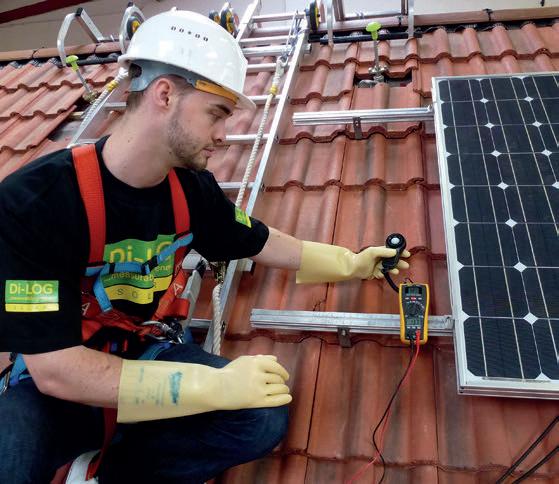
All components come in a soft carry case, offering enhanced protection and easy transportation.
The DL9130EVPVKIT provides everything an electrical engineer needs to ensure the safety of an electrical installation, including the ability to fully verify EV chargers and test domestic PV installations.
Di-LOG is constantly developing its electrical safety products, and values your input. If you would like to learn more or have ideas for what the company can add to its next MFT, please email support@ dilog.co.uk. Need to find your nearest stockist or want to find out more? Please call 0161 877 0322.
Di-LOG, dilog.co.uk
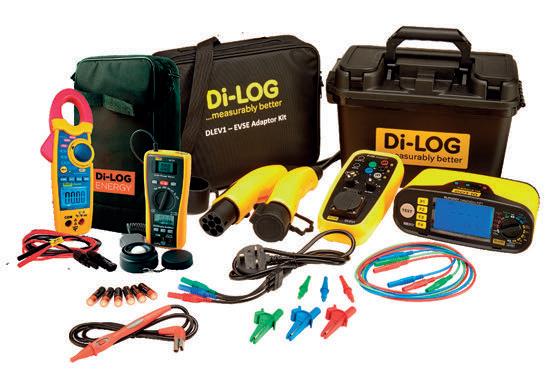

Kevin Brannigan, Marketing Manager at Makita, provides essential insights into managing on-site hazards for electrical contractors, from dust and vibration to noise pollution, ensuring on-site safety and efficiency.
Electrical contractors face numerous hazards on sites every day, from the obvious risks of exposed wiring to the less apparent yet equally significant dangers posed by dust, vibration and noise. Managing these risks is vital to ensuring the safety and well-being of electricians on the job.
Dust is unavoidable in the construction environment, but its risks should never be underestimated. Prolonged exposure to fine particulates like drywall, wood and silica dust (respirable crystalline silica, or RCS) from concrete can cause lung disease and respiratory issues. The HSE estimates that 600,000 UK workers are exposed to silica dust each year, putting them at an increased risk of lung cancer, silicosis and chronic obstructive lung disease.
The risks of exposure to inhalable and respirable dust are significant for electrical contractors, where work often involves drilling into walls and chasing for conduits and cables. Inhalable dust is visible airborne material that can irritate the upper respiratory tract, skin and eyes.
Respiratory dust, which consists of tiny particles like RCS from tiles, stone and concrete, is especially hazardous as it penetrates the lungs. When inhaled, RCS can cause scar tissue build-up, potentially
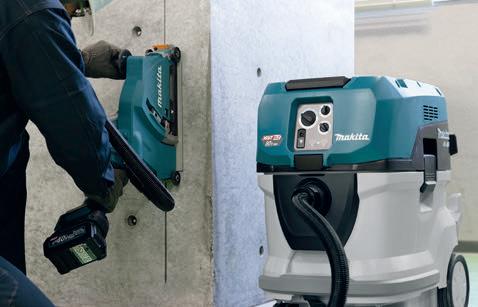
every day
leading to silicosis, COPD and cancer. Occupational lung diseases can take a long time to develop, but the HSE estimates that some 12,000 lung disease deaths each year are linked to past exposure at work.
When using tools such as grinders, wall chasers and drills that generate dust, it’s therefore crucial to put measures in place to prevent exposure. The HSE stipulates that M-Class dust extractors, which remove 99.9% of dust, are the minimum legal requirement for working with RCS-generating materials.
On-tool extractors offer the most effective solution to controlling dust as they capture the dust at the source, preventing it from becoming an airborne hazard that can be inhaled. Many dust extractors have a power take-off, which allows corded power tools to be plugged directly into the extractor. The unit then automatically turns on when the tool is operated. This automatic operation is now also possible for cordless tools through wireless technology. For example, Makita’s battery-powered M-Class-approved dust extractor features Bluetooth connectivity for use with compatible tools to enable automatic power on/off operation.
Many electrical tasks, like hammer drilling, can expose workers to hazardous vibration levels. Regular use and prolonged exposure to vibration can result in numbness, tingling and more severe damage, such as Hand Arm Vibration Syndrome (HAVS), also called Vibration White Finger. HAVS occurs when vibrating tools restrict blood flow and damage nerves and muscles in the hands and arms. Early symptoms include tingling or numbness, but HAVS can progress to more serious conditions like carpel tunnel syndrome if unchecked. The HSE reports that over two million workers are at risk of developing HVAS in the UK.
The Control of Vibration at Work Regulations requires specific actions to be taken when daily vibration exposure reaches a specific value. The HSE’s Exposure Limit Value (EAV), set at 100 points, requires measures to reduce and
manage vibration risks, while work must be stopped immediately when the 400 points Exposure Limit Value (ELV) is reached.
Whenever possible, choose low-vibration tools designed with anti-vibration technology, such as Makita’s AVT (anti-vibration technology) systems, which feature counter-weights, damper springs and vibration-absorbing housing. These reduce vibration transmitted to the user’s hand and allow safer usage, improving efficiency and productivity.
Loud noise is common on sites, but frequent, extended exposures can result in tinnitus or permanent hearing loss. Most power tools operated by electrical contractors, including hammer drills and disc cutters, can lead to long-term hearing damage if the risks are not effectively controlled.
Appropriate and adequately fitted ear protection is mandatory for any noise-generating work. Using lower-decibel tools that feature a noise suppression system will also minimise the dangers
The proactive selection of power tools equipped with advanced features for dust extraction, vibration reduction, and noise control is central to ensuring safety on site. Understanding and tracking exposure levels as recommended by the HSE will ensure compliance with safety guidelines and legislation.
However, enhancing safety goes beyond tool selection alone. Good housekeeping practices are vital in creating a safe working environment for electrical contractors. Simple measures such as removing trip hazards like tool cases and packaging, ensuring adequate lighting and maintaining a clutter-free workspace contribute significantly to accident prevention and worker safety.
By integrating these strategies into everyday practices and investing in innovative tools, electrical professionals can protect themselves against hazards like dust, vibration and noise, enhancing on-site safety and productivity.
Makita, makitauk.com


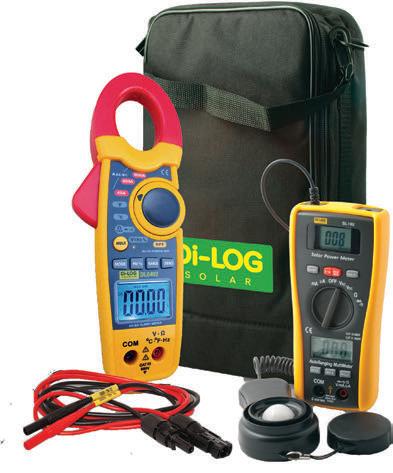
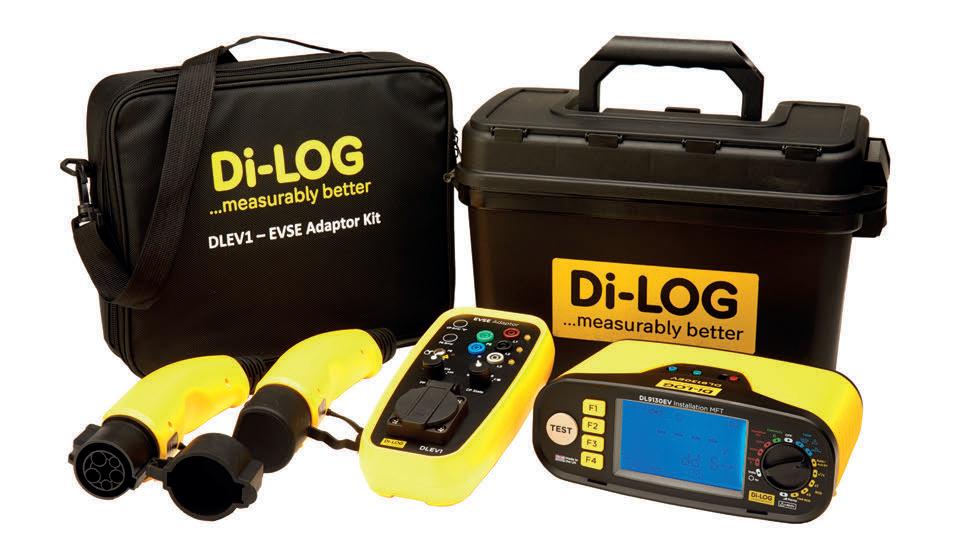
It’s important to ensure that the long-term performance of solar PV installations is not compromised by sub-standard installation or poor maintenance. This requires key solar PV system features that rely on adequate and appropriate electrical testing and inspection being undertaken on a regular basis. Darren Bakewell, Applications Engineer at Seaward, explains.

IEC 62446 recommends that periodic verification of an existing installation shall be performed. The standard defines the minimum requirements for system documentation, commissioning tests and inspection for PV systems. Where appropriate, the results and recommendations of previous periodic verifications shall be taken into account. A report on the condition of the installation shall be provided. We must, as with all electrical equipment, maintain our solar PV installations in a safe condition.
BS7671 covers electrical design, installation and testing of electrical installations and includes a section on solar PV that may need to be considered differently to other installations. This section makes note of BS EN 62446 for the inspection and testing of the systems.
PV systems, in particular large-scale systems, have many metres of cabling, much of which is buried underground.
Poor levels of insulation will allow energy generated by the PV system to leak to earth. This can be particularly problematic during damp or wet conditions where the insulation monitoring or residual current monitoring function within an inverter prevents the inverter from starting up, which in turn can significantly reduce the operational efficiency of the PV installation.
PV systems by their very nature are exposed to the elements. Damage or corrosion to cabling and connectors caused by moisture ingress can result in degradation in performance or increased risk of fire.
Regular inspections and electrical testing will enable system performance to be monitored and any necessary repairs or remedial actions to be taken.
PV modules can become dirty or contaminated over time and this can reduce the operational efficiency and system performance. Similarly, exposure to the elements can result in physical damage to the component parts of a PV installation. Objects dropped by birds can result in
We must maintain our solar PV installations in a safe condition

physical damage to PV modules, which may result in reduced output performance.
Periodic inspection and electrical testing as part of regular maintenance will enable any problems to be identified and diagnosed.
The most obvious example of bad wiring is when wires hang below the panels and touch the roof or underlying vegetation. Eventually, the wire coating will wear or be damaged by rodent attacks and potentially expose the copper wires, presenting a shock and fire hazard. Any deterioration of cable connections and wiring can be identified by applying regular electrical testing to identify potential faults.
The installation of solar PV systems is only undertaken after careful consideration of the costs involved and the potential return on investment provided by lower energy bills and generation payments. As a result, the verification of system performance and energy output from the panels is particularly important. In many cases, simple electrical faults or wiring failures can cause a serious inefficiency in the ability of the system to produce power. Although proper metering will give an indication of system performance, periodic electrical inspection and testing is vital to verify ongoing functional performance over extended periods.
Periodic electrical inspection and testing of solar PV systems to identify
and confirm continued safe operation and maximum energy output performance can be required as part of product warranties and PV system component guarantees.
As the number of rooftop solar installation systems has grown over the years, so has the number of reported incidents of fires. Household fires started by electrical faults in rooftop solar PV systems have been reported in the UK, Australia, the USA and France, among others. The periodic inspection and testing of the electrical wiring and components associated with solar PV systems will ensure the safe operation of the system and reduce the potential fire risk associated with any electrical faults.
All solar PV installations require the provision of various documentation and forms to the customer. System documentation usually includes system data, installer details, electrical diagrams, operation and maintenance instructions, and other information that may be required by certain standards or regulatory bodies. Copies of all test and commissioning data should also be provided and, as a minimum, this should include the results from the electrical safety and verification tests undertaken as part of the system installation procedures.
Seaward, seaward.com

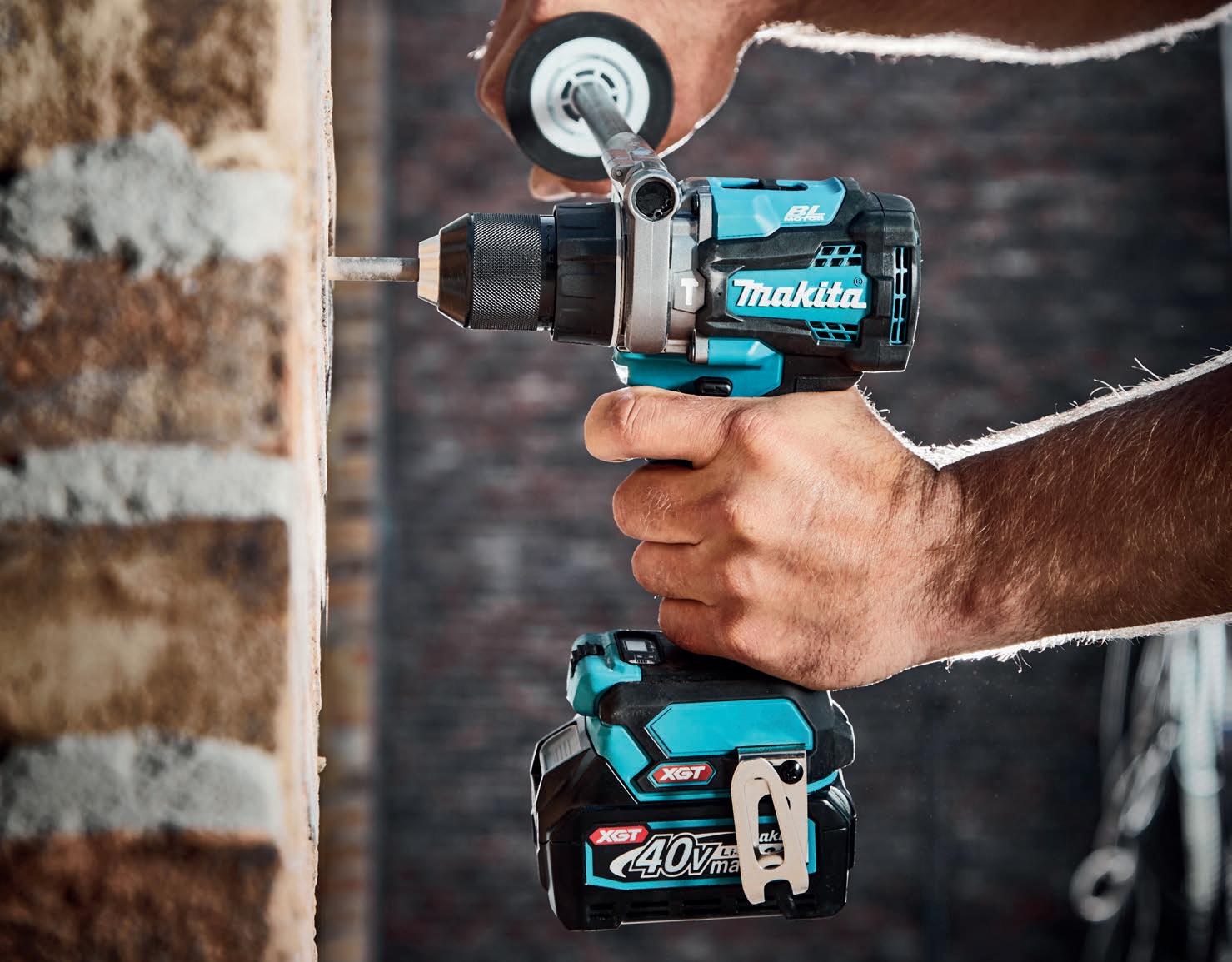
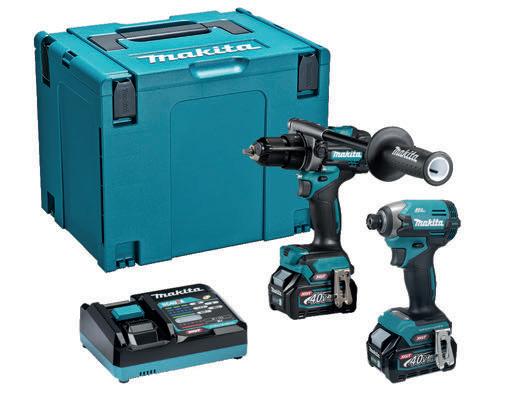
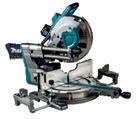





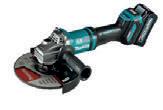

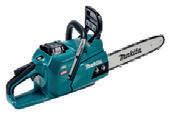
Discover the expansive XGT 40V and 80V Max line-up. With over 120 products and still expanding, the XGT range is your ultimate alternative to traditional petrol and mains power sources. Experience on-demand power across our complete product spectrum. Makita provides more than just power tools, explore our full range at makitauk.com and follow us on socials for updates.
Cordless power tools can make the more demanding tasks more manageable, especially when the work gets dirty and requires mains-like power, explains
Jonathan Peters, Product ManagerElectricians often face dirty and physically demanding tasks. From chasing walls and demolition, to running and attaching cables to joists and drywall, these can be dirty, tiring and let’s face it, boring jobs. With the right tools, however, these jobs are more than just grunt work – they can even be made enjoyable.
Power tool manufacturers have continuously innovated to create tools that address the specific needs of these challenging jobs and the environments they have to operate in. From rotary hammers to combi drills, and the ever-increasing shift to cordless options, the industry has seen significant advancements and there are some great tools every electrician should have in their arsenal.
For the really tough heavy duty drilling jobs, look for an SDS drill (Slotted Drive System) which combines the hammer action of a hammer drill with the rotary
The DH3640DA 36V SDS-Max Cordless Rotary Hammer Drill is one of the lightest tools in its class

motion of regular drills, allowing the drill bit to move back and forth within the chuck with greater impact energy, minimal slip and more precision. These tools are essential for tasks such as chasing walls, where electricians must create channels for electrical conduits and cables.
SDS rotary hammer drills excel in drilling and chiselling through hard materials like concrete and brick thanks to their powerful hammering mechanism. An ordinary drill with a masonry bit will be good enough to drill a few holes, but if you have more than a few dozen to get through, a rotary hammer is the tool you need. The DH3640DA 36V SDS-Max Cordless Rotary Hammer Drill, for example, is one of the lightest tools in its class, weighing just 6.1kg. It puts out 9.2J of impact energy to perform drilling and demolishing tasks with ease.
With one of the lowest vibration levels in its class at only 10.3m/s², this is complemented by the Low Vibration Handle (LVH), which provides an optimal grip, reducing the risk of fatigue and increasing the precision with which tasks can be performed.
Furthermore, the tool incorporates Reactive Force Control (RFC), a safety feature that immediately stops the motor if the drill bit is suddenly overburdened.
Installing cables in drywall is a common task that can be tedious and time-consuming. Drywall screwdrivers simplify this process significantly. These tools are designed for quick, repetitive work, allowing electricians to fix drywall panels efficiently and with precision. Features like adjustable nosepieces help control the depth of screws, ensuring a secure fit without damaging the wall or the cables within.
The HiKOKI W18DB and W18DA Cordless Drywall Screwdrivers include an autostart function that simplifies operation, and they are designed for comfortable use with one hand. They come equipped with a screwdriver magazine that aids in batch screwdriving. The ‘Impulse’ mode is particularly useful for driving screws that
stick out, while the adjustable depth guide and low noise claw clutch contribute to uniform screwdriving.
Perhaps one of the most transformative trends in the power tool industry is the shift towards cordless technology and the development of battery performance equivalent to that of mains power. Cordless tools offer unmatched mobility, allowing electricians to work freely without the encumbrance of power cords.
The improvements in battery technology, such as Lithium-ion batteries, have extended the life and power of cordless tools to rival their corded counterparts. For electricians, this means being able to perform heavy-duty tasks such as drilling, cutting and fastening without frequent stops to recharge, thereby enhancing productivity.
Multi Volt batteries stand out in the industry for their awesome power. They are lighter and more compact at comparable watt strengths than other products on the market. The smart connection technology of the battery pack enables it to identify whether it is being used with an 18V or a 36V device, and it adjusts the voltage accordingly.
Innovation in power tools also focuses heavily on safety and ergonomic design. Electricians often work in awkward positions and tight spaces, which can lead to strain injuries. Modern power tools are designed with ergonomics in mind –lightweight materials, balanced designs and features like anti-vibration systems reduce physical strain and increase comfort. Additionally, safety enhancements, such as automatic shut-offs and improved electrical insulation, protect against potential accidents and injuries.
Electricians depend on their tools to manage the rigorous demands of their work. With every innovation, manufacturers are making these essential tasks quicker, safer and less physically demanding, highlighting the crucial role of advanced power tools in the electrical trade.
HiKOKI Power Tools, hikoki-powertools.co.uk




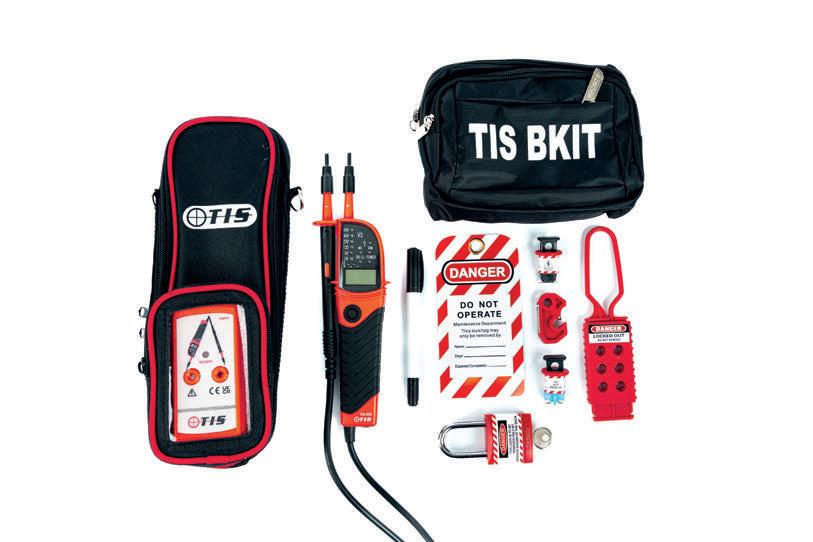
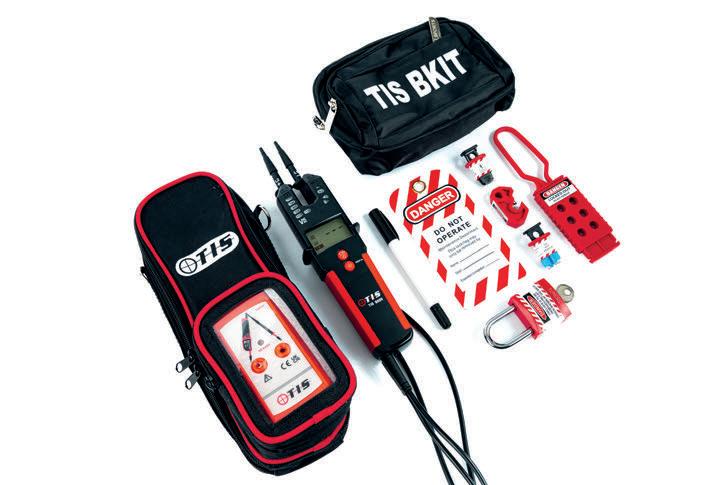
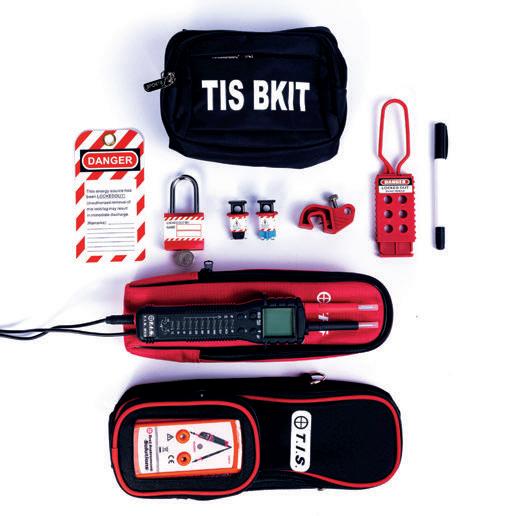
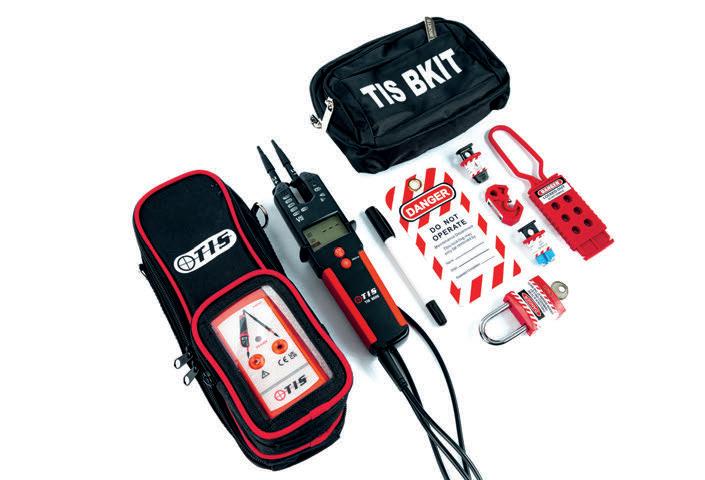
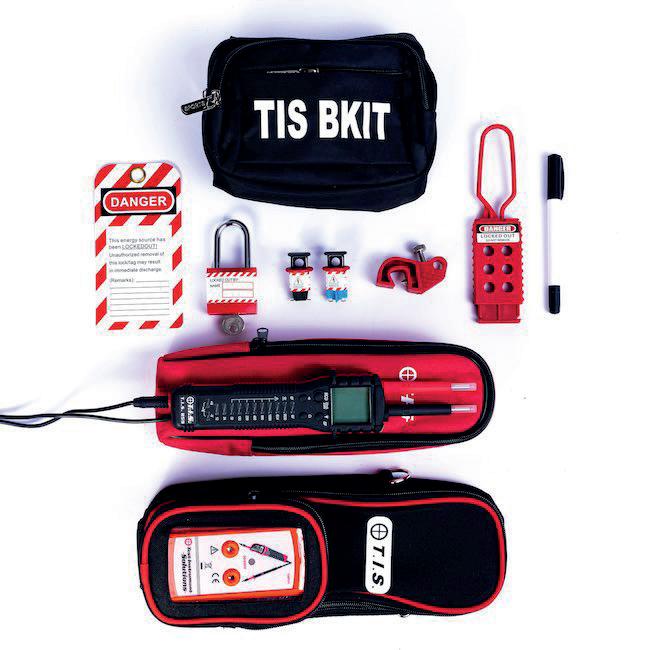


Thermal imaging cameras are playing an increasingly important role in modern electrical contracting, quickly detecting issues like overheating components, unbalanced loads and circuit overloads, explains Will Jin, Channel Sales Manager for HIKMICRO
In an era marked by rapid technological advancements, electricians are increasingly turning to sophisticated measurement equipment to enhance the precision and efficiency of their work. Among these, handheld thermal imaging cameras have emerged as indispensable assets. These devices streamline diagnostic processes, significantly reduce the time electricians spend on site and can be used for surveying areas that are hard to reach with conventional measurement tools.

distribution across electrical systems, ensuring that no single component is under undue stress.
Most electrical issues exhibit a gradual rise in temperature prior to their failure. Thermal imaging can recognise this heat in a variety of situations, including loose or over-tight connections, overloaded circuits, load imbalances and failing components such as fuses, circuit breakers or transformers. By detecting these problems early, you can prevent the possibility of fire.
Thermal imaging cameras are therefore useful in a variety of applications within the electrical industry. They allow electricians to quickly identify hot spots in electrical panels and circuitry, which are indicative of potential faults or failures. This capability is crucial for preventive maintenance, as it enables issues to be addressed before they lead to system failures or hazardous conditions. Moreover, these cameras assist in load balancing by visualising the temperature
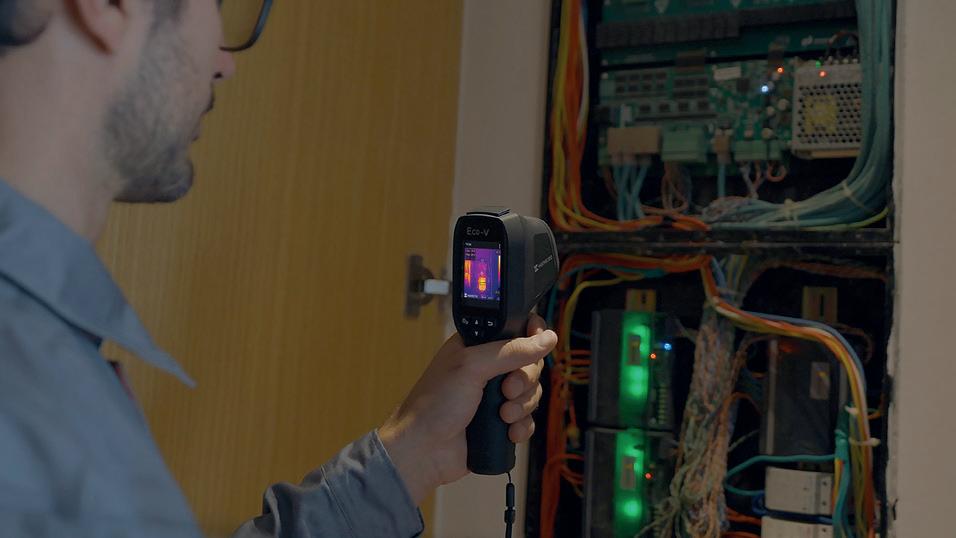
For electricians tasked with equipment maintenance in industrial settings such as factories, handheld thermal imaging cameras are not just tools but essential instruments that safeguard against operational disruptions. In these environments, the stakes are particularly high – equipment failures can lead to significant production downtimes and financial losses. Thermal cameras enable electricians to conduct thorough and non-invasive inspections of machinery and electrical panels while they are in operation.
As an example, Eco Series and Pocket E thermal cameras coupled with SuperIR technology stand out. The SuperIR image enhancement technology upscales thermal images when viewing live with 25Hz fast image frequency and image capturing on these products.
Cameras with SuperIR technology offer several distinct advantages. Firstly, unlike traditional multi-frame enhancements, SuperIR operates on a single-frame basis, significantly reducing noise and enhancing edge definition without requiring multiple exposures or additional processing time. By upgrading the pixel count significantly without compromising the thermal camera’s portability and ease of use, SuperIR allows for finer details and sharper images. This is particularly beneficial for intricate tasks such as assessing overheating components in tight spaces or pinpointing temperature disparities in complex circuit boards. Secondly, the real-time processing ensures that electricians can rely on the accuracy of live data and therefore make immediate decisions and take action during inspections.
Cameras come in different shapes and sizes depending on their uses. For example, the Eco Series, being slightly larger, is suited for electricians who require more robust features and can accommodate a bigger device within
their toolkit. The range is IP54-rated and has passed strict drop tests up to two metres. The High Sensitivity IR sensor provides users with a high image quality, easier-to-spot subtle heat loss or gain and delivers high image quality. The 25Hz fast image frequency allows for smooth video while panning across scenes or viewing moving targets while the built-in Li-ion rechargeable battery can support up to eight hours of continuous operation. This camera also includes a laser pointer to help determine the location of problems.
Meanwhile, the Pocket E, with its compact design, is ideal for those who need a highly portable device that can be easily carried in a pocket or a small bag. It provides a high-definition image with full-screen temperature measurement and a – 4°F to 662°F temperature range. The 3.5in touchscreen is easy to use while the LED work light allows you to see in dark and hard-to-reach areas. Its wireless connectivity adds to its mobility and flexible use, while the built-in 4GB eMMC flash storage can store approximately 30,000 standard thermal or visual images or 20 hours of MP4 video, also allowing onboard recording and playback. These cameras also come equipped with continuous firmware updates, enhancing their functionality and extending their lifecycle without the need to purchase newer thermal cameras. This aspect of the technology aligns with the evolving needs of tradespeople, ensuring they always have access to the latest enhancements in thermal imaging.
This real-time diagnostic capability allows for the early detection of overheating, which is often a precursor to equipment failure. By pinpointing hot spots and other irregular thermal patterns, electricians can identify components that are at risk of breaking down, schedule maintenance proactively and replace parts before they cause system-wide issues. This predictive maintenance approach minimises downtime, enhances safety by reducing the risk of fires and other hazards, and optimises operational efficiency in a factory setting.



Environmental monitoring experts and the AKCP partner for the UK & Eire.
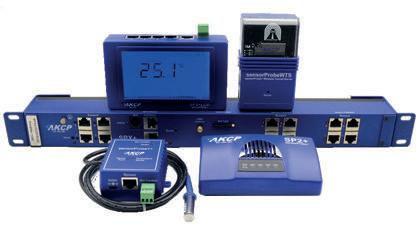
Contact us for a FREE site survey or online demo to learn more about our industry leading environmental monitoring solutions with Ethernet and WiFi connectivity, over 20 sensor options for temperature, humidity, water leakage, airflow, AC and DC power, a 5 year warranty and automated email and SMS text alerts.
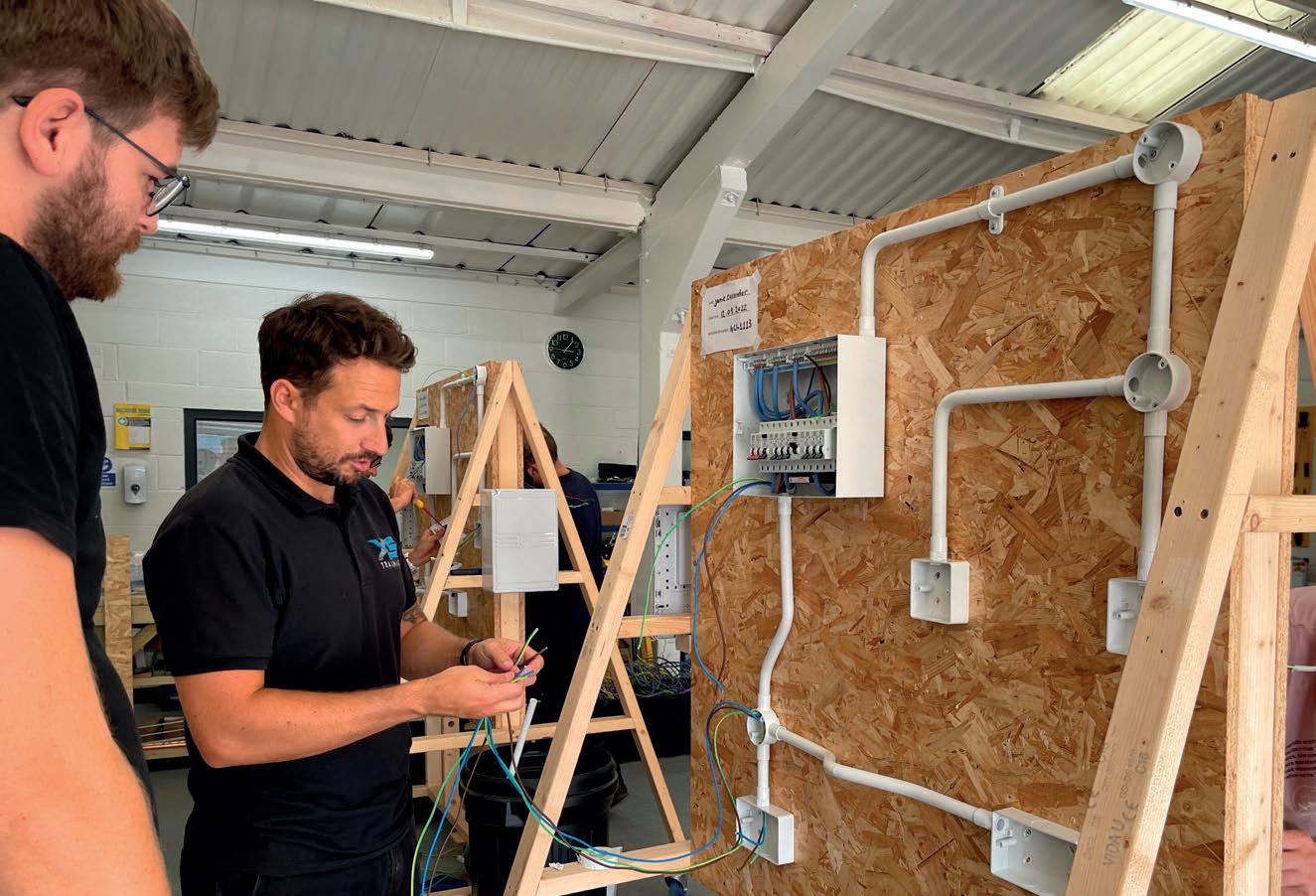



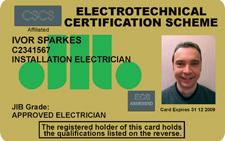
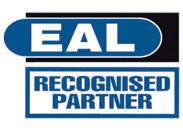


In the current economic climate, the commercial vehicle sector is a beacon of innovation, literally driving businesses and individuals towards a greener future. As the world turns to electric mobility, the collaboration between commercial vehicles and sustainability is becoming increasingly apparent, writes Solar Select

At Solar Select, the sustainability ethos is not just a guiding principle; it’s the cornerstone of the company’s mission to revolutionise the future. One example of how it is making a difference is how it has seamlessly integrated electric vehicle (EV) technology into its fleet. At the heart of this transformation lies the new electric forklift, a testament to the company’s unwavering commitment to eco-friendly solutions.
At the heart of Solar Select’s transformation lies its new electric forklift
By embracing electric vehicles, Solar Select has not only reduced its carbon footprint but also spearheaded a shift towards cleaner, more efficient transportation solutions in the workplace.
Using electric vehicles can make a significant difference to a business, including electrical contracting firms. While electrical vehicles typically have higher upfront costs than traditional vehicles, they often offer lower operating costs over time. Additionally, electric vehicles have fewer moving parts and require less upkeep, resulting in lower maintenance costs over the vehicle’s lifespan.
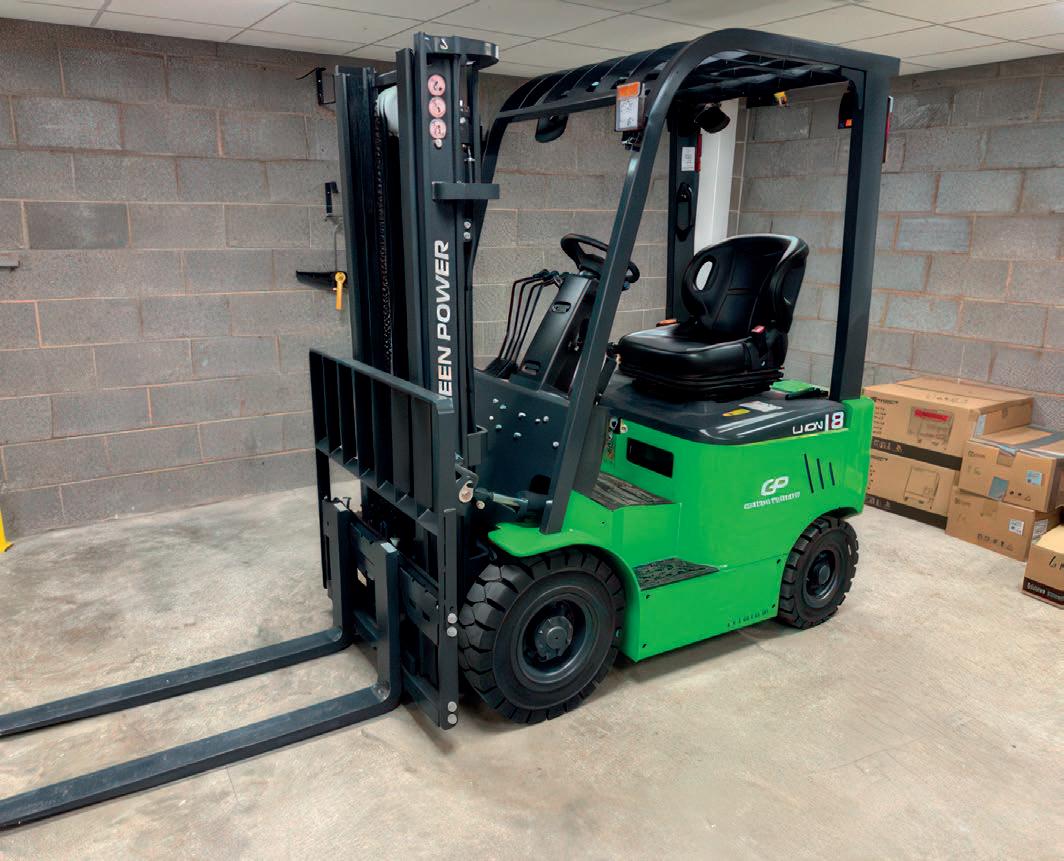
Switching to electric vehicles also helps reduce greenhouse gas emissions and air pollution compared to conventional vehicles. This aligns with the growing emphasis on sustainability and corporate social responsibility, potentially enhancing a company’s reputation and appeal to environmentally conscious clients. Plus, it can differentiate a company from competitors and attract clients who prioritise working with environmentally responsible contractors.
As governments worldwide implement stricter emissions regulations, electric vehicles can help businesses stay compliant with environmental standards. This reduces the risk of fines or penalties associated with violating emissions regulations.
For electrical contractors and other sectors, the creation of electric vehicles heralds a new era of opportunities. As the automotive landscape undergoes a seismic shift towards electrification, the imperative for sustainable transportation solutions has never been clearer.
The adoption of electric vehicles is a strategic imperative for the future of businesses that operate out on the road. For Solar Select, this transition represents a strategic investment in sustainability and operational efficiency. By leveraging EV technology, the company not only reduces operational costs but also mitigates environmental impact.
The importance of electric vehicles and sustainability to the electrical contracting industry is growing steadily. As awareness of environmental issues increases and regulations become more stringent, many contractors are transitioning to electric or hybrid vehicles to reduce emissions and minimise their carbon footprint.
Terry Hayward, Managing Director of Solar Select, says, “We believe that developments in the commercial vehicle sector offer immense benefits to electrical contractors. Advanced features such as improved efficiency, enhanced safety measures and customisable storage options streamline operations and boost productivity for contractors on the go. Embracing electric vehicles and ‘going green’ isn’t just important – it’s essential for the industry’s sustainability and future success.”
Solar Select, solarselect.net


Choosing a new van for your business can feel overwhelming – it is a big investment and you want to make sure you are making the right choice. Tim Alcock at Lease Van looks at what to consider.
Electricians and electrical contractors need to make sure they buy a van which is both comfortable and appropriate for their needs, and it must have enough storage to accommodate all equipment and tools. There are a few factors to take into consideration when shopping for a new van, including racking requirements, weight allowance and electric vs petrol.
An important thing to remember when buying a commercial van is how practical it is going to be. Think about how you are going to need to use the vehicle in order to make an informed decision about what is best for you.
Some commercial vehicles can be fitted with racking systems, and some can even be converted for your unique requirements. If you require constant use of the same tools and lots of efficient space to make transporting equipment easier, this might be the best option for you.
The ban on petrol and diesel cars is approaching, so many electricians and electrical contractors looking to invest in a new work vehicle may be considering whether to go electric.
Although an electric van will cost you more money upfront, they may provide long-term savings. Saving on fuel, tax and maintenance could make an electric vehicle the best investment for you.
There are benefits either way – whether you go with a petrol or electric vehicle for
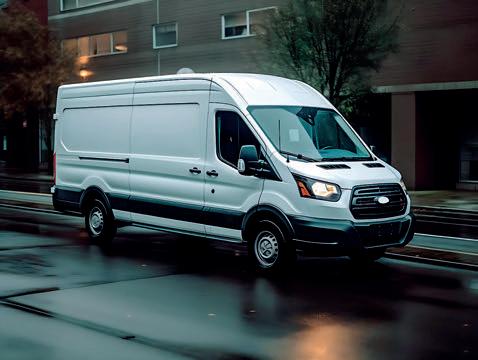

Workers should always consider the appropriate size when buying a commercial vehicle
An important thing to remember when buying a commercial van is how practical it is going to be
work. Electric vans have fewer moving parts compared to petrol and diesel engines, making them cheaper to maintain. They tend to be more comfortable over a long journey and charging costs can be considerably cheaper than refuelling, so more beneficial for short distances due to range. However, you will need to check ahead of time to plan out charging options or install a home charger.
Workers should always consider the appropriate size when buying a commercial vehicle. Make sure the van you purchase has enough capacity for all of your equipment and additional needs. Under action 41b of the Road Traffic Act 1998, it’s a serious offence to drive an overloaded vehicle which exceeds weight restrictions and requirements.
Those found to be breaking this law could land fines of up to £300 and receive penalty points on their licence, depending on the amount overloaded. Buying an appropriately sized van and spreading loads evenly can help keep the vehicle steady, ensuring nothing can slide too far out of position and using safety equipment like rope hooks to keep goods tightly secure.
Before setting off on the road, Lease Van strongly encourages all van owners to double-check that items are securely fastened into position and to invest in rope hooks for extra reassurance.
If you do find yourself on the road with a shifting load, first check your mirrors and begin to slow down. Then when it’s safe to do so, pull over into a suitable area where you can readjust the equipment and tightly secure it to prevent any moving loads.
All van drivers must take extra care and precautionary measures to ensure they aren’t breaking the law, preventing causing harm to other road users and avoiding serious penalty charges.
It’s essential to select the right van for your business use, needs, budget and expectations. In this era of fast-moving technology, making a big purchasing decision on a commercial vehicle can feel daunting.
Leasing a van for your business needs brings a host of added benefits. Not only will you be able to drive a brand new van, ensuring a more economical and safe vehicle, but you will save on maintenance costs.
Once the lease is over, you hand the vehicle back with no strings attached and are free to find another (potentially better!) lease deal. You can make a truly informed decision for your business needs.
If you are leasing a vehicle exclusively for commercial use, it is possible to claim up to 50% of the VAT back on the vehicle and up to 100% of the VAT back for any maintenance packages you add to your lease. Lease Van recommends speaking to your accountant to find the best way to do this.
Lease Van, leasecar.uk
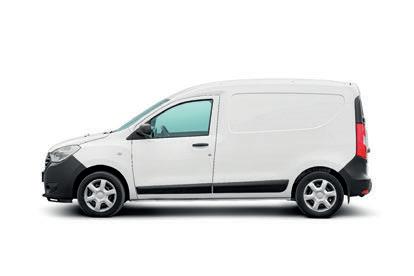
Introducing the Inceptor Rio Ultra Low Glare LED Batten with easy to install besa and suspension mounting points
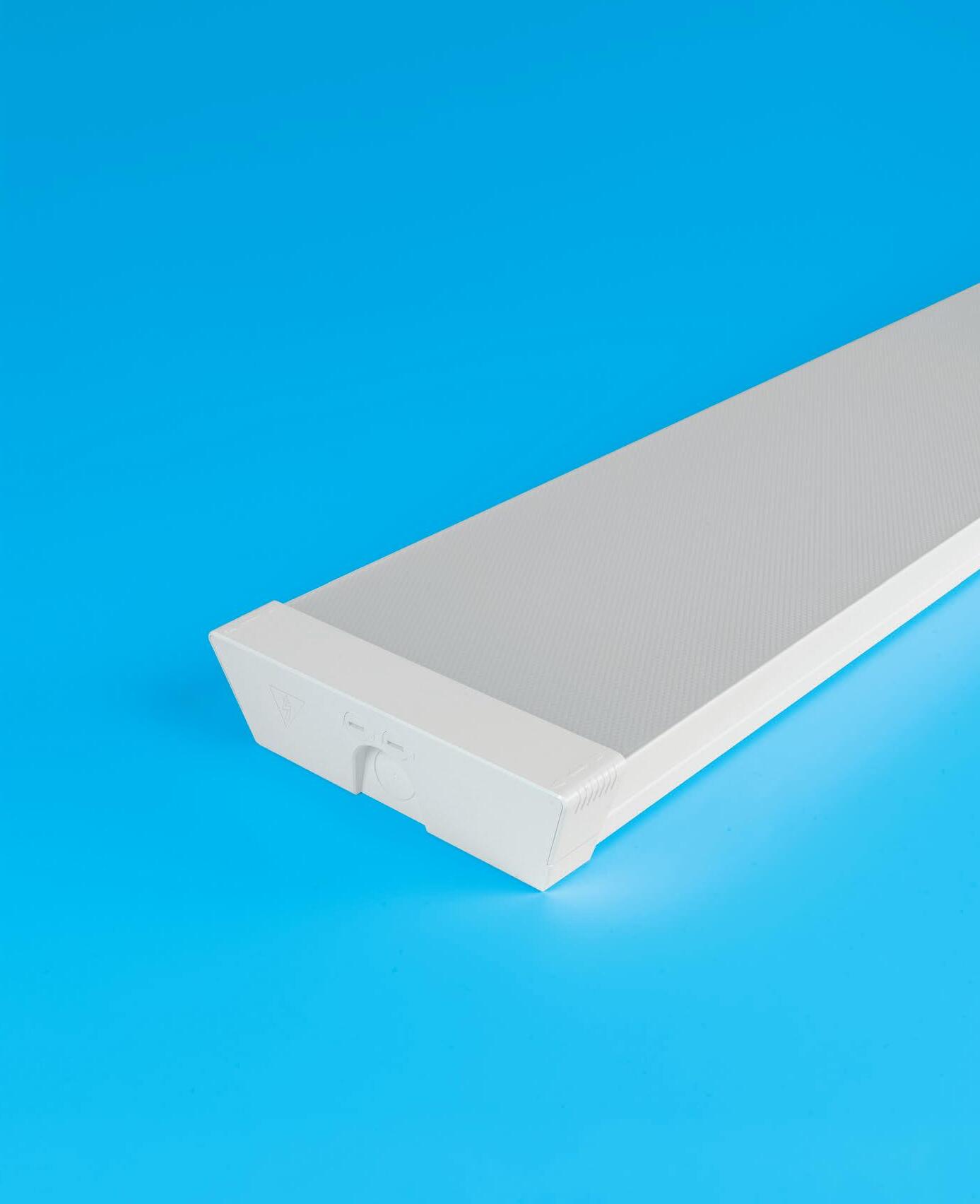
4FT &
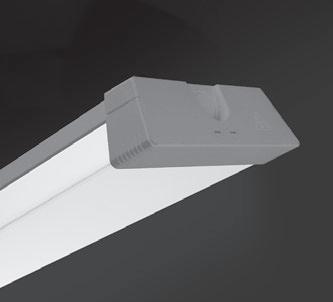
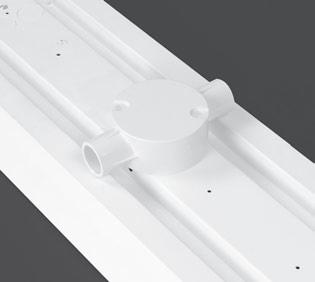
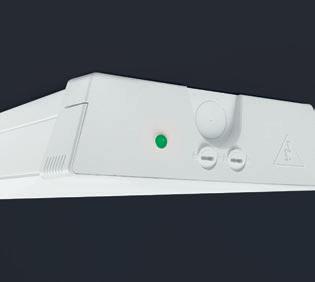
Marshall-Tufflex has added a new collection of metal strut and trunking to its extensive portfolio. The new products provide contractors with even more choice when it comes to the organisation, protection and support of cabling across a wide variety of applications.
The latest additions to the range underpin Marshall-Tufflex’s efforts to build upon its core PVC-U range to further incorporate a wide choice of cable management systems manufactured with different materials that

suit a wide range of installation needs. As such, the company now offers everything from metal trunking and strut to GRP ladder and trays, as well as underfloor to desk and fast fit wire basket systems.
Marshall-Tufflex’s new IP4X-rated metal trunking is ideal for heavy duty installations or applications where there is high risk of combustion, such as engine rooms or oil and gas works.
Manufactured from hot dipped, zinc coated low carbon steel strip to meet BS EN 10346, this new collection is stocked and available in 27 different size variants. Notably, it also includes two and three compartment variants as part of the standard range.
The new metal trunking is supplied with Marshall-Tufflex’s unique hexagonal turnbuckle lid fixings, designed to make installation quick and easy. Six turnbuckles are supplied for each 3m length.

The current Airmaster Range of Portable Air Conditioners includes 9,000 and 12,000 Btu units in two versions. All are portable and highly versatile, with the ability to cool, fan or dehumidify and come fitted with an R290 refrigerant and frost protection function. With compact modern designs, they are all floor-standing and easily moved around with omnidirectional wheels.
Whilst these features are standard to both pairs of units, an addition last year saw upgrades with version two featuring Wi-Fi and remote battery controls and a 0-24 hour programmable timer.
Now Airmaster is proud to announce the launch of an enhanced version of a new 9,000 Btu unit with the ability to operate at a low noise level of only 45dB, whilst also having the benefit of flexible smart controls either on Wi-Fi via a mobile phone app or with a supplied battery operated remote controller.
CED Electrical, cedelectrical.co.uk
Snickers Workwear will help you stay smart, cool and protected this summer.
Professional tradesmen and women in the UK often assume our climate is not hot or sunny enough to cause harm. But even on overcast days there can be enough UV radiation to damage skin.
That’s why Snickers Workwear’s working clothes and accessories for the coming months combine superior comfort and protection for working on site in the summer.

There are new sun protection caps, shirts, shorts, trousers and jackets that deliver enhanced freedom of movement and ventilation, plus lightweight workwear that combines all the features of high-performance sportswear. With 37.5 fabric technology, it’s quick-drying and functional as well, providing UPF 40+ sun protection. It’s also longer lasting and more sustainable than other comparable workwear. So, as we all become more aware of the dangers of over exposure to UV, choose Snickers Workwear’s working clothes for summer – the sensible choice for personal wellbeing and working efficiency.
Snickers Workwear, snickersworkwear.co.uk
Furthermore, the metal trunking comes with a wide range of accessories, including gusset bends, end caps, reducers and crossovers, allowing contractors to adapt to a variety of cable types and set ups.
Also included in the new metal trunking system collection is a metal lighting trunking range with an open design and optional clip-on lid available on request. This trunking has a set width and height of 50mm x 50mm and is available in 3m and 4.5m lengths.
For a complete solution, Marshall-Tufflex has also added plain and slotted metal strut to its line-up.
Manufactured from Grade SD2809B steel and engineered to meet BS 6946 and BS 5950 standards, the strut provides a flexible solution to mount, support and connect lightweight cable loads such as metal tray or wire basket and create a versatile framework for industrial environments.

For easy configuration and assembly, Marshall-Tufflex has included a number of size and length variations to this range and offers the choice of pre-galvanised or hot dip finishes, light gauge or heavy gauge and back-to-back welded versions.
The new metal trunking and metal strut ranges are included in the company’s new Metal Cable Management product guide, which also features its existing metal cable tray and wire basket solutions.
Marshall-Tufflex, marshall-tufflex.com
A new expansion of the BG SyncEV range, Balancer introduces multi-charger load management for commercial properties using BG SyncEV chargers with no additional subscription cost.
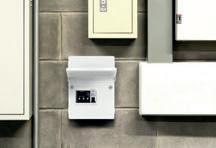
The BG SyncEV Balancer load management system is engineered to integrate with existing building wiring and supports up to 16 chargers. The device dynamically monitors available power and communicates with connected chargers to ensure each receives equal power, allowing for easy expansion with additional chargers in the future.
Optimising power usage, it provides dynamic load management to allocate available power from the building to connected vehicles. This ensures efficient charging without the need for complex queuing systems and allows for more vehicles to be charged simultaneously without exceeding a building’s safe power limits.
The Balancer operates locally without requiring an ongoing network connection or costly subscription.
The BG SyncEV Balancer detects and accommodates the number of chargers connected, future-proofing EV installations by ensuring businesses can easily install and expand their EV charging capacity as charging needs evolve, and prevents the need for complex set ups and costly modifications.
BG SyncEV, syncev.co.uk
Click Scolmore has introduced a new range of compact 1 Pole + Switched Neutral True 6kA 30mA Trip (Type A) RCBOs to its Elucian consumer unit and protective devices portfolio.
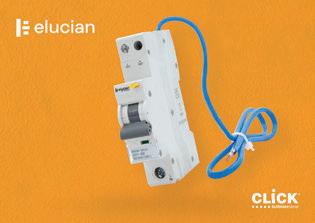
Available in B Curve and C Curve and 6A, 10A, 16A, 20A, 25A, 32A, 40A and 45A options, the new switched neutral RCBOs come complete with 450mm Neutral out tails, and they are supplied with a three-year warranty. They form part of the Click Elucian range of RCBO protective devices which are all Type A rated, offering a resilience when DC current is present.
A single pole switched neutral RCBO is a device that has overcurrent protection only on the line conductor, but residual current protection on both the line and the neutral. It also switches off in the event of a fault, or a manual operation.
The comprehensive Elucian by Click range can be viewed on the Scolmore Group website as well as on the Scolmore Group app. Scolmore, scolmore.com
ESP offer a team of dedicated design engineers who are fully trained & qualified in all of the relevant British Standards such as BS 5839-1:2017, BS 5839-6:2019 & BS 5266.

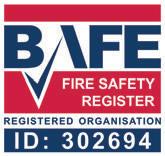
Alongside ESP’s extensive range of fire protection systems, a new commissioning service has now been launched to ensure that an installed ESP system operates correctly in accordance with the recommendations of BS5839-1.
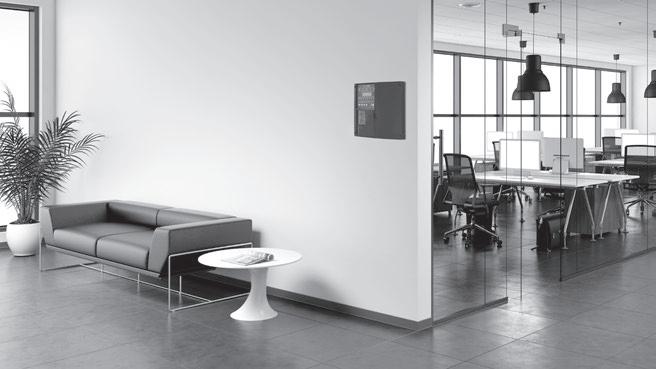

As part of the design service, ESP now offer zone plans which will be available as framed hard copies or sent electronically.





























Rolec and The Solar Advisory Service have joined forces in a mission to spread green energy solutions nationwide.
Rolec, which has a full range of solar compatible chargepoints, has been named The Solar Advisory Service’s official EV charging partner.
The joint scale of this endeavour means that both companies will be able to provide residential and commercial clients with a comprehensive solution to green energy, starting at the home and extending to public spaces.

Cable cutters are an essential part of an electrician’s arsenal and C.K Tools is helping busy professionals in their everyday work with the launch of its T3973 VDE Cable Cutters.
James Jarvis, Senior Business Development Manager at Rolec, says, “From our very first meeting with The Solar Advisory Service, it was clear that our companies shared aligned goals and recognised the immense potential of a partnership.
“Not long after, I extended a further invitation to The Solar Advisory Service to visit Rolec at HQ, where we provided them with the opportunity to not only see our operations and custom-built training academy firsthand, but also to begin implementing our plan for strategic development.
“It was a great honour for The Solar Advisory Service to confirm their interest in partnering with us, based on what they observed and experienced during these interactions with the Rolec team, and we are full-heartedly enthusiastic about the combined opportunities we have set out ahead of us.
“I am eagerly anticipating working closely with The Solar Advisory Service team to provide EV charging solutions nationwide.”
Jamie Lynch, Chief Operating Officer at The Solar Advisory Service, adds, “Our partnership with Rolec is a testament to our shared vision of a more sustainable future.

Combining the highest quality Japanese steel cutting heads with expertly manufactured, insulated and ergonomically designed handles, this adaptation from C.K Tools’ bestselling Cable Cutter range will help electricians complete tasks more efficiently and safely.
The new and improved C.K Tools VDE Cable Cutters feature dual component handles for maximum comfort and reduced risk of injury, with engineered jaws for both cutting and stripping applications.
Available in 260mm and 210mm sizes and with new VDE-certified insulated handles for working on live electrics at 1000V AC and 1500V DC, this latest product is designed to tackle a multitude of projects.
Manufactured in Germany, the VDE Cable Cutters deliver superior and long-lasting performance for cutting cable efficiently and effortlessly. C.K Tools, ck-tools.com
As the cost of living crisis continues to squeeze household budgets, consumers are making every effort to keep a cap on their outgoings. With recent news reports citing huge hikes in the subscription fees of some video doorbell providers, ESP is reminding its customers and installers that with its Fort Smart Security Doorbell, there are no subscription or any additional fees to pay.
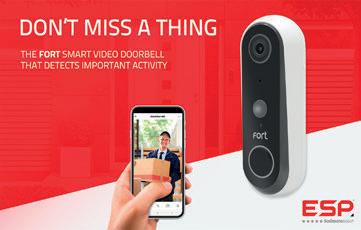
The Fort Smart Wi-Fi Doorbell offers full 1080p (2MP) HD live view, two-way audio, recording and visitor notifications. It is powered by rechargeable batteries, with up to 750 activations on full charge, and it comes with a plug-in RF chime included.
Additional features include IP54 rated ingress protection, 5m infrared LED illumination, 3m PIR detection range and 130° wide angle camera view. It offers clear two-way audio and motion activated video recording (storage included).
The smart security video doorbell is part of the comprehensive Fort range of smart security products, which also includes a smart alarm, video security light, sensors and a selection of 1080p cameras. ESP, espuk.com

“Together, we are poised to revolutionise the way people power their homes, businesses and vehicles, paving the way for a cleaner, greener tomorrow. Whether it’s solar energy installations, EV charging points, or integrated packages combining both technologies, customers can now access a comprehensive suite of services under one roof.
“We were delighted to sit down with Frankie Mellon and James Jarvis from Rolec, where we were met with nothing but enthusiasm and guidance. Their expertise in EV charging technology complements our offerings perfectly, and we are excited to work with their experience and resources to drive innovation and deliver unparalleled value to our customers.
“As we embark on this journey together, we are confident that our partnership with Rolec will enable us to redefine the future of renewable energy and EV charging. Through collaboration, dedication and a shared commitment to excellence, we will continue to lead the charge towards net zero.”
Rolec, rolecserv.com
Unicrimp offers a range of IP66-rated, weatherproof junction boxes with semi-transparent lids. The addition of the semi-transparent lid takes the IP Box to the next level, allowing you to see the inside connections without compromising the integrity of the enclosure.
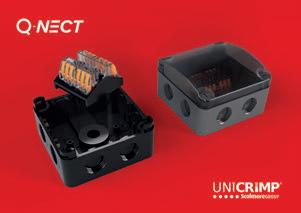
The Q-Nect IP66 junction box is designed to make installations more efficient. It can house four of the 3 Port Lever Connectors using the 360° detachable cradle and, with a curved lid, it provides additional space for wires. The lid is locked using quarter turn fasteners. The semi-transparent lids are available on the IP66 Weatherproof Enclosure that is furnished with four 3 Way Lever Connectors.
The junction box features 10 membrane entry points. Protection against moisture and dust is enhanced with the self-sealing membranes which provide a faster and more secure cable entry whilst at the same time maintaining the IP66 rating. Installers have the option of using up to eight M20 cable glands with the junction box. The M20 threaded entries with membrane ensure that the IP rating is maintained without needing to use any tools or locknuts.
Unicrimp, unicrimp.com
As we approach the warmer days and longer evenings, Ovia has a range of garden lighting products to help your clients get their outdoors summer ready.
A collection of wall lights, spike lights and bollards make up the range, ensuring all areas of the garden can benefit from a new lease of light. The majority of the range is available in cool white 4000k and warm white 3000k colour options. With warm white a very popular choice for external garden lighting schemes due to its softer light source, Ovia is experiencing high demand for this collection.
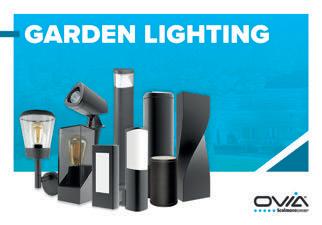
The range sits within Ovia’s Amenity Lighting category. There are multiple different wall light designs in the range including: Twist, Verta, Centuri, Orna, Quadra and Avori.
Ovia’s Amenity/Garden Lighting collection can be viewed in full on the Ovia website or by downloading the latest Ovia issue 5 catalogue.
Ovia, oviauk.com
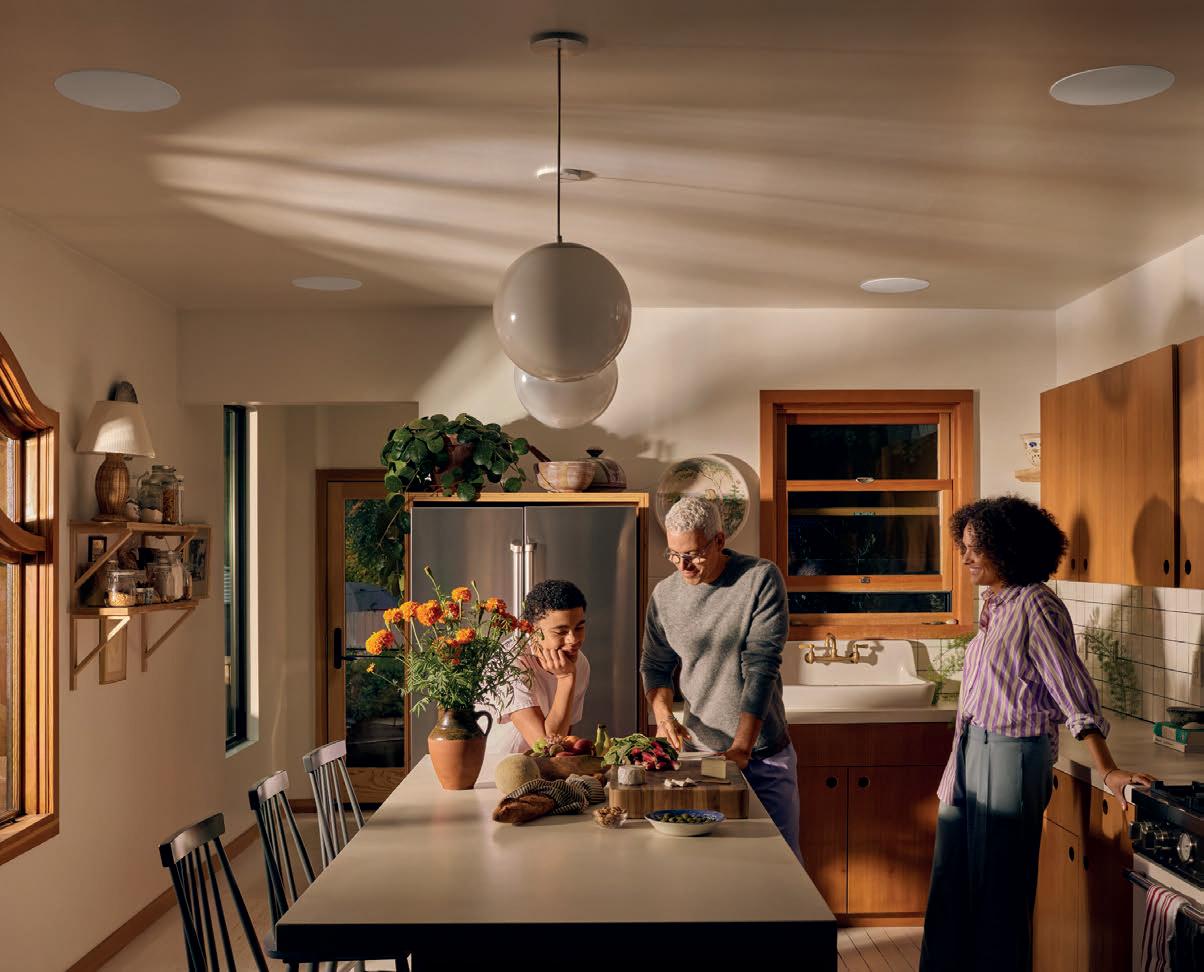
Take your listening experiences to new heights.
Take your listening experiences to new heights.
The all-new 8” ln-Ceiling Speakers by Sonos and Sonance feature completely new acoustic components, offering natural, room-filling sound with discrete installation.
The all-new 8” ln-Ceiling Speakers by Sonos and Sonance feature completely new acoustic components, offering natural, room-filling sound with discrete installation.
Pre-order now at your distributor
Pre-order now at your distributor





